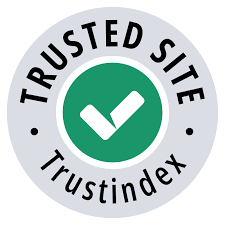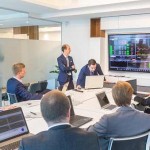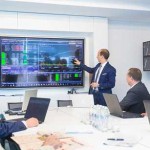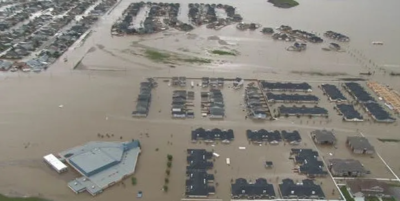Actualizing Net Zero – Workshop 1 (Objectives and KPI’s)

The Appleton Greene Corporate Training Program (CTP) for Actualizing Net Zero is provided by Mr. Chidwick Certified Learning Provider (CLP). Program Specifications: Monthly cost USD$2,500.00; Monthly Workshops 6 hours; Monthly Support 4 hours; Program Duration 12 months; Program orders subject to ongoing availability.
If you would like to view the Client Information Hub (CIH) for this program, please Click Here
Learning Provider Profile

Mr. Chidwick comes to Appleton Greene with over 25 years of energy experience in multiple industries and has hands-on experience with developing energy strategies for net zero mitigation and adaption. His engineering background, business involvement, and dedication to the green energy movement inspired him to leverage this wealth of real-world experience to develop the ‘Actualizing NetZero’ program to help other companies create energy plans appropriate for their unique circumstances.
Mr. Chidwick understands the current energy issues facing businesses. For decades, burning fossil fuels provided cheap and abundant energy that brought success to the economy and was perceived as an infinite source of low cost heat and power. Over the past decade, global climate awareness has spawned technical mandates, intertwined with ethical and financial pressures, to reduce energy consumption and carbon footprints. As a result, our economy is transitioning to a lower energy and carbon future, where most organizations are influenced by three objectives: to reduce energy costs, to reduce carbon emissions, and to provide energy security through sustainability.
Mr. Chidwick supports the effective development of your Actualizing Net Zero program, which is tailored to your specific industry and location by engaging with your workforce and data to ensure the strategy is future proof, actionable, and successful.
Mr. Chidwick combines an understanding about businesses and the energy issues facing them with real-life experience creating solutions, and provides a compelling course that adds value to any business arsenal serious about tackling the realization and actualization of affordable netzero energy.
Following a successful career as a management consultant in the energy sector developing strategies to help organizations reduce energy costs, reducing emissions and developing energy security, Mr. Chidwick has developed the ‘Actualizing NetZero’ program. This program brings together first-hand experience working in this rapidly developing industry, understanding the breadth of challenges in different regions and industries, as well as a passion for energy efficiency and carbon management.
MOST Analysis
Mission Statement
The first workshop in the “Actualizing Netzero” program leads to establishing the goals and key performance indicators that align with the imperatives of the organization. These objectives typically fall into three categories
1. Cost Reduction
2. Emissions Reduction
3. Energy Security
Participants are exposed to the fundamentals of an “Investment Grade Energy and Carbon Strategy“ (IGS) which will include the objectives, processes and organizational process changes as well as a deep analysis of all potential energy systems which clearly identifies the optimal technologies that align with the organizations goals.
Objectives
The key objective for this workshop is to define “what success looks like”. This will define the key performance indicators (KPI’s) that will be used to measure the success of the program. Objectives include
1. Define What is motivating your development of an energy and carbon strategy
2. Define the KPI’s that will measure success
3. Understand the data required to support the KPI’s
4. Understand the size of the problem (cost, emissions, energy security)
5. Understand the solution landscape
6. Understand the constraints for solutions
7. Review the process by which we will determine the best solution option
8. Review the structure of the overall Actualizing Net Zero program
9. Review the factors affecting cost reduction
10. Review the factors affecting emissions reduction
11. Explore the value and challenges for a micro-grid to address energy security
12. Understand the scope of financing models
Strategies
1. Identify objectives and key performance indicators
2. Identify and assign key roles and expectations
3. Understand the value of trustable data
4. Understand the scope and approach of the overall program
5. Review case studies for different industries to learn from the successes of others
6. Review a variety of financing models that have led to successful implementation for others
7. Learn about the Investment Grade Energy and Carbon Strategy and how it differs from an energy audit
8. Learn about the Investment Grade Energy Canvas and how this tool will help develop a bespoke plan
9. Simulate a wide-range of technologies to provide decision-makers with confidence in financing solutions
10. Establishing a trustable data management solution to improve confidence in the results
11. Understand how a suite of technologies can create synergies in a micro-grid to address the goals
12. Develop an understanding of the importance of an ecosystem of partners to ensure success
Tasks
1. Identify the objectives, constraints and KPI’s that will measure success
2. Understand what is motivating the organization and ensure the KPI’s align
3. Establish a data management system for the trusted data
4. Establish a baseline from which we can measure progress
5. Understand you existing energy contracts and the impact on costs
6. Develop a database of energy systems, their condition and energy requirements
7. Develop a database to manage the energy consumption data
8. Develop an outline for your bespoke energy and sustainability plans
9. Identify and document the constraints for an energy solution
10. Identify and document the members of an ecosystem required for the implementation
11. Ensure that all internal and external stakeholders are aligned with the objectives and the KPI’s
12. Review the financing models with the CFO to ensure they models align with corporate processes
Introduction
The Actualizing NetZero program develops the processes, governance and tools required to develop a strategy for energy and carbon emissions.
This program will develop an investment grade energy strategy (IGS) which provides comprehensive analyses that leads to actionable investment decisions. In every case, the IGS has led to the implementation of successful energy projects.
The IGS is not just another energy audit which are technical and often do not lead to implementation. Rather, the IGS translates the “techy-speak” into “CFO-speak” providing the analyses and metrics that financial decision-makers require to have confidence to make investment decisions.
An investment grade energy strategy is a comprehensive assessment of a facility’s energy usage and potential areas for improvement. This type of strategy serves as a foundation for making informed decisions regarding energy efficiency measures and on-site energy generation initiatives.
Approach
This first workshop is broken down into five major sections
1. A review of your objectives in developing an energy strategy
2. An overview of the Investment Grade Energy and Sustainability Strategy (IGS)
3. An overview of the process to build an IGS
4. A review of the constraints that will limit the strategy
5. A design of the key performance indicators that will measure success
Each of these modules will feed content into the “Investment Grade Energy and Carbon Strategy” (IGS).
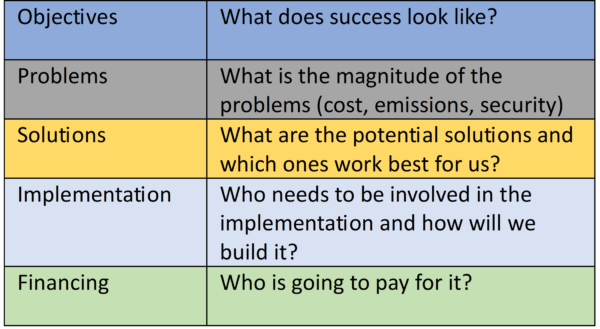
Energy and Sustainability Objectives
Participants need to have an understanding of why the organization decided to engage in this program. What is the organization seeking to achieve and why? What is motivating the organization to develop an Investment Grade Energy Strategy? What results are expected?
An energy strategy is essential for guaranteeing long-term, dependable, and affordable energy for the future. To develop an effective strategy, it’s important to establish specific goals, gain a comprehensive understanding of the issue at hand, explore various potential solutions, pinpoint any obstacles to implementation, and consider different financing options. This holistic approach guarantees the fulfillment of energy requirements while minimizing harm to the environment and fostering economic development.
In most cases, the objective fall into three categories
1. Cost Reduction
2. Emissions Reduction
3. Energy Security
Cost Reduction:
Almost always, facility operators are concerned with energy cost reduction and addressing the anticipated increases in electricity costs. Energy costs are anticipated to rise in the years to come as the world moves to cleaner energy generation. Energy costs have risen at a much higher rate than inflation and in many cases, the cost of energy for an organization is second only to labour. Given that energy costs is one of the most significant line items on the budget, executives are very interested in managing the risks associated with energy – given that the energy rates are not something that they control. As such, executives are becoming more interested in onsite generation so that they can control (to some extent) the costs for their energy.
Emissions Reduction
Many organizations are establishing their emissions reduction goals – primarily driven by customer demand. The question is how to reduce emissions affordably. Emissions break down into three sections
• Scope 1 (emissions generated in the manufacturing of the organizations product)
• Scope 2 (emissions associated with the energy that the organization consumes)
• Scope 3 (emissions related to the supply chain)
Organizations can only control scope 1 and 2 emissions. Just as the organization cannot control the cost of energy supplied by the utilities, the organization cannot control the emissions related to the energy they buy from utilities. As such, regions with a local grid with high emissions factors will significantly contribute to the scope 2 emissions. This is where renewable onsite generation, such as solar PV, can reduce dependence on the grid and reduce the scope 2 emissions.
Energy Security
In some facilities, energy security is critical. For example, a grocery store has millions of dollars of inventory in freezers and cannot tolerate long duration power failures. For example, a seniors care centre depends on quality power for life-safety equipment that cannot tolerate even the shortest power failure.
For hotel/resorts, guest expect a level of service which depends on the availability of electricity. There are “guest focused critical systems” such as lighting, air conditioning and plug loads (charging your phone). Hotel/Resorts are interested in ensuring that these “guest critical” systems are maintained for extended outages – often for several days. Other non-guest focused systems or amenities need not be included in this support.
Another example is grocery stores that have millions of dollars in inventory in coolers and freezers. Without power for more than a day, all this inventory must be destroyed.
For all industries, we have now reached a point in history where the search to find ways to improve energy efficiency must also include the reduction of costs and emissions for our commercial and institutional facilities. The first step, in this journey, is to clearly identify the energy objectives in your organization, the key performance indicators (KPI’s) that measure success, and the specific data needed to support investment decisions toward actualizing these goals.
In this first workshop, we identify the various objectives for an energy and carbon emissions solution and then review the spectrum of objectives selected for different markets and locations to trigger your thought leadership.
Overview of an Investment Grade Energy Strategy
An investment grade energy strategy (IGS) is a comprehensive assessment of a facility’s energy usage and potential areas for improvement. Unlike a basic energy audit, an investment grade audit goes beyond surface-level evaluations and provides in-depth analysis and actionable recommendations. This type of audit serves as a foundation for making informed decisions regarding energy efficiency measures and on-site energy generation initiatives.
The key components of and IGS are:
• Thorough Energy Consumption Analysis: An evaluation of historical energy usage data, utility bills, and operating schedules to identify patterns and trends.
• Detailed Facility Inspection: On-site visits to assess building systems, equipment, and operations, including HVAC systems, lighting, insulation, and controls.
• Energy Simulation and Benchmarking: Utilization of advanced software tools to simulate energy performance, compare with industry standards, and identify potential energy savings and energy generation opportunities.
• Financial Analysis: Assessment of potential energy efficiency projects, including cost estimates, payback periods, return on investment (ROI), and financing options.
• Risk Analysis: Assessment of the impact of external risk factors on the financial performance of the proposed solutions
• Recommendations and Implementation Plan: A comprehensive report outlining prioritized energy-saving measures, estimated energy and cost savings, and a roadmap for implementation.
An IGS has the following benefits
• Improved Energy Efficiency: Identifying energy inefficiencies and implementing recommended measures can lead to significant energy and cost savings over the long term. It’s always best to reduce the energy you need before implementing energy generation solutions.
• Enhanced Sustainability: By reducing energy consumption and carbon footprint, organizations can contribute to environmental stewardship and meet sustainability goals.
• Operational Optimization: Investment grade audits provide insights into optimizing building systems, improving occupant comfort, and prolonging the lifespan of equipment.
• Increased Asset Value: Energy-efficient buildings are highly valued in the market, attracting tenants, investors, and potential buyers.
• Access to Incentives and Financing: An investment grade audit helps uncover eligibility for government incentives, grants, and financing options for energy efficiency projects.
An IGS can be performed on a single facility or an entire portfolio of buildings. For example, a hotel chain may have buildings in different regions, with different weather, different energy cost structures. The decision-makers would like to determine where to invest in order to get the best return on investment.
After the energy data for a “portfolio” of buildings is provided, the IGS will simulate the financial and environmental impact for a wide-range of technologies and combinations of technologies. Each “scenario” (a set of technologies for a specific facility) will generate financial metrics such as the simple payback, NPV, IRR, as well as environmental metrics such as emissions reduction and carbon abatement rate.
IGS and Energy Audits
Energy audits provide an understanding of the building and equipment condition and makes recommendations on energy conservation measures (ECM) based on monthly data. Energy audits are primarily focused on energy conservation – which is a good place to start. These audits provide value to the building operators, but have limited value to the financial decision-makers.
There are three levels for energy audits.
• Level 1: Walkthrough
A basic walk-through examination, a review of utility bills and other pertinent operating data, and interviews with operations staff comprise the basic Level 1 audit.
• Level 2: Detailed Analysis
By include further financial analysis of suggested energy measures and more thorough energy calculations, the Level 2 audit expands upon the Level 1 examination.
• Level 3: Simulation and Energy Models
By undertaking a more thorough investigation of the building’s energy use, the Level 3 audit expands upon the findings of the Level 2 audit. Sub-metering of large energy systems is one example of this.
A level 1 audit is the least expensive but does require an energy engineer to come onsite to walk through the building. The recommendations that are generated use different spreadsheets (in most cases) to forecast the financial and environmental value for each recommended technology. This introduces uncertainty as they are not assessed in a consistent manner.
Further, depending on the organization conducting the audit, only those ECM’s with which the organization is familiar are considered – leaving out many other alternatives. Given that the market is evolving and many new solutions are introduced, these energy audits are incomplete which introduces further uncertainty.
A level 2 audit utilizes utility data to build an energy model. While this is an improvement over level 1 audits, these models often only used monthly totals (as opposed to detailed hourly or minute data) to assess the financial benefits of the recommended solutions. Building these energy models with the current software is human intensive and expensive.
A level 3 audit requires sub-meter data to dissect the buildings energy consumption to uncover the larger energy consumers and help to focus the attention of the solutions. Implementing sub-metering can be expensive. Once the data is available, it requires an experienced engineer to assess the data and determine what it means.
It should be noted that energy audits from different organizations will result in different recommendations and financial forecasts. In general, all these uncertainties are the reason why energy audits do not lead to investment decisions.
This workshop will provide an understanding of the difference between a traditional energy audit and an IGS.
Building and IGS – The IGS Journey
Throughout the overall program, we will be developing the Investment Grade Energy and Carbon Strategy using the “IGS Canvas” which pulls together all the components needed to support financial investment in an energy project.
The purpose of the canvas is to develop confidence in the decision-makers that the proposed strategy has considered all the technology options, is based on trusted data and a data driven approach. The canvas also describes the ecosystem and partners that need to be involved in the implementation to ensure success.
This workshop will review the structure of the IGS Canvas and the value to your organization.
While some modules have pre-requisites, the journey through this canvas does not need to be linear. Depending on the interests of the participants, we can move through the canvas story in different ways.
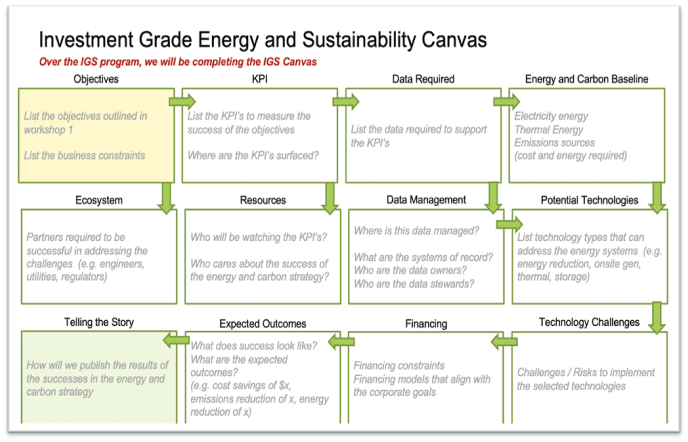
One of the most frequent complaints heard from the decision-makers is that they are inundated with possible solutions from vendors and management. This frustration leads to inertia and no action.¬
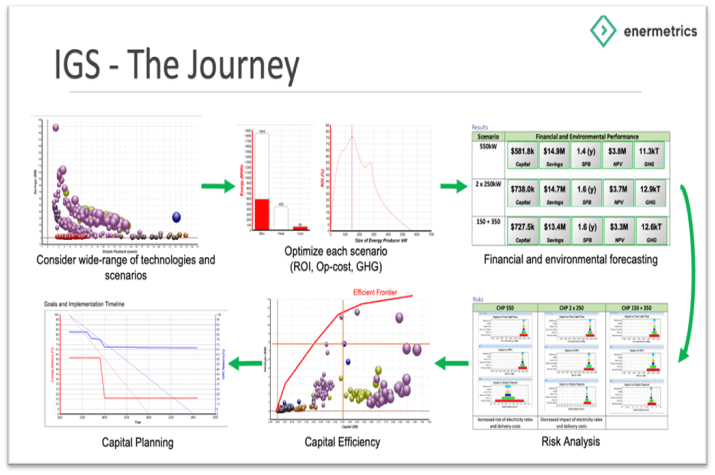
Rather, the decision-makers need to be confident that the strategy has considered all the possible solutions on the market – even those that are cost prohibitive – just so they have the confidence that all options have been explored. This confidence is a major supporting factor in an investment decision.
Confidence is a major supporting factor when making an investment decision. Decision-makers need to be confident about their strategy, and know that it has considered all possible solutions on the market – even those that are cost prohibitive. The challenge with the traditional energy audit process is it is expensive to examine a wide-range of technologies. Further, it is common that each technology is assessed with independent tools or spreadsheets making it impossible to compare the performance of the technologies. Even worse, technology vendors provide analyses that is invariably biased.
Who Should Build an Investment Grade Audit?
Investment grade audits are valuable for a range of industries that aim to optimize energy consumption and reduce costs.
Commercial Facilities: Commercial buildings, such as office complexes, retail spaces, and warehouses, can greatly benefit from investment grade audits. These audits help identify energy-saving opportunities related to lighting, HVAC systems, building envelope, and energy management controls.
Institutional Facilities: Institutions like schools, universities, hospitals, and government buildings can leverage investment grade audits to uncover energy efficiency measures tailored to their unique needs. By optimizing their energy usage, institutions can redirect funds toward educational programs, patient care, or public services.
Hotels and resorts: Energy costs for hotels can be significant especially in southern regions where air conditioning is becoming a major consumer of energy.
This workshop will review the journey as we develop the IGS strategy over the complete program.
Constraints
There are always constraints that must be considered when designing the energy strategy. These break down into physical limitations, access to financial resources, environmental concerns, technical limitations, high risk / novel technologies and politics.
These constraints include:
• Physical Constraints
Space is often a constraint, especially in urban settings.
• Financial constraints are often an issue.
Access to limited capital is a balancing act between facility maintenance and customer expectations. Invariably, the CFO needs to balance future cost savings with more immediate revenue potential when deciding on investments.
• Environmental constraints have become more prevalent over the last decade.
Not only are customers demanding more sustainable products, regulations are also demanding that organizations reduce their emissions.
• Skills Requirements
With all the technologies emerging on the market, there are newer solutions that require new skills and experience to maintain properly.
• Political Constraints
Risks are messy and can be significant as regulations change to address issues like climate change. An understanding of the political climate and the direction that regulations will take are one of the key constraints that need to be considered when designing you energy and emissions strategy.
This workshop will discuss and identify those constraints that need to be considered in the development of the energy strategy.
Key Performance Indicators
Key performance indicators to measure the success of achieving the objectives. Tracking progress towards the objectives outlined in the Investment Grade Energy and Sustainability Canvas is essential, and Key Performance Indicators (KPIs) play a crucial role in this process.
There are many objectives that can be addressed with KPI’s, including
• Energy Consumption Metrics:
• Carbon Emissions Metrics:
• Financial Metrics:
• Operational Efficiency Metrics:
• Concern for the environment and long-term viability Metrics:
This workshop will
• Identify the audience that will be monitoring the KPI’s to ensure they align with the audiences questions
• Identify the data required to support the KPI’s, and the sources for those data
This workshop will review the different styles of KPI’s and how they have been used in other industries. This workshop will also discuss those KPI’s that best address your objectives.
Information Management
Trustable information is critical for a data-driven decision-making approach. This workshop will identify the data required to support the key performance indications (KPI’s) that will measure success of the implemented solution.
Trustable data is key to the analyses and KPI’s that are the cornerstone of the Investment Grade Energy and Carbon Strategy. As such, we will include a discussion of information management, governance and process throughout each of the workshops. Participants need to understand the value of trustable data as well as the data gaps that need to be addressed.
The data management solution is required in order to establish the energy and emissions baseline. Establishing a baseline for energy consumption, emissions, and other metrics requires historical data. This baseline will act as a reference point for measuring improvements.
Establishing an energy baseline is an essential step in the Investment Grade Energy and Sustainability Canvas. The baseline serves as a benchmark for measuring progress, representing the organization’s historical energy consumption and emissions data.
Steps for Establishing an Energy Baseline:
• Collect historical energy consumption data, utility bills, and emissions records for at least one year.
• Perform data analysis to uncover patterns, seasonal variations, and the main factors influencing energy consumption and emissions.
• Baseline Development: Determine the average energy consumption and emissions during the baseline period, taking into consideration any anomalies or irregularities that may have occurred.
• Adjusting the baseline to account for changes in production levels, facility expansions, or other significant factors that could impact energy use is an important step in the normalization process.
This workshop will identify the roles and processes that are required for a “system of record” (a trusted information source for the data). This workshop will result in initiating an information technology project to develop the information management system if one does not already exist.
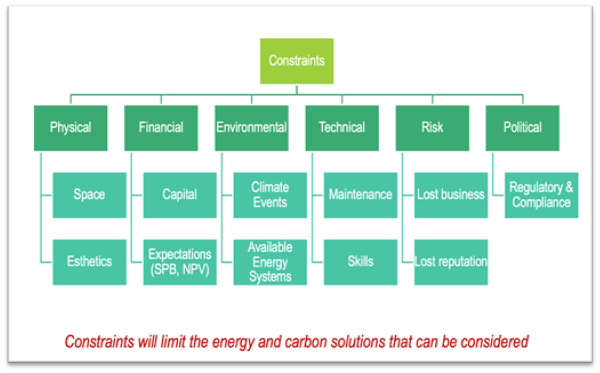
Ecosystem of Partners
Implementing the Investment Grade Energy and Sustainability Strategy necessitates working closely with a wide range of partners in order to foster collaboration. Some of the important partners are:
• Technology Providers: Companies that offer energy-efficient and renewable energy technologies.
• Energy Service Companies (ESCOs) are experts in developing, executing, and overseeing energy efficiency initiatives.
• Consultants and Advisors: Professionals who offer strategic guidance, technical expertise, and project management support.
• Utility companies are energy providers that can offer incentives, rebates, and data to support energy efficiency initiatives.
• Financial Institutions: Banks, investors, and funding agencies that offer financing for sustainability projects.
• Government Agencies: Regulatory bodies and public agencies that provide grants, subsidies, and regulatory support.
• Non-Governmental Organizations (NGOs): Organizations that promote sustainability and offer resources and support.
• Industry Associations: Organizations that represent specific industries and promote knowledge sharing and collaboration.
Financing
Finally, the results of all the scenarios can be brought together in a series analyses demonstrate the capital efficiency, financial and sustainability effectiveness which help to assess the financing models, ranging from internally financed, bank financed, utility financed or performance contracts. These analyses are very effective at contrasting the financial and environmental benefits of the scenarios considered and makes it very obvious to the decision-maker that the proposed scenario is in fact the best one. This builds confidence for the decision-maker.
Securing financing is crucial for the successful implementation of energy and sustainability projects. There are various financing models that can be used:
• Utilizing internal funds and reinvesting cost savings from energy efficiency projects to support itself financially.
• Energy Performance Contracts (EPCs) involve agreements with ESCOs, where the costs of the project are covered by the energy savings that are achieved.
• Power Purchase Agreements (PPAs) are contracts that allow for the purchase of renewable energy from a provider at a set price, typically without any initial expenses.
• Issuing bonds specifically for funding environmentally sustainable projects is a common practice in the financial industry.
• Exploring grants and subsidies: Accessing financial assistance from government programs and incentives.
• Private Investments: Drawing in investments from private sector partners, such as venture capital and private equity.
• Leasing equipment or technology allows for spreading the costs over time, which helps to minimize the need for upfront capital.

Case Study: Hotels in the Caribbean
Hotel / Resorts in the Caribbean consume most of their energy in air conditioning and hot water heating. An example of the energy consumption for a hotel in the Caribbean that had sub-metering demonstrates that 37% of the electricity is used for air conditioning. Other hotels report over 50% of the electricity is used for cooling.
Building equipment includes pumps for moving water and fans for moving air. This accounts for 10-20% of the electricity for many hotels.
Combined, air conditioning, hot water heating and building equipment accounts for 73% of the electricity consumed. Clearly these are areas on which to focus for energy savings.
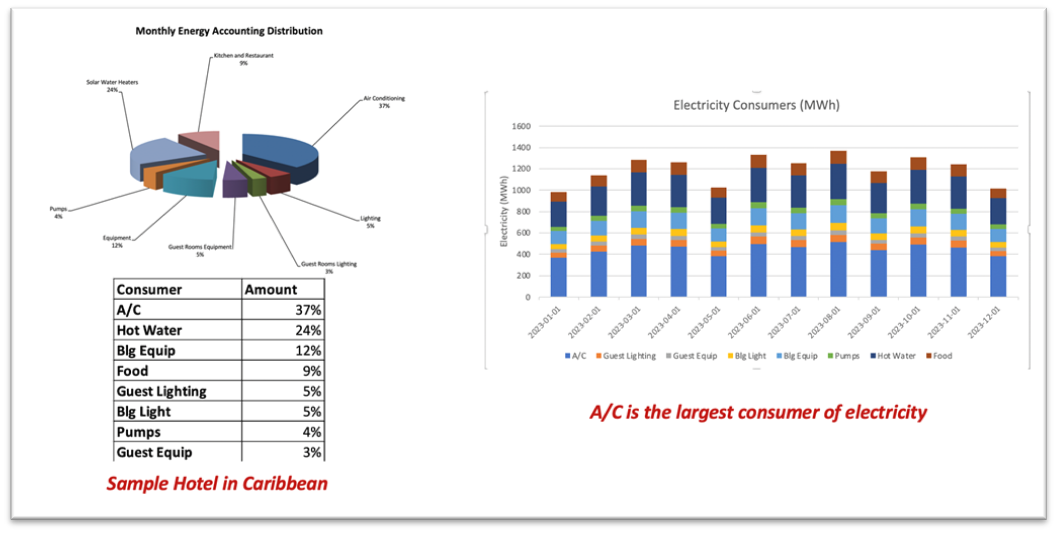
To achieve energy reduction for air conditioning, the resort implemented smart air conditioning sensors. Given that guests are in the room only 40% of the time, there is an opportunity to reduce A/C when the room is not occupied. Infrared sensors identify a person is in the room and releases the thermostat for guest control. A minimum set point enabled by BMS to prevent guests from setting the temperature too low. When the guest leaves the room, the system waits for N minutes, at which time the system updates the set point to unoccupied setting. The can result in a 40% reduction in A/C energy depending on the temperature delta between the outside air and the internal comfort settings.
In the energy modelling, the room is assumed to be occupied from 10pm to 9am on average. If the outdoor air temperature is over 27C, then we assume we can achieve a 40% reduction in energy. But if the outdoor air temperature is between 24 and 27, then we drop the energy savings to 25%. And if the outdoor air temperature is below 24, then we assume no reduction in AC energy.
The resulting savings in energy are shown below. The grey line shows the electricity consumption without smart air conditioning. The red line shows the energy consumption with smart air conditioning.
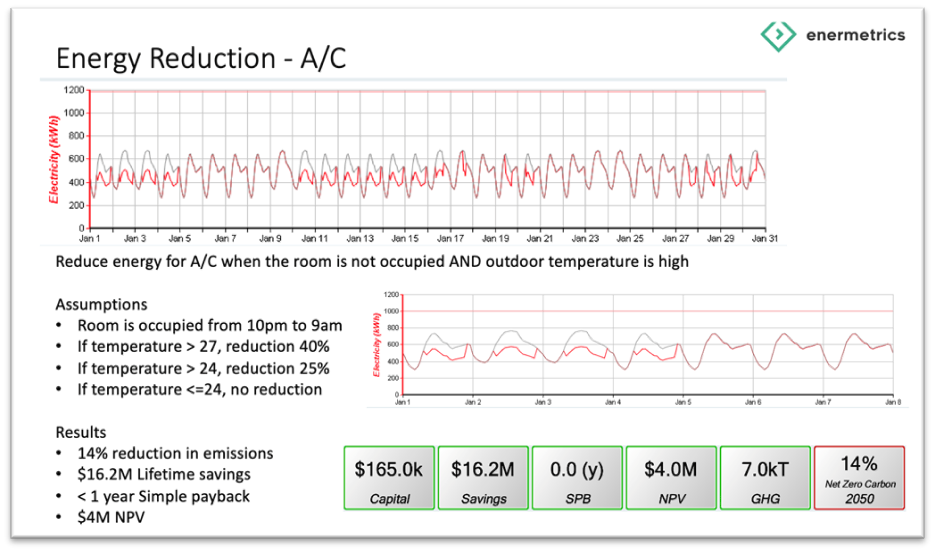
This resulted in energy reduction of 30% on average over a 12 month period. With a modest investment of $165,000 for 240 room resort, this resulted in a lifetime savings of over $16M (25 years) and a very strong NPV of $4M.
Building on this energy reduction, the resort was interested in a micro-grid to supply onsite energy to further reduce energy costs, emissions and most importantly provide energy security.
Solar PV was also available on a parking lot roof. A 550kW array also provided very strong financial returns as well as further reducing emissions by 11%.

Perhaps the most significant emissions reduction is a bio-digested combined with a Combined Heat and Power (CHP). The food waste from the restaurants can be fed into a small bio-digested to create bio-gas. The bio-gas is burned in the CHP to provide heat and power for the hotel. This resulted in a significant emissions reduction (given that the bio-gas is considered to be emissions free fuel).

Combining these technologies in a micro-grid, the hotel can achieve over a 70% reduction in emissions which still demonstrating a very strong NPV and simple payback

Executive Summary
Chapter 1: Objectives and KPI’s
What is motivating your development of an energy and carbon strategy?
In the first course manual, we identify the various objectives for an energy and carbon emissions solution and then review the spectrum of objectives selected for different markets and locations to trigger your thought leadership.
Each organization has unique objectives and constraints based on the associated participants and geographic location. For example, the hotel industry is highly sensitive to guest comfort and cannot tolerate failures in their power and heat systems. However, hotels in the Caribbean have very different energy advantages and constraints than hotels located in the United States.
For all industries, we have now reached a point in history where the search to find ways to improve energy efficiency must also include the reduction of costs and emissions for our commercial and institutional facilities. The first step, in this journey, is to clearly identify the energy objectives in your organization, the key performance indicators (KPI’s) that measure success, and the specific data needed to support investment decisions toward actualizing these goals.
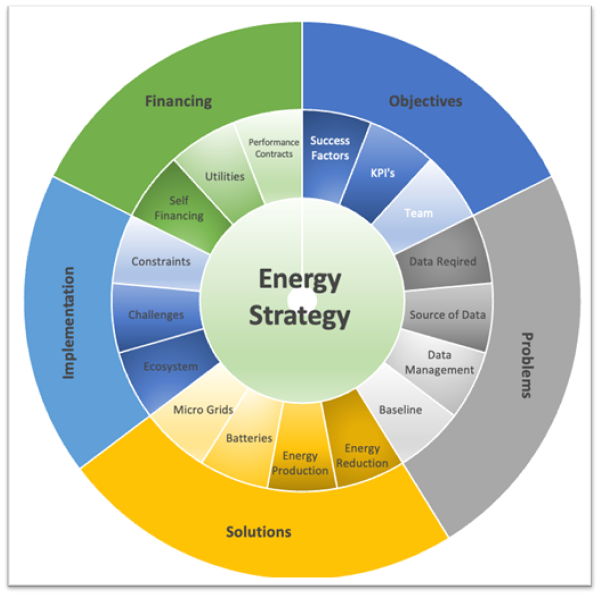
Objectives
The objectives section will discuss issues that your organization would like to achieve. These might include energy efficiency, energy cost reduction, emissions reduction and energy security. Participants should be familiar with the reasons the organization is developing an energy strategy.
Data
In parallel with each of the course manuals, we must pay close attention to data, the sources, processes and governance. Trustable data is key to the analyses and KPI’s that are the cornerstone of the Investment Grade Energy and Carbon Strategy. As such, we will include a discussion of information management, governance and process throughout each of the course manuals. Participants need to understand the value of trustable data as well as the data gaps that need to be addressed.
Problems
Having a clear grasp of the magnitude of the issue is crucial when developing a successful energy plan. Examining current energy consumption patterns and the associated emissions is part of the process. Participants should be familiar with where the organization is consuming energy and the condition of the energy systems.
Solution Landscape
The array of solutions to tackle energy challenges is extensive and constantly changing. Understanding the various technologies and strategies that can be employed is crucial in navigating this landscape. This will include a brief overview of the different types of technologies on the market.
Implementation
There are various obstacles to implementing a successful energy and carbon emissions strategy, including regulatory, political, financial and physical constraints. Participants are encouraged to bring forward their experiences in developing energy projects in the past.
Financing
Mobilizing substantial financial resources from various sources is crucial for financing the transition to a low-carbon economy. This encompasses various sources of funding, including public funding, private investments, and innovative financing mechanisms.

Case Study: Hotel in Caribbean
The electricity rates for a Caribbean hotel ranged from $0.55/kWh in 2022 to $0.29/kWh in 2024. The largest energy consumer is the need for air conditioning (40-60% of electricity consumed) which is required in every month.
The hospitality sector in the Caribbean is acutely aware of the impact of climate change with storms increasing in frequency and intensity. As such, most Caribbean nations have strong emissions reduction goals.
The IGS considered a wide range of technologies to find combinations that reduced both the energy cost as well as the emissions. This resulted in identifying:
• Intelligent air conditioning for the guest suites
• Solar PV
• Bio-digester and CHP
The Intelligent air conditioning recognizes that guests are only in their rooms 40% of the time. Sensors determine when a human is not present and resets the thermostat to a higher temperature. When the human returns, the thermostat is returned to human control and the room cools down in only a few minutes.
The financial savings for this technology are very compelling. The project cost of $165k has a simple payback of less than one year, and a very strong NPV as well as reducing emissions by 14%.

Solar PV was also available on a parking lot roof. A 550kW array also provided very strong financial returns as well as further reducing emissions by 11%.

Perhaps the most significant emissions reduction is a bio-digested combined with a CHP. The food waste from the restaurants can be fed into a small bio-digested to create bio-gas. The bio-gas is burned in the CHP to provide heat and power for the hotel. This resulted in a significant emissions reduction (given that the bio-gas is considered to be emissions free fuel).

Combining these technologies, the hotel can achieve over a 70% reduction in emissions which still demonstrating a very strong NPV and simple payback


Chapter 2: Investment Grade Strategy
The political reality in most countries is oriented toward energy and carbon reduction to address environmental challenges. While industry underpins the economy, it also has a significant influence on the environment that runs counter to our political and environmental commitments. The ‘Energy and Sustainability Strategy’ program addresses the needs of industry to play a significant role in attaining our climate change initiatives.
Whether driven by social pressures, or by a need to manage expected increases in energy costs, most organizations are now paying much more attention to their energy consumption and emissions. We expect that the cost for electricity will increase substantially in the decades to come as the grids decarbonize. While affordability is the biggest concern, cost certainty is a key concern for facility operators.
Facility operators are challenged with competing objectives including:
• Energy cost and cost certainty
• Energy security
• Emissions reduction and brand management
• Energy systems modernization and deferred maintenance
• Understanding the technology landscape – Just where do I start?
• Developing an Energy and Carbon Strategy
• Financing projects – Translating the technical plans to “CFO Speak”
• Case Studies: What can we learn from others?
The ‘Actualizing NetZero’ program addresses the global movement toward a more energy sustainable future, and helps businesses develop ways to improve energy efficiency, reduce costs, reduce emissions, and provide energy security for industrial, commercial, and institutional facilities.
Some organizations have completed energy audits which often did not lead to implementations. Energy audits provide an understanding of the building and equipment condition and makes recommendations on energy conservation measures (ECM) based on monthly data. Energy audits are primarily focused on energy conservation – which is a good place to start. These audits provide value to the building operators, but have limited value to the financial decision-makers. We will explore the difference between an energy audit and an Investment Grade Energy Strategy and why the IGS process works better.
An investment grade energy plan provides decision-makers with all the materials needed to support a financial investment in an energy project. In the past, organizations have started with an “Energy Audit” to get an understanding of the current state of the building systems and to identify options for reducing energy consumption. However, these energy audits rarely lead to investments in energy projects. The reason for this is that energy audits provide a technical view on the problem and don’t translate well to the needs of the decision-makers for investments. This is where the “Investment Grade Energy and Carbon Strategy” comes in.
Our experience in multiple industries has revealed that the development of these Investment Grade Energy and Carbon Strategies (IGS) has accelerated the investment into energy solutions. In every case, the IGS resulted in a successful project implementation.
The key reason for the success of the IGS is that we translate “techy-speak” into “CFO-speak” by providing analyses and graphics that clarify the value of investment decisions.

Chapter 3: IGS Overview
The Investment Grade Energy and Carbon Strategy (IGS) addresses the challenges introduced by a traditional energy audit – and provides a focus on the analyses that speak to the financial decision-makers. The objective of an IGS is to accelerate the investments into energy projects.
The factors that impact the investment decision include:
● Confidence that all technology options have been considered
● Confidence that all scenarios that stack / combine technologies have been considered
● Confidence that each scenario is using consistent forecasting assumptions
● An assessment of the external risk factors that will impact the financial results
● KPI’s that speak to the financial decision-maker
● Clear understanding on why one scenario is better than another scenario
The IGA addresses these factors by:
● Considering a wide-range of technologies – ECM’s as well as onsite generation
● Focused on identifying those projects that maximize value for investment
● Providing detailed financial, risk analysis, capital planning
● Value to the business executive / investment decision-makers
● Assessing each scenario with consistent assumptions on the financial and environmental factors

The key components of an IGS are:
• Thorough Energy Consumption Analysis: An evaluation of historical energy usage data, utility bills, and operating schedules to identify patterns and trends.
• Detailed Facility Inspection: On-site visits to assess building systems, equipment, and operations, including HVAC systems, lighting, insulation, and controls.
• Energy Simulation and Benchmarking: Utilization of advanced software tools to simulate energy performance, compare with industry standards, and identify potential energy savings and energy generation opportunities.
• Financial Analysis: Assessment of potential energy efficiency projects, including cost estimates, payback periods, return on investment (ROI), and financing options.
• Risk Analysis: Assessment of the impact of external risk factors on the financial performance of the proposed solutions
• Recommendations and Implementation Plan: A comprehensive report outlining prioritized energy-saving measures, estimated energy and cost savings, and a roadmap for implementation.
An IGS has the following benefits
• Improved Energy Efficiency: Identifying energy inefficiencies and implementing recommended measures can lead to significant energy and cost savings over the long term. It’s always best to reduce the energy you need before implementing energy generation solutions.
• Enhanced Sustainability: By reducing energy consumption and carbon footprint, organizations can contribute to environmental stewardship and meet sustainability goals.
• Operational Optimization: Investment grade audits provide insights into optimizing building systems, improving occupant comfort, and prolonging the lifespan of equipment.
• Increased Asset Value: Energy-efficient buildings are highly valued in the market, attracting tenants, investors, and potential buyers.
• Access to Incentives and Financing: An investment grade audit helps uncover eligibility for government incentives, grants, and financing options for energy efficiency projects.
Participants will learn more about the process for an Investment Grade Energy and Sustainability Strategy – which will form the basis for this program.

Chapter 4: IGS Canvas
Throughout the program, we develop the Investment Grade Energy and Carbon Strategy using the “IGS Canvas” which pulls together all the components needed to support financial investment in an energy project.
While some modules have pre-requisites, the journey through this canvas does not need to be linear. Depending on the interests of the participants, we can move through the canvas story in different ways.
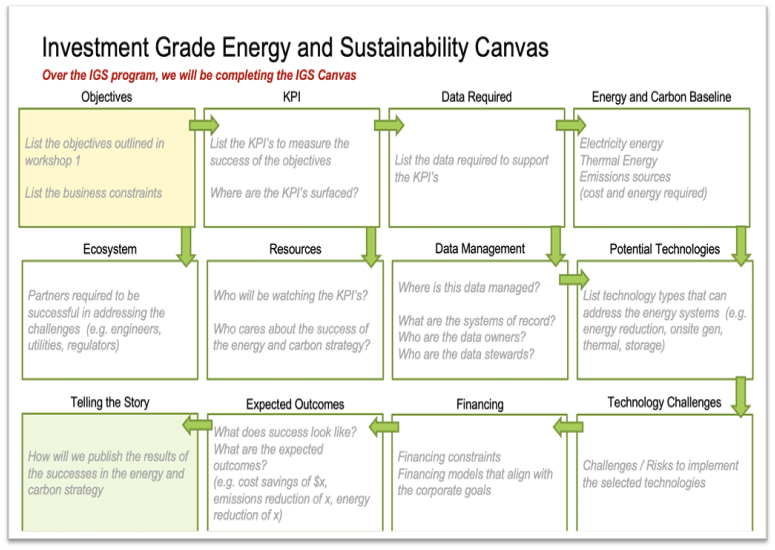
An ‘Actualizing NetZero’ is very different from a more familiar Energy Audit process. As such, it is important that we walk through the journey at a high level and examine a case study as an example.
The key value in an IGS is that it translates “techy-speak” to “CFO-speak”. The audience for the results of an IGS are the financial decision-makers (normally the executive and CFO). While the development of the IGS requires input and acceptance from the facility managers and engineers, the analyses included in the IGS are very much focused on the needs of the decision-makers.
A frequent complaint heard from decision-makers is that they are inundated with possible solutions from vendors and management. The resulting frustration leads to inertia and no action.
Confidence is a major supporting factor when making an investment decision. Decision-makers need to be confident about their strategy, and know that it has considered all possible solutions on the market – even those that are cost prohibitive. The challenge with the traditional energy audit process is it is expensive to examine a wide-range of technologies. Further, it is common that each technology is assessed with independent tools or spreadsheets making it impossible to compare the performance of the technologies. Even worse, technology vendors provide analyses that is invariably biased.
What is required is a technology that independently and consistently assesses each of the technologies so that the results can be compared and the right solutions identified. The IGS process provides such an independent and consistent simulation technology.
Participants will learn more about the IGS canvas. Throughout this program, we will be addressing each of the components on this canvas in filling out the Investment Grade Energy and Sustainability Strategy.

Chapter 5: Goals and Constraints
Each organization may have different goals and almost always has constraints that need to be considered in the energy strategy. In this course manual, we will identify the key goals which often break down into three categories
1. Cost reduction and/or cost certainty
2. Emissions reduction
3. Energy security
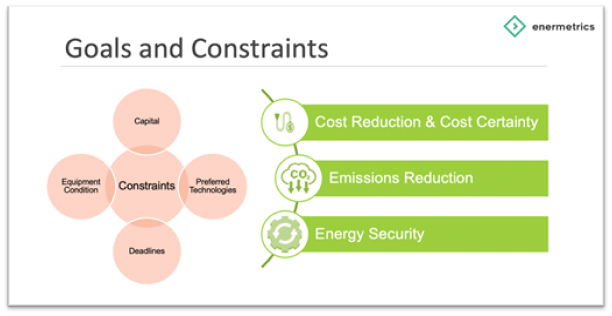
Almost always, facility operators are concerned with energy cost reduction and addressing the anticipated increases in electricity costs. Energy costs are anticipated to rise in the years to come as the world moves to cleaner energy generation. Energy costs have risen at a much higher rate than inflation and in many cases, the cost of energy for an organization is second only to labour. Given that energy costs is one of the most significant line items on the budget, executives are very interested in managing the risks associated with energy – given that the energy rates are not something that they control. As such, executives are becoming more interested in onsite generation so that they can control (to some extent) the costs for their energy.
Many organizations are establishing their emissions reduction goals – primarily driven by customer demand. The question is how to reduce emissions affordably. Emissions break down into three sections
• Scope 1 (emissions generated in the manufacturing of the organizations product)
• Scope 2 (emissions associated with the energy that the organization consumes)
• Scope 3 (emissions related to the supply chain)
Organizations can only control scope 1 and 2 emissions. Just as the organization cannot control the cost of energy supplied by the utilities, the organization cannot control the emissions related to the energy they buy from utilities. As such, regions with a local grid with high emissions factors will significantly contribute to the scope 2 emissions. This is where renewable onsite generation, such as solar PV, can reduce dependence on the grid and reduce the scope 2 emissions.
In some facilities, energy security is critical. For example, a grocery store has millions of dollars of inventory in freezers and cannot tolerate long duration power failures. For example, a seniors care centre depends on quality power for life-safety equipment that cannot tolerate even the shortest power failure.
There are always constraints that must be considered when designing the energy strategy. These break down into physical limitations, access to financial resources, environmental concerns, technical limitations, high risk / novel technologies and politics.
This course manual will discuss and identify those constraints that need to be considered in the development of the energy strategy.
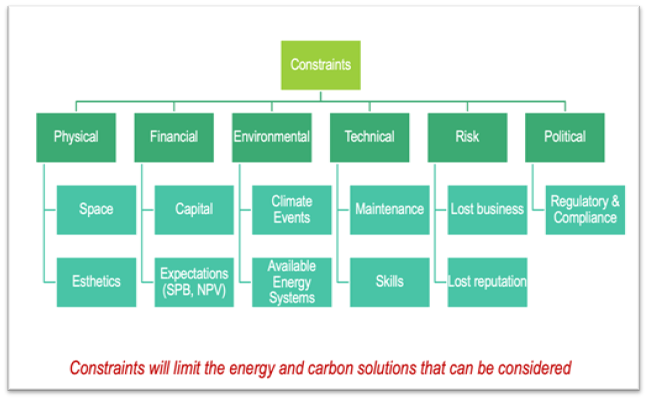
Participants are encouraged to be prepared to discuss past energy projects, why they succeeded or failed and the constraints that they had to address.

Chapter 6: Cost Reduction Goal
Cost reduction is a key objective in developing an energy strategy. Energy costs are anticipated to rise no matter where you are located. In some industries, energy costs are the largest cost item behind labour and have significant impacts on the businesses profitability.
There are two ways to reduce energy costs
1. Reduce grid energy consumption
2. Change rate structure / the cost of energy
Reducing the energy you purchase from the grid is always the best way to reduce costs. Energy reduction can take two forms
• Reduce the energy required for the facility
• Generate energy onsite at a lower cost than the grid
We will explore different solutions to reduce energy (always the first step) as well as generating onsite power to make up the balance.
In some regions as shown below, the cost of energy is deregulated and varies hour by hour, which makes budgeting for energy costs very challenging. In these cases, cost certainty may be more important than lowest cost.
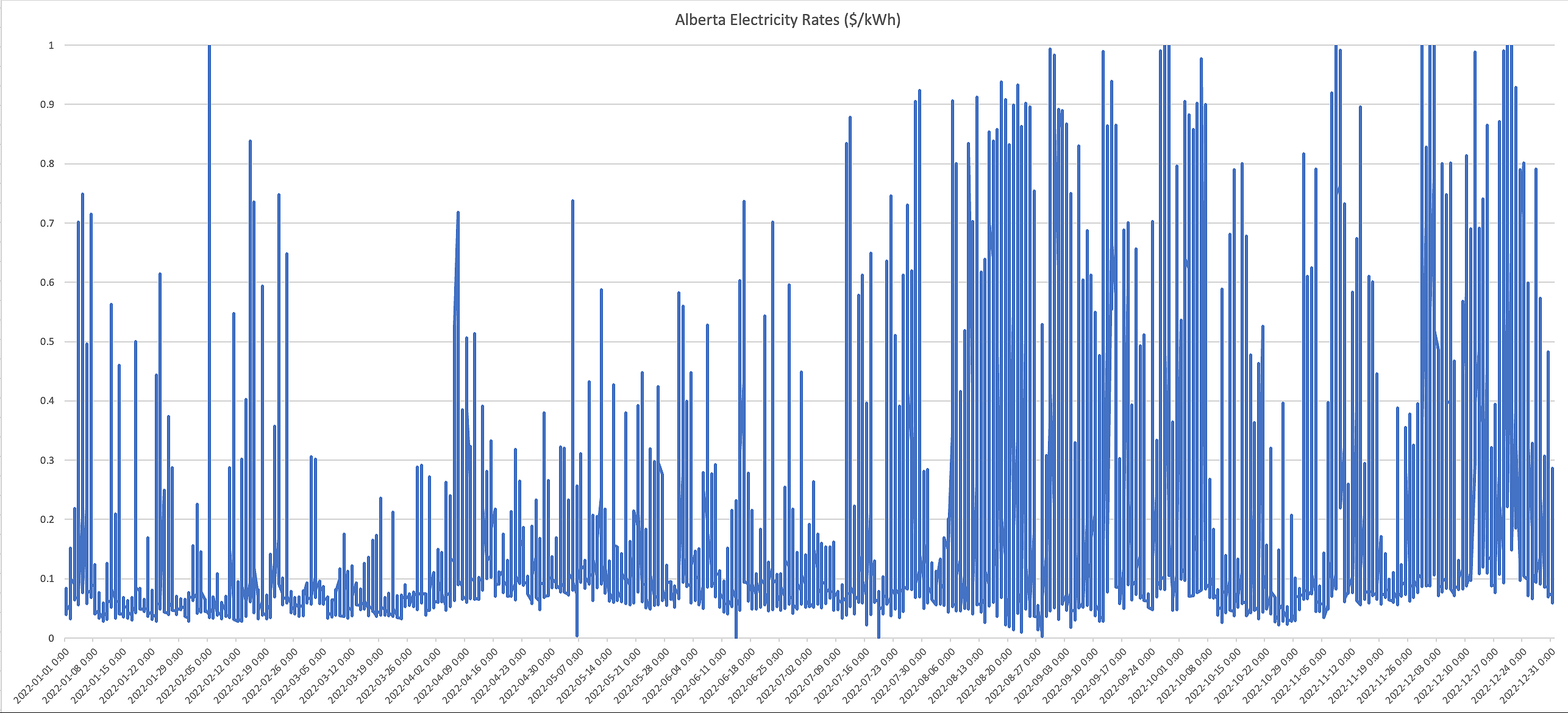
Participants need to be prepared to discuss their energy costs and the factors that more significantly impact the energy costs. Although these will be reviewed in greater detail in future workshops, it is instructive to understand the dynamics of the current energy cost structure.

Chapter 7: Emissions Reduction Goal
Emissions reduction used to be a “nice to have” benefit but has now become a critical component in a business energy strategy. Businesses with a sustainability record are recognized as more valued by their customers. For example, hotels and resorts have seen the greatest success with a 50% increase in bookings when they can demonstrate their sustainability successes. Post-secondary institutions started out well by being the first industry, all over the world, to publish their net zero goals and commitments; unfortunately, they failed to develop a plan on how to achieve their objectives. Industrial clients have been slower to move toward emissions reduction, as their operations are very complex, but executives recognize the need to start a transition for their industry to survive.
Addressing emissions, especially greenhouse gases like carbon dioxide, methane, and nitrous oxide, is crucial for combating climate change and enhancing air quality. These are some of the most influential emissions reduction technologies:
• CCUS technologies are capable of capturing CO2 emissions from various sources such as industrial facilities, power plants, and even directly from the atmosphere.
• Renewable energy technologies, such as solar, wind, hydro, and geothermal, have the advantage of producing electricity without emitting greenhouse gases.
• Improving Energy Efficiency: Boosting energy efficiency in buildings, industrial processes, and transportation helps to decrease overall energy demand and, as a result, reduces emissions.
• Hydrogen fuel cells (and solid oxide fuel cells) generate electricity and heat by harnessing the power of a chemical reaction between hydrogen and oxygen.
• Bioenergy and Biofuels: Energy can be generated from organic materials, like plant and animal waste.
• Waste-to-Energy Technologies: Waste-to-energy (WTE) technologies transform municipal solid waste and industrial waste into energy using methods such as incineration, gasification, and anaerobic digestion.
• Carbon offsetting is a method of compensating for emissions by investing in projects that reduce or remove CO2 from the atmosphere.
• Smart grids improve the efficiency and reliability of electricity distribution through the integration of digital communication technologies.
We will review some examples of facilities which were able to identify a set of technologies for their micro-grid which both reduced costs and emissions.

Example of Results for a facility focused at emissions reduction
Participants are encouraged to discuss the importance of emissions reduction for the business.

Chapter 8: Energy Security Goal
Energy security is critical to some organizations and a ‘nice-to-have’ in others. For example, hospitals cannot tolerate failures in their power grid, as lives depend on the equipment. Senior care facilities are also sensitive to failures in power and heat, which provide the requirements of life for their tenants. Grocery stores can lose millions of dollars in inventory when refrigeration systems fail.
Hotels and resorts depend on guest comfort to establish their reputation, which is critical for long-term success; therefore, outages in power or heat cost much more than the physical repair requirements.
Energy security is often addressed by implementing a micro-grid which manages the onsite distributed energy resources (DER), electricity storage and loads. The micro-grid controller uses weather forecasts and historical energy consumption patterns to determine whether to maximize the energy in storage to prepare for an outage.
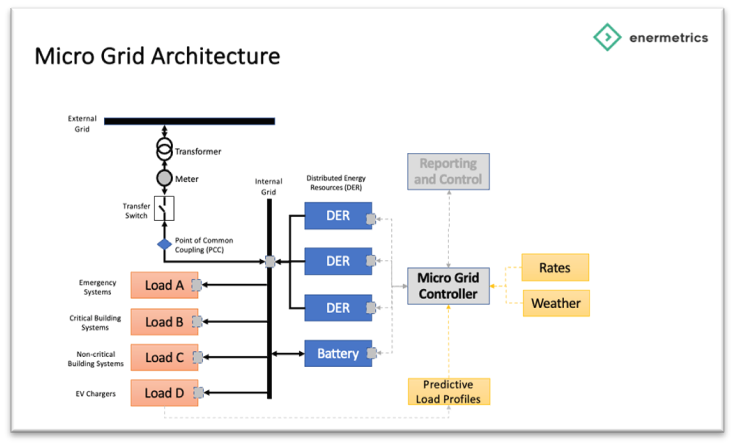
We will explore the advantages of onsite electricity storage with a variety of different types of batteries.
Participants are encouraged to be prepared to discuss the importance of energy security for your business, and the impact on the business if energy was not available.

Chapter 9: Objectives Ranking
After discussing and identifying the cost, emissions and security objectives, we will rank the objectives and set the targets and dates. For example:
• Achieve a simple payback of less than 5 years and a positive NPV
• reduce our energy costs by 20% in two years
• reduce our emissions by 50% in three years
• ensure that our “critical systems” have sufficient backup power to operate for 24 hours
Each of these objectives will require a key performance indicator (KPI) which is addressed in chapter 11.
Ranking the objectives is important as some of the objectives may be conflicting. For example, an emissions reduction objective may in some cases increase the energy cost.
Given the cost, emissions and energy security objectives identified in previous chapters, we need to rank these objectives to determine where the focus should be for the energy strategy.
There is a temptation to rank everything as important. Indeed, each of the three main business objectives are important (cost reduction, emissions reduction and energy security). However, trying to do everything will lead to doing nothing as the problem seems intractable.
Business decision-makers will resist investments in energy projects if the objectives appear to be unfocused. Therefore it’s important to rank the relative importance of the business objectives to drive the strategy to a solution that is focused and achievable.
Participants are encouraged to consider each of the stakeholder groups and their objectives. What is important to these groups and how will an energy project address their concerns?

Chapter 10: Who Cares?
When we are designing the KPI’s, we need to consider who will be monitoring them and understand their motivations. Understanding the different stakeholders in the project ecosystem will help to understand how the KPI’s will be used which will help to ensure that the KPI’s are appropriate.
Energy projects involve various stakeholders and require collaboration and support from different parties. These stakeholders can be broadly classified into internal and external groups, each with their own unique interests, responsibilities, and expertise. Having a clear understanding of and effectively managing these stakeholders is absolutely essential for the successful implementation and operation of energy projects.
• Internal
– Project sponsor, Property manager, energy manager, building operators, building owners
• External
– Utilities, politicians, technology vendors, engineers
Each of these groups will be interested in different KPI’s. The energy strategy needs to consider how each of these participants in the ecosystem will measure success in the project.
Stakeholder engagement plays a crucial role in ensuring the success of energy projects. Participants will review some engagement strategies for each of these stakeholder groups.

Chapter 11: KPI Design
Now that we have identified the objectives and the stakeholder community, we can design the key performance indicators that will demonstrate success of the project in different ways.
The KPI’s will determine the data required to support the metrics which will lead to a discussion on the data gaps, meters and sensors required and a data management system of record.
The information technology (IT) team will be engaged to develop an IT project to expose these meters both internally and externally as appropriate.
KPI’s are often surfaced in dashboards. These dashboards are focused at the different stakeholder communities and “tell a story”. The story for internal operators and management is different than the story for external stakeholders such as customers. This chapter will explore the different stories that need to be told.
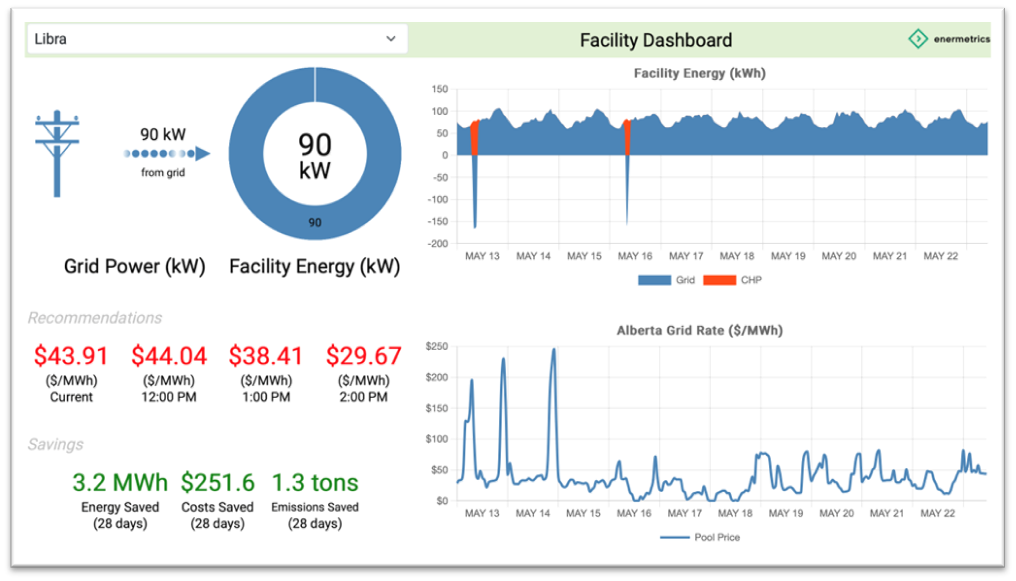
Participants will review the principals when designing the KPI’s and how they are surfaced to the stakeholder community. Participants will also review different styles of KPI’s, ranging from real-time KPI’s to infographics and where they are best applied.

Chapter 12: Risk KPI’s
Risk KPI’s are the most difficult to quantify. These measure how different external risk factors will impact the normal business operations. If these risk KPI’s are increasing, an adaptation or mitigation plan may be required. If these risk factors are decreasing, does it mean we can adjust capital projects that were planned to address these factors?
A corporation can use a risk management plan to prepare for a variety of scenarios that could arise. Through the prevention or management of risks that may or may not materialize, risk management can assist a business in preserving its success or improving its operations. You may measure some components of risk with key performance indicators to see if your risk management plan is working.
Key performance indicators, or KPIs, are measures used in risk management that evaluate business hazards. KPIs assess the essential components of a business that it requires in order to successfully accomplish its goals. Their main job is to keep an eye on business plans and operations and assess how well they’re working so you can judge how successful and efficient they are. Key performance indicators are metrics that a corporation can create to measure success, enhance performance, and direct decision-making.
Examples of external risk factors depend on location and type of business, but may include:
• Fire
• Flood
• High temperatures
• Storms
• Drought
Data to support these risk KPI’s is difficult to access, but there are consultancies that publish current state and future outlook for a variety of factors. The story that these KPI’s tell are more relevant to facility owners, insurance companies and property managers. Do we have sufficient mitigation plans for those risks that are significant and increasing?
Participants will review the different business risk factors, discuss mitigation strategies which will then identify KPI’s that can monitor the status of these risk factors.
Curriculum
Actualizing Net Zero – Workshop 1 – Objectives and KPI’s
- Objectives and KPI’s
- Investment Grade Strategy
- IGS Overview
- IGS Canvas
- Goals and Constraints
- Cost Reduction Goal
- Emissions Reduction Goal
- Energy Security Goal
- Objectives Ranking
- Who Cares?
- KPI Design
- Risk KPI’s
Distance Learning
Introduction
Welcome to Appleton Greene and thank you for enrolling on the Actualizing Net Zero corporate training program. You will be learning through our unique facilitation via distance-learning method, which will enable you to practically implement everything that you learn academically. The methods and materials used in your program have been designed and developed to ensure that you derive the maximum benefits and enjoyment possible. We hope that you find the program challenging and fun to do. However, if you have never been a distance-learner before, you may be experiencing some trepidation at the task before you. So we will get you started by giving you some basic information and guidance on how you can make the best use of the modules, how you should manage the materials and what you should be doing as you work through them. This guide is designed to point you in the right direction and help you to become an effective distance-learner. Take a few hours or so to study this guide and your guide to tutorial support for students, while making notes, before you start to study in earnest.
Study environment
You will need to locate a quiet and private place to study, preferably a room where you can easily be isolated from external disturbances or distractions. Make sure the room is well-lit and incorporates a relaxed, pleasant feel. If you can spoil yourself within your study environment, you will have much more of a chance to ensure that you are always in the right frame of mind when you do devote time to study. For example, a nice fire, the ability to play soft soothing background music, soft but effective lighting, perhaps a nice view if possible and a good size desk with a comfortable chair. Make sure that your family know when you are studying and understand your study rules. Your study environment is very important. The ideal situation, if at all possible, is to have a separate study, which can be devoted to you. If this is not possible then you will need to pay a lot more attention to developing and managing your study schedule, because it will affect other people as well as yourself. The better your study environment, the more productive you will be.
Study tools & rules
Try and make sure that your study tools are sufficient and in good working order. You will need to have access to a computer, scanner and printer, with access to the internet. You will need a very comfortable chair, which supports your lower back, and you will need a good filing system. It can be very frustrating if you are spending valuable study time trying to fix study tools that are unreliable, or unsuitable for the task. Make sure that your study tools are up to date. You will also need to consider some study rules. Some of these rules will apply to you and will be intended to help you to be more disciplined about when and how you study. This distance-learning guide will help you and after you have read it you can put some thought into what your study rules should be. You will also need to negotiate some study rules for your family, friends or anyone who lives with you. They too will need to be disciplined in order to ensure that they can support you while you study. It is important to ensure that your family and friends are an integral part of your study team. Having their support and encouragement can prove to be a crucial contribution to your successful completion of the program. Involve them in as much as you can.
Successful distance-learning
Distance-learners are freed from the necessity of attending regular classes or workshops, since they can study in their own way, at their own pace and for their own purposes. But unlike traditional internal training courses, it is the student’s responsibility, with a distance-learning program, to ensure that they manage their own study contribution. This requires strong self-discipline and self-motivation skills and there must be a clear will to succeed. Those students who are used to managing themselves, are good at managing others and who enjoy working in isolation, are more likely to be good distance-learners. It is also important to be aware of the main reasons why you are studying and of the main objectives that you are hoping to achieve as a result. You will need to remind yourself of these objectives at times when you need to motivate yourself. Never lose sight of your long-term goals and your short-term objectives. There is nobody available here to pamper you, or to look after you, or to spoon-feed you with information, so you will need to find ways to encourage and appreciate yourself while you are studying. Make sure that you chart your study progress, so that you can be sure of your achievements and re-evaluate your goals and objectives regularly.
Self-assessment
Appleton Greene training programs are in all cases post-graduate programs. Consequently, you should already have obtained a business-related degree and be an experienced learner. You should therefore already be aware of your study strengths and weaknesses. For example, which time of the day are you at your most productive? Are you a lark or an owl? What study methods do you respond to the most? Are you a consistent learner? How do you discipline yourself? How do you ensure that you enjoy yourself while studying? It is important to understand yourself as a learner and so some self-assessment early on will be necessary if you are to apply yourself correctly. Perform a SWOT analysis on yourself as a student. List your internal strengths and weaknesses as a student and your external opportunities and threats. This will help you later on when you are creating a study plan. You can then incorporate features within your study plan that can ensure that you are playing to your strengths, while compensating for your weaknesses. You can also ensure that you make the most of your opportunities, while avoiding the potential threats to your success.
Accepting responsibility as a student
Training programs invariably require a significant investment, both in terms of what they cost and in the time that you need to contribute to study and the responsibility for successful completion of training programs rests entirely with the student. This is never more apparent than when a student is learning via distance-learning. Accepting responsibility as a student is an important step towards ensuring that you can successfully complete your training program. It is easy to instantly blame other people or factors when things go wrong. But the fact of the matter is that if a failure is your failure, then you have the power to do something about it, it is entirely in your own hands. If it is always someone else’s failure, then you are powerless to do anything about it. All students study in entirely different ways, this is because we are all individuals and what is right for one student, is not necessarily right for another. In order to succeed, you will have to accept personal responsibility for finding a way to plan, implement and manage a personal study plan that works for you. If you do not succeed, you only have yourself to blame.
Planning
By far the most critical contribution to stress, is the feeling of not being in control. In the absence of planning we tend to be reactive and can stumble from pillar to post in the hope that things will turn out fine in the end. Invariably they don’t! In order to be in control, we need to have firm ideas about how and when we want to do things. We also need to consider as many possible eventualities as we can, so that we are prepared for them when they happen. Prescriptive Change, is far easier to manage and control, than Emergent Change. The same is true with distance-learning. It is much easier and much more enjoyable, if you feel that you are in control and that things are going to plan. Even when things do go wrong, you are prepared for them and can act accordingly without any unnecessary stress. It is important therefore that you do take time to plan your studies properly.
Management
Once you have developed a clear study plan, it is of equal importance to ensure that you manage the implementation of it. Most of us usually enjoy planning, but it is usually during implementation when things go wrong. Targets are not met and we do not understand why. Sometimes we do not even know if targets are being met. It is not enough for us to conclude that the study plan just failed. If it is failing, you will need to understand what you can do about it. Similarly if your study plan is succeeding, it is still important to understand why, so that you can improve upon your success. You therefore need to have guidelines for self-assessment so that you can be consistent with performance improvement throughout the program. If you manage things correctly, then your performance should constantly improve throughout the program.
Study objectives & tasks
The first place to start is developing your program objectives. These should feature your reasons for undertaking the training program in order of priority. Keep them succinct and to the point in order to avoid confusion. Do not just write the first things that come into your head because they are likely to be too similar to each other. Make a list of possible departmental headings, such as: Customer Service; E-business; Finance; Globalization; Human Resources; Technology; Legal; Management; Marketing and Production. Then brainstorm for ideas by listing as many things that you want to achieve under each heading and later re-arrange these things in order of priority. Finally, select the top item from each department heading and choose these as your program objectives. Try and restrict yourself to five because it will enable you to focus clearly. It is likely that the other things that you listed will be achieved if each of the top objectives are achieved. If this does not prove to be the case, then simply work through the process again.
Study forecast
As a guide, the Appleton Greene Actualizing Net Zero corporate training program should take 12-18 months to complete, depending upon your availability and current commitments. The reason why there is such a variance in time estimates is because every student is an individual, with differing productivity levels and different commitments. These differentiations are then exaggerated by the fact that this is a distance-learning program, which incorporates the practical integration of academic theory as an as a part of the training program. Consequently all of the project studies are real, which means that important decisions and compromises need to be made. You will want to get things right and will need to be patient with your expectations in order to ensure that they are. We would always recommend that you are prudent with your own task and time forecasts, but you still need to develop them and have a clear indication of what are realistic expectations in your case. With reference to your time planning: consider the time that you can realistically dedicate towards study with the program every week; calculate how long it should take you to complete the program, using the guidelines featured here; then break the program down into logical modules and allocate a suitable proportion of time to each of them, these will be your milestones; you can create a time plan by using a spreadsheet on your computer, or a personal organizer such as MS Outlook, you could also use a financial forecasting software; break your time forecasts down into manageable chunks of time, the more specific you can be, the more productive and accurate your time management will be; finally, use formulas where possible to do your time calculations for you, because this will help later on when your forecasts need to change in line with actual performance. With reference to your task planning: refer to your list of tasks that need to be undertaken in order to achieve your program objectives; with reference to your time plan, calculate when each task should be implemented; remember that you are not estimating when your objectives will be achieved, but when you will need to focus upon implementing the corresponding tasks; you also need to ensure that each task is implemented in conjunction with the associated training modules which are relevant; then break each single task down into a list of specific to do’s, say approximately ten to do’s for each task and enter these into your study plan; once again you could use MS Outlook to incorporate both your time and task planning and this could constitute your study plan; you could also use a project management software like MS Project. You should now have a clear and realistic forecast detailing when you can expect to be able to do something about undertaking the tasks to achieve your program objectives.
Performance management
It is one thing to develop your study forecast, it is quite another to monitor your progress. Ultimately it is less important whether you achieve your original study forecast and more important that you update it so that it constantly remains realistic in line with your performance. As you begin to work through the program, you will begin to have more of an idea about your own personal performance and productivity levels as a distance-learner. Once you have completed your first study module, you should re-evaluate your study forecast for both time and tasks, so that they reflect your actual performance level achieved. In order to achieve this you must first time yourself while training by using an alarm clock. Set the alarm for hourly intervals and make a note of how far you have come within that time. You can then make a note of your actual performance on your study plan and then compare your performance against your forecast. Then consider the reasons that have contributed towards your performance level, whether they are positive or negative and make a considered adjustment to your future forecasts as a result. Given time, you should start achieving your forecasts regularly.
With reference to time management: time yourself while you are studying and make a note of the actual time taken in your study plan; consider your successes with time-efficiency and the reasons for the success in each case and take this into consideration when reviewing future time planning; consider your failures with time-efficiency and the reasons for the failures in each case and take this into consideration when reviewing future time planning; re-evaluate your study forecast in relation to time planning for the remainder of your training program to ensure that you continue to be realistic about your time expectations. You need to be consistent with your time management, otherwise you will never complete your studies. This will either be because you are not contributing enough time to your studies, or you will become less efficient with the time that you do allocate to your studies. Remember, if you are not in control of your studies, they can just become yet another cause of stress for you.
With reference to your task management: time yourself while you are studying and make a note of the actual tasks that you have undertaken in your study plan; consider your successes with task-efficiency and the reasons for the success in each case; take this into consideration when reviewing future task planning; consider your failures with task-efficiency and the reasons for the failures in each case and take this into consideration when reviewing future task planning; re-evaluate your study forecast in relation to task planning for the remainder of your training program to ensure that you continue to be realistic about your task expectations. You need to be consistent with your task management, otherwise you will never know whether you are achieving your program objectives or not.
Keeping in touch
You will have access to qualified and experienced professors and tutors who are responsible for providing tutorial support for your particular training program. So don’t be shy about letting them know how you are getting on. We keep electronic records of all tutorial support emails so that professors and tutors can review previous correspondence before considering an individual response. It also means that there is a record of all communications between you and your professors and tutors and this helps to avoid any unnecessary duplication, misunderstanding, or misinterpretation. If you have a problem relating to the program, share it with them via email. It is likely that they have come across the same problem before and are usually able to make helpful suggestions and steer you in the right direction. To learn more about when and how to use tutorial support, please refer to the Tutorial Support section of this student information guide. This will help you to ensure that you are making the most of tutorial support that is available to you and will ultimately contribute towards your success and enjoyment with your training program.
Work colleagues and family
You should certainly discuss your program study progress with your colleagues, friends and your family. Appleton Greene training programs are very practical. They require you to seek information from other people, to plan, develop and implement processes with other people and to achieve feedback from other people in relation to viability and productivity. You will therefore have plenty of opportunities to test your ideas and enlist the views of others. People tend to be sympathetic towards distance-learners, so don’t bottle it all up in yourself. Get out there and share it! It is also likely that your family and colleagues are going to benefit from your labors with the program, so they are likely to be much more interested in being involved than you might think. Be bold about delegating work to those who might benefit themselves. This is a great way to achieve understanding and commitment from people who you may later rely upon for process implementation. Share your experiences with your friends and family.
Making it relevant
The key to successful learning is to make it relevant to your own individual circumstances. At all times you should be trying to make bridges between the content of the program and your own situation. Whether you achieve this through quiet reflection or through interactive discussion with your colleagues, client partners or your family, remember that it is the most important and rewarding aspect of translating your studies into real self-improvement. You should be clear about how you want the program to benefit you. This involves setting clear study objectives in relation to the content of the course in terms of understanding, concepts, completing research or reviewing activities and relating the content of the modules to your own situation. Your objectives may understandably change as you work through the program, in which case you should enter the revised objectives on your study plan so that you have a permanent reminder of what you are trying to achieve, when and why.
Distance-learning check-list
Prepare your study environment, your study tools and rules.
Undertake detailed self-assessment in terms of your ability as a learner.
Create a format for your study plan.
Consider your study objectives and tasks.
Create a study forecast.
Assess your study performance.
Re-evaluate your study forecast.
Be consistent when managing your study plan.
Use your Appleton Greene Certified Learning Provider (CLP) for tutorial support.
Make sure you keep in touch with those around you.

Tutorial Support
Programs
Appleton Greene uses standard and bespoke corporate training programs as vessels to transfer business process improvement knowledge into the heart of our clients’ organizations. Each individual program focuses upon the implementation of a specific business process, which enables clients to easily quantify their return on investment. There are hundreds of established Appleton Greene corporate training products now available to clients within customer services, e-business, finance, globalization, human resources, information technology, legal, management, marketing and production. It does not matter whether a client’s employees are located within one office, or an unlimited number of international offices, we can still bring them together to learn and implement specific business processes collectively. Our approach to global localization enables us to provide clients with a truly international service with that all important personal touch. Appleton Greene corporate training programs can be provided virtually or locally and they are all unique in that they individually focus upon a specific business function. They are implemented over a sustainable period of time and professional support is consistently provided by qualified learning providers and specialist consultants.
Support available
You will have a designated Certified Learning Provider (CLP) and an Accredited Consultant and we encourage you to communicate with them as much as possible. In all cases tutorial support is provided online because we can then keep a record of all communications to ensure that tutorial support remains consistent. You would also be forwarding your work to the tutorial support unit for evaluation and assessment. You will receive individual feedback on all of the work that you undertake on a one-to-one basis, together with specific recommendations for anything that may need to be changed in order to achieve a pass with merit or a pass with distinction and you then have as many opportunities as you may need to re-submit project studies until they meet with the required standard. Consequently the only reason that you should really fail (CLP) is if you do not do the work. It makes no difference to us whether a student takes 12 months or 18 months to complete the program, what matters is that in all cases the same quality standard will have been achieved.
Support Process
Please forward all of your future emails to the designated (CLP) Tutorial Support Unit email address that has been provided and please do not duplicate or copy your emails to other AGC email accounts as this will just cause unnecessary administration. Please note that emails are always answered as quickly as possible but you will need to allow a period of up to 20 business days for responses to general tutorial support emails during busy periods, because emails are answered strictly within the order in which they are received. You will also need to allow a period of up to 30 business days for the evaluation and assessment of project studies. This does not include weekends or public holidays. Please therefore kindly allow for this within your time planning. All communications are managed online via email because it enables tutorial service support managers to review other communications which have been received before responding and it ensures that there is a copy of all communications retained on file for future reference. All communications will be stored within your personal (CLP) study file here at Appleton Greene throughout your designated study period. If you need any assistance or clarification at any time, please do not hesitate to contact us by forwarding an email and remember that we are here to help. If you have any questions, please list and number your questions succinctly and you can then be sure of receiving specific answers to each and every query.
Time Management
It takes approximately 1 Year to complete the Actualizing Net Zero corporate training program, incorporating 12 x 6-hour monthly workshops. Each student will also need to contribute approximately 4 hours per week over 1 Year of their personal time. Students can study from home or work at their own pace and are responsible for managing their own study plan. There are no formal examinations and students are evaluated and assessed based upon their project study submissions, together with the quality of their internal analysis and supporting documents. They can contribute more time towards study when they have the time to do so and can contribute less time when they are busy. All students tend to be in full time employment while studying and the Actualizing Net Zero program is purposely designed to accommodate this, so there is plenty of flexibility in terms of time management. It makes no difference to us at Appleton Greene, whether individuals take 12-18 months to complete this program. What matters is that in all cases the same standard of quality will have been achieved with the standard and bespoke programs that have been developed.
Distance Learning Guide
The distance learning guide should be your first port of call when starting your training program. It will help you when you are planning how and when to study, how to create the right environment and how to establish the right frame of mind. If you can lay the foundations properly during the planning stage, then it will contribute to your enjoyment and productivity while training later. The guide helps to change your lifestyle in order to accommodate time for study and to cultivate good study habits. It helps you to chart your progress so that you can measure your performance and achieve your goals. It explains the tools that you will need for study and how to make them work. It also explains how to translate academic theory into practical reality. Spend some time now working through your distance learning guide and make sure that you have firm foundations in place so that you can make the most of your distance learning program. There is no requirement for you to attend training workshops or classes at Appleton Greene offices. The entire program is undertaken online, program course manuals and project studies are administered via the Appleton Greene web site and via email, so you are able to study at your own pace and in the comfort of your own home or office as long as you have a computer and access to the internet.
How To Study
The how to study guide provides students with a clear understanding of the Appleton Greene facilitation via distance learning training methods and enables students to obtain a clear overview of the training program content. It enables students to understand the step-by-step training methods used by Appleton Greene and how course manuals are integrated with project studies. It explains the research and development that is required and the need to provide evidence and references to support your statements. It also enables students to understand precisely what will be required of them in order to achieve a pass with merit and a pass with distinction for individual project studies and provides useful guidance on how to be innovative and creative when developing your Unique Program Proposition (UPP).
Tutorial Support
Tutorial support for the Appleton Greene Actualizing Net Zero corporate training program is provided online either through the Appleton Greene Client Support Portal (CSP), or via email. All tutorial support requests are facilitated by a designated Program Administration Manager (PAM). They are responsible for deciding which professor or tutor is the most appropriate option relating to the support required and then the tutorial support request is forwarded onto them. Once the professor or tutor has completed the tutorial support request and answered any questions that have been asked, this communication is then returned to the student via email by the designated Program Administration Manager (PAM). This enables all tutorial support, between students, professors and tutors, to be facilitated by the designated Program Administration Manager (PAM) efficiently and securely through the email account. You will therefore need to allow a period of up to 20 business days for responses to general support queries and up to 30 business days for the evaluation and assessment of project studies, because all tutorial support requests are answered strictly within the order in which they are received. This does not include weekends or public holidays. Consequently you need to put some thought into the management of your tutorial support procedure in order to ensure that your study plan is feasible and to obtain the maximum possible benefit from tutorial support during your period of study. Please retain copies of your tutorial support emails for future reference. Please ensure that ALL of your tutorial support emails are set out using the format as suggested within your guide to tutorial support. Your tutorial support emails need to be referenced clearly to the specific part of the course manual or project study which you are working on at any given time. You also need to list and number any questions that you would like to ask, up to a maximum of five questions within each tutorial support email. Remember the more specific you can be with your questions the more specific your answers will be too and this will help you to avoid any unnecessary misunderstanding, misinterpretation, or duplication. The guide to tutorial support is intended to help you to understand how and when to use support in order to ensure that you get the most out of your training program. Appleton Greene training programs are designed to enable you to do things for yourself. They provide you with a structure or a framework and we use tutorial support to facilitate students while they practically implement what they learn. In other words, we are enabling students to do things for themselves. The benefits of distance learning via facilitation are considerable and are much more sustainable in the long-term than traditional short-term knowledge sharing programs. Consequently you should learn how and when to use tutorial support so that you can maximize the benefits from your learning experience with Appleton Greene. This guide describes the purpose of each training function and how to use them and how to use tutorial support in relation to each aspect of the training program. It also provides useful tips and guidance with regard to best practice.
Tutorial Support Tips
Students are often unsure about how and when to use tutorial support with Appleton Greene. This Tip List will help you to understand more about how to achieve the most from using tutorial support. Refer to it regularly to ensure that you are continuing to use the service properly. Tutorial support is critical to the success of your training experience, but it is important to understand when and how to use it in order to maximize the benefit that you receive. It is no coincidence that those students who succeed are those that learn how to be positive, proactive and productive when using tutorial support.
Be positive and friendly with your tutorial support emails
Remember that if you forward an email to the tutorial support unit, you are dealing with real people. “Do unto others as you would expect others to do unto you”. If you are positive, complimentary and generally friendly in your emails, you will generate a similar response in return. This will be more enjoyable, productive and rewarding for you in the long-term.
Think about the impression that you want to create
Every time that you communicate, you create an impression, which can be either positive or negative, so put some thought into the impression that you want to create. Remember that copies of all tutorial support emails are stored electronically and tutors will always refer to prior correspondence before responding to any current emails. Over a period of time, a general opinion will be arrived at in relation to your character, attitude and ability. Try to manage your own frustrations, mood swings and temperament professionally, without involving the tutorial support team. Demonstrating frustration or a lack of patience is a weakness and will be interpreted as such. The good thing about communicating in writing, is that you will have the time to consider your content carefully, you can review it and proof-read it before sending your email to Appleton Greene and this should help you to communicate more professionally, consistently and to avoid any unnecessary knee-jerk reactions to individual situations as and when they may arise. Please also remember that the CLP Tutorial Support Unit will not just be responsible for evaluating and assessing the quality of your work, they will also be responsible for providing recommendations to other learning providers and to client contacts within the Appleton Greene global client network, so do be in control of your own emotions and try to create a good impression.
Remember that quality is preferred to quantity
Please remember that when you send an email to the tutorial support team, you are not using Twitter or Text Messaging. Try not to forward an email every time that you have a thought. This will not prove to be productive either for you or for the tutorial support team. Take time to prepare your communications properly, as if you were writing a professional letter to a business colleague and make a list of queries that you are likely to have and then incorporate them within one email, say once every month, so that the tutorial support team can understand more about context, application and your methodology for study. Get yourself into a consistent routine with your tutorial support requests and use the tutorial support template provided with ALL of your emails. The (CLP) Tutorial Support Unit will not spoon-feed you with information. They need to be able to evaluate and assess your tutorial support requests carefully and professionally.
Be specific about your questions in order to receive specific answers
Try not to write essays by thinking as you are writing tutorial support emails. The tutorial support unit can be unclear about what in fact you are asking, or what you are looking to achieve. Be specific about asking questions that you want answers to. Number your questions. You will then receive specific answers to each and every question. This is the main purpose of tutorial support via email.
Keep a record of your tutorial support emails
It is important that you keep a record of all tutorial support emails that are forwarded to you. You can then refer to them when necessary and it avoids any unnecessary duplication, misunderstanding, or misinterpretation.
Individual training workshops or telephone support
Please be advised that Appleton Greene does not provide separate or individual tutorial support meetings, workshops, or provide telephone support for individual students. Appleton Greene is an equal opportunities learning and service provider and we are therefore understandably bound to treat all students equally. We cannot therefore broker special financial or study arrangements with individual students regardless of the circumstances. All tutorial support is provided online and this enables Appleton Greene to keep a record of all communications between students, professors and tutors on file for future reference, in accordance with our quality management procedure and your terms and conditions of enrolment. All tutorial support is provided online via email because it enables us to have time to consider support content carefully, it ensures that you receive a considered and detailed response to your queries. You can number questions that you would like to ask, which relate to things that you do not understand or where clarification may be required. You can then be sure of receiving specific answers to each individual query. You will also then have a record of these communications and of all tutorial support, which has been provided to you. This makes tutorial support administration more productive by avoiding any unnecessary duplication, misunderstanding, or misinterpretation.
Tutorial Support Email Format
You should use this tutorial support format if you need to request clarification or assistance while studying with your training program. Please note that ALL of your tutorial support request emails should use the same format. You should therefore set up a standard email template, which you can then use as and when you need to. Emails that are forwarded to Appleton Greene, which do not use the following format, may be rejected and returned to you by the (CLP) Program Administration Manager. A detailed response will then be forwarded to you via email usually within 20 business days of receipt for general support queries and 30 business days for the evaluation and assessment of project studies. This does not include weekends or public holidays. Your tutorial support request, together with the corresponding TSU reply, will then be saved and stored within your electronic TSU file at Appleton Greene for future reference.
Subject line of your email
Please insert: Appleton Greene (CLP) Tutorial Support Request: (Your Full Name) (Date), within the subject line of your email.
Main body of your email
Please insert:
1. Appleton Greene Certified Learning Provider (CLP) Tutorial Support Request
2. Your Full Name
3. Date of TS request
4. Preferred email address
5. Backup email address
6. Course manual page name or number (reference)
7. Project study page name or number (reference)
Subject of enquiry
Please insert a maximum of 50 words (please be succinct)
Briefly outline the subject matter of your inquiry, or what your questions relate to.
Question 1
Maximum of 50 words (please be succinct)
Maximum of 50 words (please be succinct)
Question 3
Maximum of 50 words (please be succinct)
Question 4
Maximum of 50 words (please be succinct)
Question 5
Maximum of 50 words (please be succinct)
Please note that a maximum of 5 questions is permitted with each individual tutorial support request email.
Procedure
* List the questions that you want to ask first, then re-arrange them in order of priority. Make sure that you reference them, where necessary, to the course manuals or project studies.
* Make sure that you are specific about your questions and number them. Try to plan the content within your emails to make sure that it is relevant.
* Make sure that your tutorial support emails are set out correctly, using the Tutorial Support Email Format provided here.
* Save a copy of your email and incorporate the date sent after the subject title. Keep your tutorial support emails within the same file and in date order for easy reference.
* Allow up to 20 business days for a response to general tutorial support emails and up to 30 business days for the evaluation and assessment of project studies, because detailed individual responses will be made in all cases and tutorial support emails are answered strictly within the order in which they are received.
* Emails can and do get lost. So if you have not received a reply within the appropriate time, forward another copy or a reminder to the tutorial support unit to be sure that it has been received but do not forward reminders unless the appropriate time has elapsed.
* When you receive a reply, save it immediately featuring the date of receipt after the subject heading for easy reference. In most cases the tutorial support unit replies to your questions individually, so you will have a record of the questions that you asked as well as the answers offered. With project studies however, separate emails are usually forwarded by the tutorial support unit, so do keep a record of your own original emails as well.
* Remember to be positive and friendly in your emails. You are dealing with real people who will respond to the same things that you respond to.
* Try not to repeat questions that have already been asked in previous emails. If this happens the tutorial support unit will probably just refer you to the appropriate answers that have already been provided within previous emails.
* If you lose your tutorial support email records you can write to Appleton Greene to receive a copy of your tutorial support file, but a separate administration charge may be levied for this service.

How To Study
Your Certified Learning Provider (CLP) and Accredited Consultant can help you to plan a task list for getting started so that you can be clear about your direction and your priorities in relation to your training program. It is also a good way to introduce yourself to the tutorial support team.
Planning your study environment
Your study conditions are of great importance and will have a direct effect on how much you enjoy your training program. Consider how much space you will have, whether it is comfortable and private and whether you are likely to be disturbed. The study tools and facilities at your disposal are also important to the success of your distance-learning experience. Your tutorial support unit can help with useful tips and guidance, regardless of your starting position. It is important to get this right before you start working on your training program.
Planning your program objectives
It is important that you have a clear list of study objectives, in order of priority, before you start working on your training program. Your tutorial support unit can offer assistance here to ensure that your study objectives have been afforded due consideration and priority.
Planning how and when to study
Distance-learners are freed from the necessity of attending regular classes, since they can study in their own way, at their own pace and for their own purposes. This approach is designed to let you study efficiently away from the traditional classroom environment. It is important however, that you plan how and when to study, so that you are making the most of your natural attributes, strengths and opportunities. Your tutorial support unit can offer assistance and useful tips to ensure that you are playing to your strengths.
Planning your study tasks
You should have a clear understanding of the study tasks that you should be undertaking and the priority associated with each task. These tasks should also be integrated with your program objectives. The distance learning guide and the guide to tutorial support for students should help you here, but if you need any clarification or assistance, please contact your tutorial support unit.
Planning your time
You will need to allocate specific times during your calendar when you intend to study if you are to have a realistic chance of completing your program on time. You are responsible for planning and managing your own study time, so it is important that you are successful with this. Your tutorial support unit can help you with this if your time plan is not working.
Keeping in touch
Consistency is the key here. If you communicate too frequently in short bursts, or too infrequently with no pattern, then your management ability with your studies will be questioned, both by you and by your tutorial support unit. It is obvious when a student is in control and when one is not and this will depend how able you are at sticking with your study plan. Inconsistency invariably leads to in-completion.
Charting your progress
Your tutorial support team can help you to chart your own study progress. Refer to your distance learning guide for further details.
Making it work
To succeed, all that you will need to do is apply yourself to undertaking your training program and interpreting it correctly. Success or failure lies in your hands and your hands alone, so be sure that you have a strategy for making it work. Your Certified Learning Provider (CLP) and Accredited Consultant can guide you through the process of program planning, development and implementation.
Reading methods
Interpretation is often unique to the individual but it can be improved and even quantified by implementing consistent interpretation methods. Interpretation can be affected by outside interference such as family members, TV, or the Internet, or simply by other thoughts which are demanding priority in our minds. One thing that can improve our productivity is using recognized reading methods. This helps us to focus and to be more structured when reading information for reasons of importance, rather than relaxation.
Speed reading
When reading through course manuals for the first time, subconsciously set your reading speed to be just fast enough that you cannot dwell on individual words or tables. With practice, you should be able to read an A4 sheet of paper in one minute. You will not achieve much in the way of a detailed understanding, but your brain will retain a useful overview. This overview will be important later on and will enable you to keep individual issues in perspective with a more generic picture because speed reading appeals to the memory part of the brain. Do not worry about what you do or do not remember at this stage.
Content reading
Once you have speed read everything, you can then start work in earnest. You now need to read a particular section of your course manual thoroughly, by making detailed notes while you read. This process is called Content Reading and it will help to consolidate your understanding and interpretation of the information that has been provided.
Making structured notes on the course manuals
When you are content reading, you should be making detailed notes, which are both structured and informative. Make these notes in a MS Word document on your computer, because you can then amend and update these as and when you deem it to be necessary. List your notes under three headings: 1. Interpretation – 2. Questions – 3. Tasks. The purpose of the 1st section is to clarify your interpretation by writing it down. The purpose of the 2nd section is to list any questions that the issue raises for you. The purpose of the 3rd section is to list any tasks that you should undertake as a result. Anyone who has graduated with a business-related degree should already be familiar with this process.
Organizing structured notes separately
You should then transfer your notes to a separate study notebook, preferably one that enables easy referencing, such as a MS Word Document, a MS Excel Spreadsheet, a MS Access Database, or a personal organizer on your cell phone. Transferring your notes allows you to have the opportunity of cross-checking and verifying them, which assists considerably with understanding and interpretation. You will also find that the better you are at doing this, the more chance you will have of ensuring that you achieve your study objectives.
Question your understanding
Do challenge your understanding. Explain things to yourself in your own words by writing things down.
Clarifying your understanding
If you are at all unsure, forward an email to your tutorial support unit and they will help to clarify your understanding.
Question your interpretation
Do challenge your interpretation. Qualify your interpretation by writing it down.
Clarifying your interpretation
If you are at all unsure, forward an email to your tutorial support unit and they will help to clarify your interpretation.
Qualification Requirements
The student will need to successfully complete the project study and all of the exercises relating to the Actualizing Net Zero corporate training program, achieving a pass with merit or distinction in each case, in order to qualify as an Accredited Actualizing Net Zero Specialist (APTS). All monthly workshops need to be tried and tested within your company. These project studies can be completed in your own time and at your own pace and in the comfort of your own home or office. There are no formal examinations, assessment is based upon the successful completion of the project studies. They are called project studies because, unlike case studies, these projects are not theoretical, they incorporate real program processes that need to be properly researched and developed. The project studies assist us in measuring your understanding and interpretation of the training program and enable us to assess qualification merits. All of the project studies are based entirely upon the content within the training program and they enable you to integrate what you have learnt into your corporate training practice.
Actualizing Net Zero – Grading Contribution
Project Study – Grading Contribution
Customer Service – 10%
E-business – 05%
Finance – 10%
Globalization – 10%
Human Resources – 10%
Information Technology – 10%
Legal – 05%
Management – 10%
Marketing – 10%
Production – 10%
Education – 05%
Logistics – 05%
TOTAL GRADING – 100%
Qualification grades
A mark of 90% = Pass with Distinction.
A mark of 75% = Pass with Merit.
A mark of less than 75% = Fail.
If you fail to achieve a mark of 75% with a project study, you will receive detailed feedback from the Certified Learning Provider (CLP) and/or Accredited Consultant, together with a list of tasks which you will need to complete, in order to ensure that your project study meets with the minimum quality standard that is required by Appleton Greene. You can then re-submit your project study for further evaluation and assessment. Indeed you can re-submit as many drafts of your project studies as you need to, until such a time as they eventually meet with the required standard by Appleton Greene, so you need not worry about this, it is all part of the learning process.
When marking project studies, Appleton Greene is looking for sufficient evidence of the following:
Pass with merit
A satisfactory level of program understanding
A satisfactory level of program interpretation
A satisfactory level of project study content presentation
A satisfactory level of Unique Program Proposition (UPP) quality
A satisfactory level of the practical integration of academic theory
Pass with distinction
An exceptional level of program understanding
An exceptional level of program interpretation
An exceptional level of project study content presentation
An exceptional level of Unique Program Proposition (UPP) quality
An exceptional level of the practical integration of academic theory
Preliminary Analysis
In order to prepare for the first workshop in the Actualizing Net Zero Program, participants should:
Objectives
• Understand the reasons why the organization is interested in developing an Investment Grade Energy and Sustainability Strategy
• Why now? What is driving the organization to engage in this program now? What are the business drivers?
• Understand your organizations business objectives for energy and sustainability
• Know who the decision-maker is for energy and sustainability projects and what their goals are.
Your Customers
• Understand what your customers care about (cost, sustainability, experiences, etc.). How will this energy and sustainability program help to address the interests of your customers.
• Understand “who cares” about the success of this energy and sustainability program? And what do they care about? How would they measure success?
Systems
• Have a high level understanding of your energy systems for heating, cooling and power requirements. Which systems are “critical” for continued business operations and which systems can be curtailed in an emergency
• Have a high level understanding of your building management system, the data it collects and how this data is used for automation or reporting
Previous Work
• Have a high level understanding of the traditional energy audit process. Be aware of energy audits that have been completed in the past at your facility, and how these were used / not used.
• Understand what energy and sustainability initiatives have been proposed in the past. Were these implemented? If not, why?
Costs
• Have an understanding of the current energy costs (electricity, natural gas) and the structure of your energy contracts. Ideally bring the most recent energy invoice and the contract to the first workshop.

Materials for Review
• Review some short videos on the Actualizing Net Zero program at our YouTube channel here
• Review the spectrum of technologies that are available on the market at here
• Understanding the Importance of an Investment Grade Energy Audit here
Course Manuals 1-12
Course Manual 1: Objectives and KPI’s
What is motivating your development of an energy and carbon strategy?
In the first workshop, we identify the various objectives for an energy and carbon emissions solution and then review the spectrum of objectives selected for different markets and locations to trigger your thought leadership.
Each organization has unique objectives and constraints based on the associated participants and geographic location. For example, the hotel industry is highly sensitive to guest comfort and cannot tolerate failures in their power and heat systems. However, hotels in the Caribbean have very different energy advantages and constraints than hotels located in the United States.
For all industries, we have now reached a point in history where the search to find ways to improve energy efficiency must also include the reduction of costs and emissions for our commercial and institutional facilities. The first step, in this journey, is to clearly identify the energy objectives in your organization, the key performance indicators (KPI’s) that measure success, and the specific data needed to support investment decisions toward actualizing these goals.
Objectives and Results
Participants need to have an understanding of why the organization decided to engage in this program. What is the organization seeking to achieve and why? What is motivating the organization to develop an Investment Grade Energy Strategy? What results are expected?
Data
In parallel with each of the workshops, we must pay close attention to data, the sources, processes and governance. Trustable data is key to the analyses and KPI’s that are the cornerstone of the Investment Grade Energy and Carbon Strategy. As such, we will include a discussion of information management, governance and process throughout each of the workshops. Participants need to understand the value of trustable data as well as the data gaps that need to be addressed.
Energy Systems
Participants should come with an understanding of energy consumers at the facility. What systems consume the most energy and why? Typically the facility manager has a solid understanding of the energy consumers and the challenges faced with operations and maintenance.
Program Overview
The Actualizing NetZero Program develops the processes, governance, and tools that define a unique strategy for a company’s energy and carbon emissions.
The first step, in the program, is to develop an investment grade energy strategy (IGS) that identifies key components and benefits. This requires a comprehensive assessment of a facility’s energy usage and potential areas for improvement. The IGS serves as a foundation for making informed decisions regarding energy efficiency measures and on-site energy generation initiatives.

The IGS process we will be using breaks down five major sections:
1. Objectives and KPI’s – what does success look like
2. Problem – what is the scope of the problem (cost, emissions, energy security)
3. Solutions – how will we solve the problem
4. Implementation – who will be involved in the implementation
5. Financing – how will we pay for it
Throughout this program, we will be developing the various components of the Investment Grade Energy and Carbon Strategy.
Objectives
An energy strategy is essential for guaranteeing long-term, dependable, and affordable energy for the future. To develop an effective strategy, it’s important to establish specific goals, gain a comprehensive understanding of the issue at hand, explore various potential solutions, pinpoint any obstacles to implementation, and consider different financing options. This holistic approach guarantees the fulfillment of energy requirements while minimizing harm to the environment and fostering economic development.
An energy strategy focuses on achieving environmental, economic, and social goals. Here are some examples:
Addressing Greenhouse Gas Emissions: Our goal is to greatly decrease greenhouse gas (GHG) emissions, specifically carbon dioxide (CO2), in order to address the issue of climate change. This is in line with global initiatives such as the Paris Agreement, which seeks to restrict global warming to less than 2 degrees Celsius above pre-industrial levels.
Improving Energy Efficiency: It is crucial to enhance energy efficiency in all sectors, including residential, commercial, industrial, and transportation. Understanding the impact of energy efficiency is crucial. It helps to decrease overall energy demand, cut down on costs, and reduce harmful emissions.
Transitioning to renewable energy is a crucial step in our journey towards a sustainable future.
Advocating for a higher proportion of energy sourced from renewable options like solar, wind, hydro, and geothermal. By reducing dependence on fossil fuels, diversifying energy supply, and supporting environmental sustainability, this approach offers numerous benefits.
Ensuring Energy Security: Ensuring a reliable and uninterrupted energy supply to prevent any potential disruptions. It is important to consider diversifying energy sources and improving the resilience of energy infrastructure.
Encouraging Technological Advancement: Promoting the growth and acceptance of cutting-edge energy technologies. Embracing innovation can result in energy systems that are more efficient, reliable, and sustainable.
Supporting Economic Growth: Prioritizing the alignment of energy goals with economic growth by promoting industries that support both sustainability and economic development. This involves the creation of jobs in sectors focused on renewable energy and enhancing competitiveness.
Improving Energy Accessibility: Prioritizing equal access to reliable and affordable energy for all communities, including those in remote or underserved areas.
Size of the Problem
Having a clear grasp of the magnitude of the issue is crucial when developing a successful energy plan. Examining current energy consumption patterns and the associated emissions is part of the process.
Energy Consumption: The global demand for energy is currently at its peak and shows no signs of slowing down. In 2019, the total global energy consumption was estimated to be around 167,000 terawatt-hours (TWh), as reported by the International Energy Agency (IEA). Fossil fuels, such as oil, coal, and natural gas, make up approximately 80% of the world’s energy consumption. Renewable energy sources and nuclear power account for the remaining 20%.
The industrial sector consumes the most energy, with the transportation, residential, and commercial sectors following closely behind. Developing countries’ rapid economic growth is a major factor contributing to the surge in energy demand.
Emissions: The energy sector is responsible for about 73% of total global greenhouse gas emissions, making it the largest contributor to these emissions. In 2019, the total global CO2 emissions resulting from energy combustion reached around 36 billion metric tons. Most of these emissions arise from the combustion of fossil fuels for generating electricity and heat, transportation, and industrial activities.
The emissions have significant environmental and health consequences. The direct consequences of high GHG emissions include rising global temperatures, more frequent and severe extreme weather events, sea-level rise, and loss of biodiversity. In addition, the harmful emissions produced by burning fossil fuels are a major cause of respiratory and cardiovascular illnesses, leading to countless premature deaths annually.
To effectively tackle the issue of energy and carbon emissions, it is important to possess a thorough comprehension of the entire solution landscape, encompassing technological, legislative, and behavioural solutions.
Technological Remedies:
• Renewable Energy Technologies: In order to lessen dependency on fossil fuels, geothermal, hydro, wind, and solar energy are crucial. Technological developments have increased the effectiveness and affordability of these sources.
• Energy Storage: To manage the intermittent nature of renewable energy sources, advancements in battery technology and other storage options are essential.
• Innovations in building designs, industrial processes, and appliances that use less energy are examples of energy efficiency technologies.
• Carbon Capture and Storage (CCS): Technology that stores CO2 emissions underground from industrial and power plant emissions can be a major contributor to climate change mitigation.
Policy Remedies:
• Carbon Pricing: By putting in place cap-and-trade or carbon taxes, financial incentives to cut emissions can be generated.
• Renewable Energy Standards: Laws requiring a specific proportion of energy to originate from renewable resources have the potential to accelerate the uptake of sustainable energy.
• Energy Efficiency Standards: Energy savings can be achieved through regulations that establish minimum efficiency requirements for buildings, cars, and appliances.
• Subsidies & Incentives: The implementation of energy efficiency upgrades and renewable energy projects can be sped up using financial incentives.
Behavioural Remedies:
• Public awareness campaigns can encourage more sustainable behaviour by informing people about the advantages of renewable energy sources and energy conservation.
• Demand-Side Management: Reducing or shifting energy use during peak hours is encouraged by programs that can assist maintain a balance between supply and demand.
• Corporate Social Responsibility: There might be a major decrease in carbon emissions by incentivizing companies to implement sustainable practices.
Solution Landscape
The array of solutions to tackle energy challenges is extensive and constantly changing. Understanding the various technologies and strategies that can be employed is crucial in navigating this landscape.
Renewable Energy Technologies:
Solar Power: Solar photovoltaic (PV) and solar thermal technologies harness the power of sunlight to generate electricity and heat. Solar energy is widely available and is becoming more and more cost-effective compared to conventional energy sources.
Wind power is generated by converting the kinetic energy from wind into electricity using wind turbines. Wind power has reached a level of maturity and shows great potential for further expansion, especially in the realm of offshore wind farms.
Hydropower is generated by harnessing the energy of flowing water to produce electricity. It is a dependable and well-established source of renewable energy, although the potential for new large-scale projects is restricted by geographical and environmental limitations.
Geothermal Energy: Geothermal technologies utilize the Earth’s internal heat to generate electricity and offer direct heating. Geothermal energy is a dependable and uninterrupted source of power.
Energy Efficiency:
Improving building insulation can result in substantial energy savings by reducing the demand for heating and cooling.
LED Lighting: LED bulbs are significantly more efficient compared to traditional incandescent and fluorescent lights, resulting in reduced energy consumption for lighting purposes.
Modern heating, ventilation, and air conditioning systems are designed to provide improved climate control while consuming less energy.
Improving industrial equipment and processes can result in significant energy savings and decreased emissions.
Smart Grids and Energy Storage:
Smart Grids: Digital technology is utilized by smart grids to monitor and manage electricity flows, resulting in enhanced efficiency, reliability, and integration of renewable energy sources.
Energy Storage: Storage technologies, such as batteries, play a crucial role in storing surplus energy from renewable sources. This ensures a consistent power supply during periods of low generation.
Carbon Capture, Utilization, and Storage (CCUS):
CCUS technologies are effective in capturing CO2 emissions from power plants and industrial sources, thus preventing them from being released into the atmosphere. CO2 can be stored underground or used in different industrial processes.
Implementation Challenges
There are various obstacles to implementing a successful energy and carbon emissions strategy.
Infrastructure and technological challenges:
• Grid Integration: In order to guarantee stability and dependability, integrating renewable energy sources into the current grid necessitates considerable renovations and alterations.
• Storage systems: Although progress has been made, creating cost-effective and effective energy storage systems is still a difficult task.
• Scalability: In order to meet global demand, scaling up the generation of renewable energy and energy-saving measures will require significant expenditures and coordination.
Financial and Economic Difficulties:
• High Upfront Costs: Adoption may be hampered by the high upfront costs associated with energy efficiency upgrades and renewable energy projects.
• Market Dynamics: The financial viability of renewable energy projects can be impacted by changes in energy prices and market dynamics.
• Financing: It can be difficult to obtain funding for significant energy efficiency and renewable energy projects, particularly in poor nations.
Regulatory and Policy Difficulties:
• Policy coherence: Uncertainty and impediments to long-term investments in clean energy might be caused by inconsistent policies and regulatory frameworks.
• Political Will: It might be challenging to build the political support required to enact strict carbon reduction policies.
• International Coordination: Since climate change is a worldwide issue, it might be difficult to accomplish coordinated international action.
Behavioural and Social Difficulties:
• Public Acceptance: When it comes to perceived economic effects or changes in lifestyle, the public may be resistant to change.
• Justice and Equity: It is crucial to make sure that the shift to a low-carbon economy is just and equitable and does not adversely affect underprivileged communities more than others.
Financing Challenges
Mobilizing substantial financial resources from various sources is crucial for financing the transition to a low-carbon economy. This encompasses various sources of funding, including public funding, private investments, and innovative financing mechanisms.
Public Funding:
• Government Budgets: Governments have the ability to allocate funds from their budgets to provide support for renewable energy projects, energy efficiency programs, and infrastructure upgrades.
• International Aid: Developed countries have the opportunity to offer financial assistance to developing nations, supporting their efforts to shift towards low-carbon economies.
• Governments and public institutions have the option to issue green bonds to generate funds for environmental projects.
Investments from private sources:
• It is essential to encourage investments from the private sector. One way to achieve this is by implementing incentives like tax breaks, subsidies, and creating favourable regulatory environments.
• Investing in sustainable projects can be a significant role for institutional investors such as pension funds and insurance companies.
• Collaborations between public and private entities can harness the strengths of both sectors to finance large-scale projects.
Exploring New Ways to Fund Projects:
• Revenue generated from carbon taxes or cap-and-trade systems can be utilized to support renewable energy and energy efficiency initiatives, just as an energy analyst would suggest.
• Establishing dedicated climate funds, such as the Green Climate Fund, can provide financing for climate mitigation and adaptation projects, just as an energy analyst would suggest.
• Utilizing crowdfunding platforms can effectively engage the public and generate financial support for targeted projects, fostering a sense of public ownership and involvement.
International Collaboration:
• International agreements, such as the Paris Agreement, can help mobilize financial resources by establishing clear targets and fostering cooperation among nations.
• Development Banks: Multilateral development banks, such as the World Bank and the Asian Development Bank, have the ability to offer financial support in the form of loans and grants for clean energy projects in developing countries.
Providing policy and regulatory support:
• Creating a stable and predictable policy environment can attract investments by reducing risks associated with regulatory changes. This is crucial for attracting investments and fostering economic growth.
• Implementing incentive programs for renewable energy and energy efficiency projects can be a powerful way to encourage investments and foster innovation.

Case Study: Resort in the Caribbean
A resort in the Caribbean expressed interest in developing a micro-grid with objectives to reduce electricity cost, reduce emissions and to provide energy security when the local electricity grid fails.
The resort experienced electricity rates of $0.55/kWh before 2023 which dropped to $0.29/kWh in 2024. Their peak demand reached 960kVA, but their peak demand charges were relatively small. Their electricity costs are between $150,000 to $300,000 per month – depending on the season and the need for air conditioning.
Given the submeter data at the resort, it is clear that the major electricity consumers are related to air conditioning and domestic hot water.
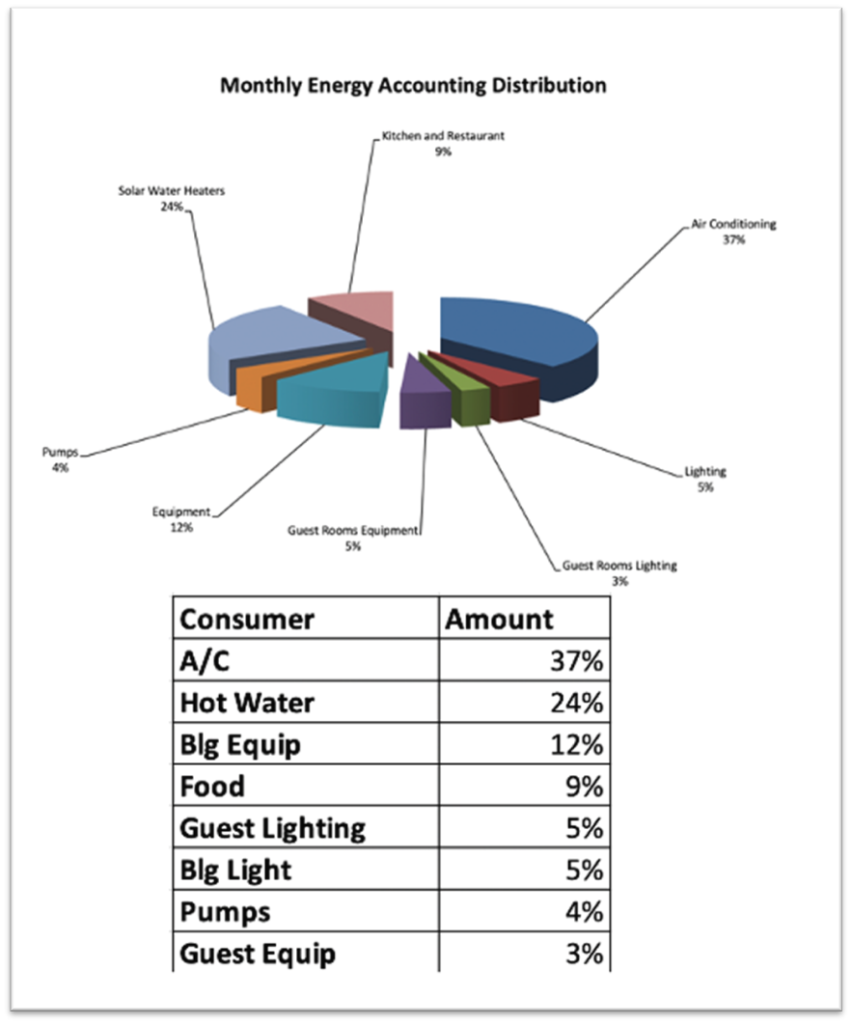
The resort articulated three business objectives
1. Reduce electricity costs by reducing electricity consumption
2. Reduce emissions
3. Provide energy security for five days of operating critical systems
Reducing electricity costs is normally a key objective for most organizations. This can be addressed by
• Renegotiating electricity contracts
• Reducing electricity consumption
• Generating onsite electricity at a lower rate
In this case, it was not possible to renegotiate the electricity contract with the local utility, so the focus was directed to reducing electricity consumption. As the key electricity consumer is air conditioning, the resort investigated technologies to reduce electricity via intelligent air conditioning in the guest suites.
Resorts in the Caribbean understand the need for emissions reductions. The demographics of their guests has shifted from boomers to millennials who are much more environmentally conscious. In fact, resorts that demonstrate advanced environmental policies have enjoyed a 50% increase in bookings within the millennial guests.
The KPI’s selected by the resort included:
• Grid electricity purchased per suite each month with the goal to reduce by 50%
• Generate 25% of their electricity onsite with solar PV
• Reduce emissions by 50% by 2030 to attract the younger demographic

Exercise 1.1: Why now?
▢ Environmental concerns about climate-change issues
▢ Customer pressure to implement green energy systems
▢ Marketing pressures to present an energy conscious image to customers
▢ Investor pressure to evaluate and elevate your energy profile
▢ Owner/Director pressure to upgrade the corporate energy profile
▢ Government regulatory pressures to conform to new energy standards
▢ Financial concerns about the rising costs of current energy systems
▢ Availability to acquire funding through grants and incentives

Course Manual 2: Investment Grade Strategy
An investment grade energy plan provides decision-makers with all the materials needed to support a financial investment in an energy project. In the past, organizations have started with an “Energy Audit” to get an understanding of the current state of the building systems and to identify options for reducing energy consumption. However, these energy audits rarely lead to investments in energy projects. The reason for this is that energy audits provide a technical view on the problem and don’t translate well to the needs of the decision-makers for investments. This is where the “Investment Grade Energy and Carbon Strategy” comes in.
Energy Audits
Energy audits provide an understanding of the building and equipment condition and makes recommendations on energy conservation measures (ECM) based on monthly data. Energy audits are primarily focused on energy conservation – which is a good place to start. These audits provide value to the building operators, but have limited value to the financial decision-makers.
There are three levels for energy audits.
Level 1: Walkthrough
A basic walk-through examination, a review of utility bills and other pertinent operating data, and interviews with operations staff comprise the basic Level 1 audit. The purpose of this basic assessment is to find obvious energy issues. Low-cost modifications are suggested, energy efficiency projects can be prioritized, and whether a more thorough audit is required is decided with the use of this audit’s detail.
Level 2: Detailed Analysis
By include further financial analysis of suggested energy measures and more thorough energy calculations, the Level 2 audit expands upon the Level 1 examination. In order to gain a deeper understanding of the building’s energy consumption, this level of audit makes use of utility data collected over an extended period of time. At this audit level, the business case for putting energy-saving measures into place is constructed using the financial analysis.
Level 3: Simulation and Energy Models
By undertaking a more thorough investigation of the building’s energy use, the Level 3 audit expands upon the findings of the Level 2 audit. Sub-metering of large energy systems is one example of this. The accuracy of costs and savings is raised by the more thorough examination of the current structure and suggested energy-saving measures. Higher quality, more precise data may be obtained at this level of detail, which is beneficial for large, potentially capital-intensive energy projects.
A level 1 audit is the least expensive but does require an energy engineer to come onsite to walk through the building. The recommendations that are generated use different spreadsheets (in most cases) to forecast the financial and environmental value for each recommended technology. This introduces uncertainty as they are not assessed in a consistent manner.
Further, depending on the organization conducting the audit, only those ECM’s with which the organization is familiar are considered – leaving out many other alternatives. Given that the market is evolving and many new solutions are introduces, these energy audits are incomplete which introduces further uncertainty.
A level 2 audit utilizes utility data to build an energy model. While this is an improvement over level 1 audits, these models often only used monthly totals (as opposed to detailed hourly or minute data) to assess the financial benefits of the recommended solutions. Building these energy models with the current software is human intensive and expensive.
A level 3 audit requires sub-meter data to dissect the buildings energy consumption to uncover the larger energy consumers and help to focus the attention of the solutions. Implementing sub-metering can be expensive. Once the data is available, it requires an experienced engineer to assess the data and determine what it means.
An advantage of developing an energy model with software such as IES, RETScreen, EnergyPlus (and others) is that they can be used to assess the value of envelope upgrades.
It should be noted that energy audits from different organizations will result in different recommendations and financial forecasts. In general, all these uncertainties are the reason why energy audits do not lead to investment decisions.
Investment Grade Energy and Carbon Strategy
The Investment Grade Energy and Carbon Strategy (IGS) addresses the challenges introduced by a traditional energy audit – and provides a focus on the analyses that speak to the financial decision-makers. The objective of an IGS is to accelerate the investments into energy projects.
When considering investments in energy projects, it is crucial to carefully evaluate various factors that can impact the decision-making process. Investors require assurance that the project is financially sound, capable of generating profits, and in line with their strategic objectives in order to make a commitment of capital. These are the main factors that influence investment decisions in energy projects:
1. Ensuring that all technology options have been thoroughly considered:Investors require confidence that a comprehensive evaluation of all possible technology options has been conducted. This encompasses conventional energy sources, sustainable energy technologies, and emerging advancements. Conducting a thorough evaluation of technology options allows investors to gain insight into the advantages and drawbacks of each, guaranteeing that the selected technology is in line with project objectives and market conditions.
2. Ensuring that all possible combinations of technologies have been thoroughly considered and accounted for:
By combining various technologies, the efficiency and resilience of energy projects can be greatly improved. For example, the integration of solar power with battery storage or the combination of wind energy with hydroelectric power can result in a more consistent and dependable energy output. Investors require assurance that a thorough analysis of all possible scenarios involving stacked or combined technologies has been conducted to optimize performance and minimize risks.
3. Ensuring Consistency in Forecasting Assumptions for Each Scenario: Precise and reliable forecasting is essential for predicting the financial performance of energy projects. Investors need to have confidence that all scenarios are built on consistent assumptions about market trends, energy prices, technological advancements, regulatory changes, and economic conditions. Ensuring consistency in forecasting is crucial for valid and reliable comparisons between different scenarios.
4. Evaluating the External Risk Factors Affecting the Financial Results: Energy projects face a range of external risks, such as changes in regulations, political instability, economic fluctuations, and environmental challenges. Investors require a comprehensive risk assessment that identifies these factors and evaluates their potential impact on financial outcomes. Implementing effective risk management strategies, such as diversifying investments and securing insurance, can help mitigate these risks and instill greater confidence in investors.
5. Key Performance Indicators That Appeal to the Financial Decision-Maker: Customized Key Performance Indicators (KPIs) that align with the priorities of financial decision-makers are crucial. These key performance indicators should offer valuable insights into the financial well-being and overall performance of the project. Some important metrics to consider are return on investment (ROI), internal rate of return (IRR), net present value (NPV), payback period, and cost savings. Having clear and concise KPIs allows financial decision-makers to easily evaluate the project’s feasibility and profitability.
6. A thorough grasp of the reasons behind the superiority of one scenario over another: Investors require a concise justification for why one scenario is favoured over others. This requires a thorough examination of the advantages, expenses, uncertainties, and performance measurements linked to each situation. Having access to reliable data and analysis is crucial for investors to make well-informed decisions and understand the potential trade-offs.
The IGA addresses these factors by:
● Considering a wide-range of technologies – ECM’s as well as onsite generation
● Focused on identifying those projects that maximize value for investment
● Providing detailed financial, risk analysis, capital planning
● Value to the business executive / investment decision-makers
● Assessing each scenario with consistent assumptions on the financial and environmental factors

Case Study: IGS for Hotels
A consortium of hotel owners expressed interest in reducing energy costs at their facilities. A study of 2101 hotels across the USA was commissioned to identify solutions to reduce energy costs while also addressing carbon emissions reduction.
We examined the financial and environmental value of a range of technologies. Technologies considered in this study include:
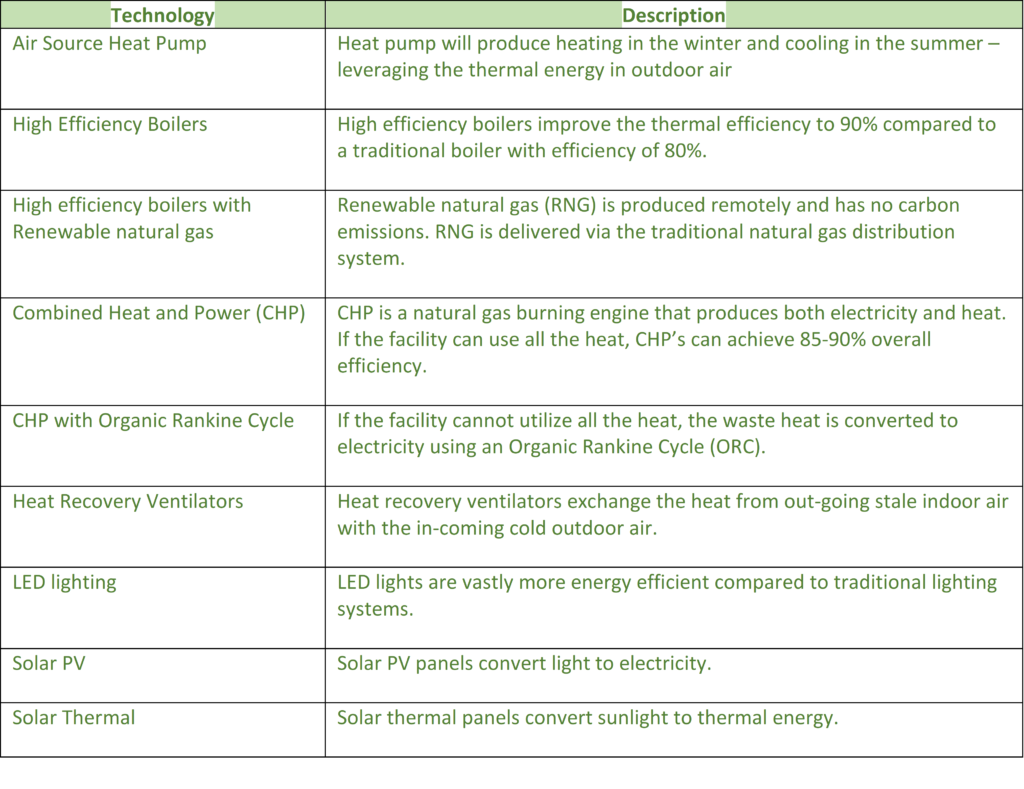
The simulation results are shown in these bubble charts. Each bubble represents a project recommendation (technology for a specific hotel). The colour represents the technology, the size represents the capital cost of the project.
These bubble charts allow us to quickly compare various technologies at specific facilities to each other and identify those that have the best financial and environmental performance.
Financial Performance
The charts shows the simple payback (affordability) on the X-axis and the lifetime savings (materiality) on the Y-axis.
The biggest savings (bubbles at the top) are available at hotels in Hawaii where the energy rates are very high.
Hotels with pools have a much higher thermal demand that best align with onsite combined heat and power (CHP) solutions or fuel cells. These are shown with the smaller purple bubbles.
The larger purple bubbles represent the CHP with ORC. In these cases, the capital costs (size) are much higher resulting in a longer simple payback.
Solar PV (yellow bubbles) do not perform as well as base load generating technologies (small purple bubbles). This is due to the additional high demand charges which solar PV does not address.
Air source heat pumps (grey bubbles) have a mixed performance – they tend to do well in warmer climates. However, since heat pumps increase your electricity demand, base load generation technologies (CHPs for example) tend to have much better financial returns and are usually a better investment.
Fuel cells (blue) show some interesting performance both financially and environmentally, but will be challenged with the availability of hydrogen – at least in the short term.
Upgrading to high efficiency boilers (red) can have relatively short paybacks: they are not very expensive to install and can provide immediate savings. On the long term though the savings are minimal compared to what one can achieve with other technologies.
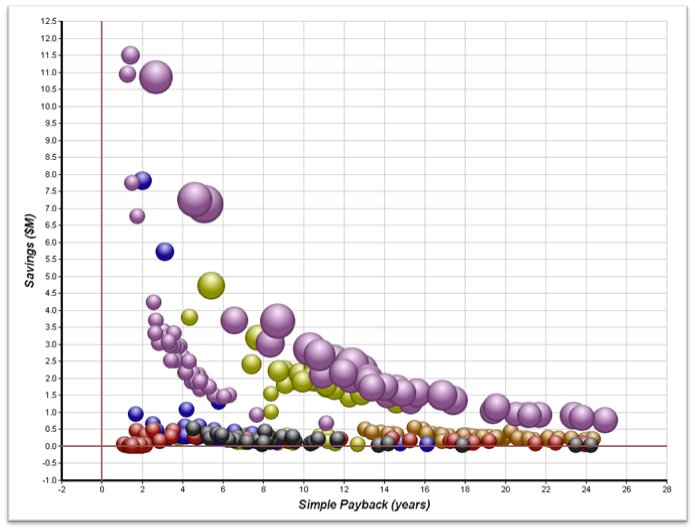
Financial and Environmental Performance
Changing the metrics, we can examine the financial and environmental performance. This analysis shows the financial performance (NPV on the Y-axis) against the environmental performance (GHG savings on X-axis).
We can see that the three project recommendations that have the best NPV are hotels in Hawaii with onsite baseload generation (red circle).
The fuel cells (blue bubbles) also show good financial and environmental performance.
The solar projects (yellow bubbles) certainly provide GHG savings but the financial performance is not as good as they do not address the peak demand as well as baseload technologies.
It is also interesting to note that there are many project recommendations that have positive emissions savings, but poor financial performance (negative NPV – bubbles below the red line).
Similarly, there are project recommendations that have positive NPV (above the red line) but have poor environmental performance (negative GHG emissions savings).
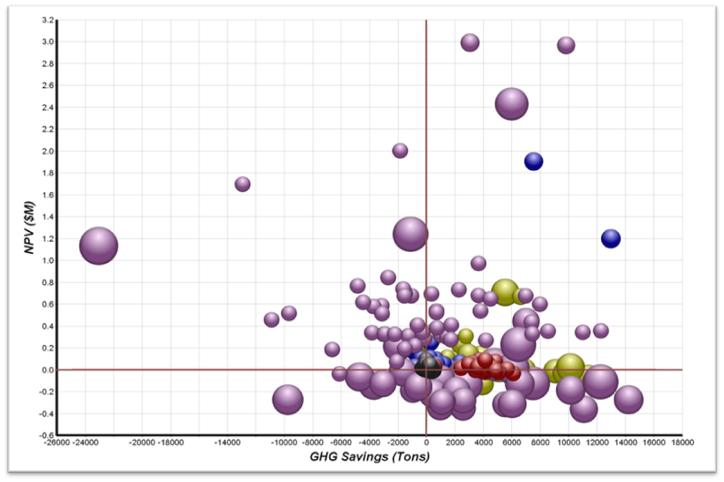
Capital Efficiency
The capital efficiency can be shown by considering the capital vs financial savings. This shows that for any given capital investment, what level of savings can be achieved. Consider the orange vertical line. For an investment of 0.45M we can implement the solar (yellow), fuel cell (blue) or CHP (purple), but the CHP generates significantly higher savings and is more desirable.
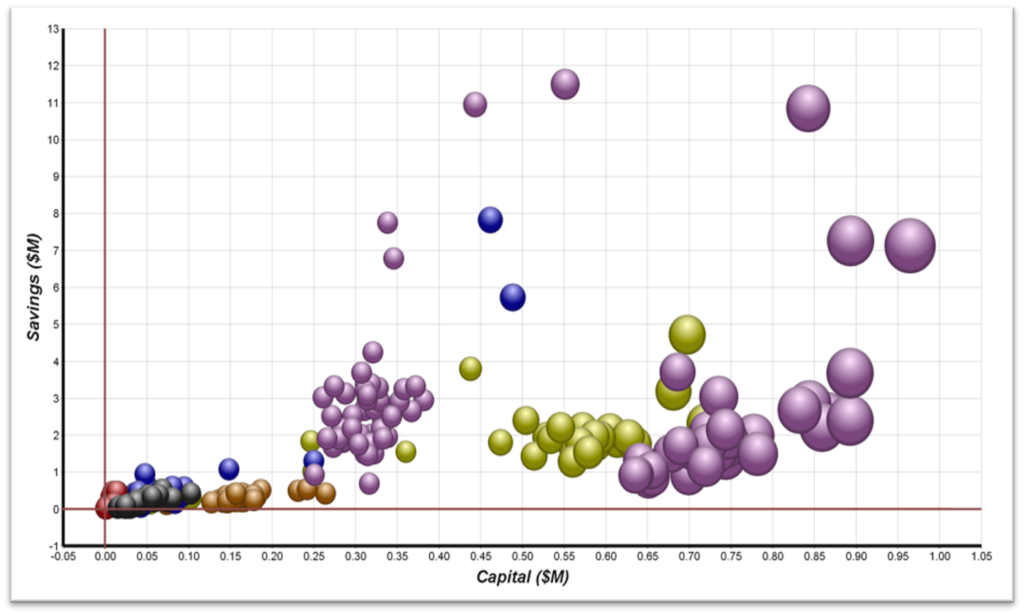
Similarly, consider the horizontal orange line. In this case we could implement a number of technologies to achieve $8M in savings, but the small purple (CHP) project has much lower capital requirements.
The red line represents the “efficient frontier”. The closer you are to this line, the more capital efficient are the projects.

Case Study: Hotels in USA
Using a case study of hotels across all 50 states in the USA, we can demonstrate the IGS journey. Given the hotel electricity and gas data from OpenEI.org, we imported the data into a simulation tool. This included 2101 hotels of various sizes.
For each hotel, we were able to determine the energy required for electricity, heating and cooling. Further, each state provides the average annual electricity and natural gas rates as well as the carbon emissions in the electricity grid. These were added to the model.

Example Hotel: Hawaii
The simulation tool then computed the financial and environmental metrics such as the ROI, NPV, simple payback, emissions reduction, GHG abatement rate.
The diagram below shows the impact of a 2000 kW combined heat and power (CHP) for the hotel in Hawaii.

The size of each of the technologies simulated was selected to optimize the ROI.
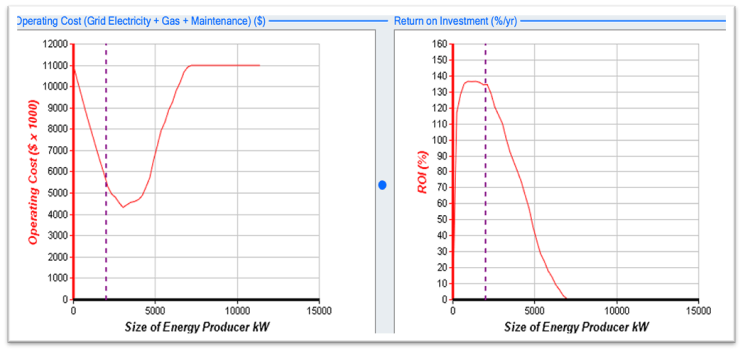
The financial and environmental metrics for each technology were then forecasted for the anticipated life span of the technology. By considering a wide-range of technologies, the executive are confident that the analyses has considered all the options, and the value for each has been forecasted in a consistent manner. This provides the confidence they need that the proposed project is in fact the best one.
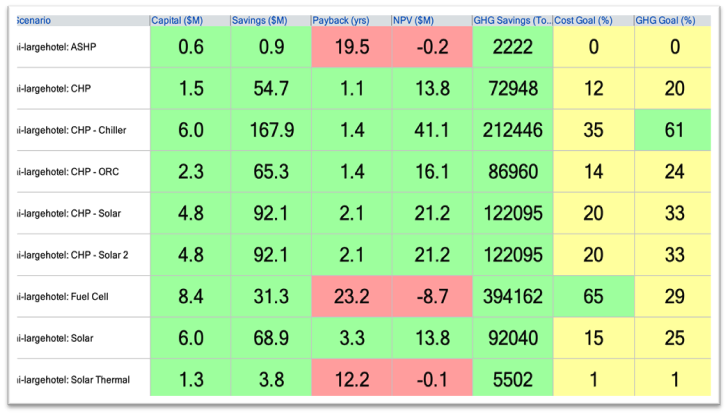

This identified the CHP project to have the shortest simple payback and high lifetime savings. The next step is to understand the risks using a Monty Carlo analysis on the external risk factors. The results show that the financial metrics are most sensitive to the future grid electricity rates. However in the worst cases, the risk analysis shows that the CHP project is still financial viable.
Finally, we can combine the results for all technologies and for all hotels to identify those projects that have the greatest opportunity for success. In a series of bubble charts, we can show each scenario (combination of technologies for a specific facility) as a bubble.
In this example, we are considering the simple payback on the X axis and the lifetime savings on the Y axis. So we are looking for bubbles in the top left corner.
The colour represents the technology. In this case, purple represents CHP making it clear that CHP’s work very well for many hotels. The reason is that hotels often have pools which demand a great deal of heat – aligning well with the output of the CHP.
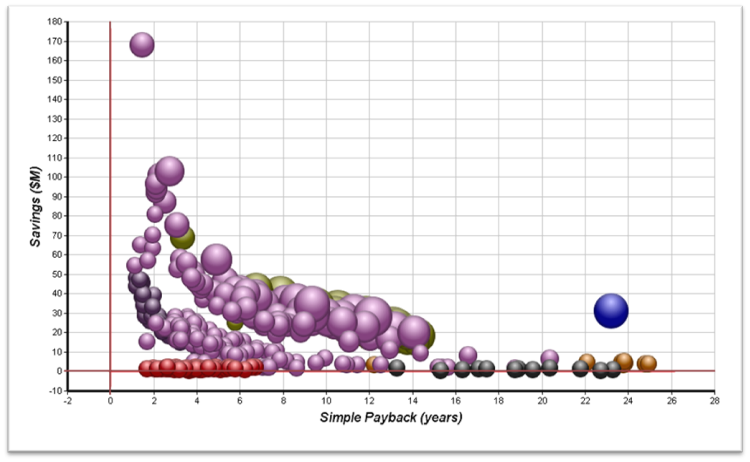
This also shows that solar (yellow) does not perform as well as the CHP (smaller purple), and the high efficiency boilers (red) do not perform as well as CHP.
Changing the axes, we can consider the environmental metrics. In this case we are looking at the GHG emission savings on the X axis and the NPV on the Y axis.
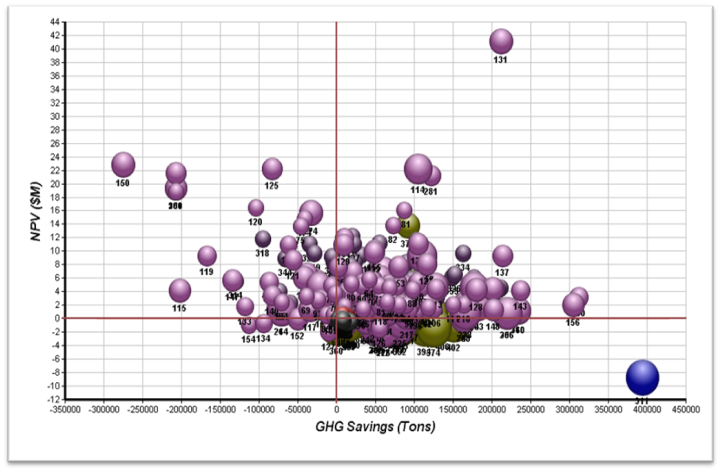
There are many CHP (purple) projects that have negative emissions savings. These are for states in which the electricity grid is relatively clean.
In this case, we are looking for bubbles that are in the top right corner (high NPV and high emissions savings).
Finally, we can consider the capital efficiency – a favourite of the CFO. In this analysis we are considering the capital invested versus the lifetime savings.
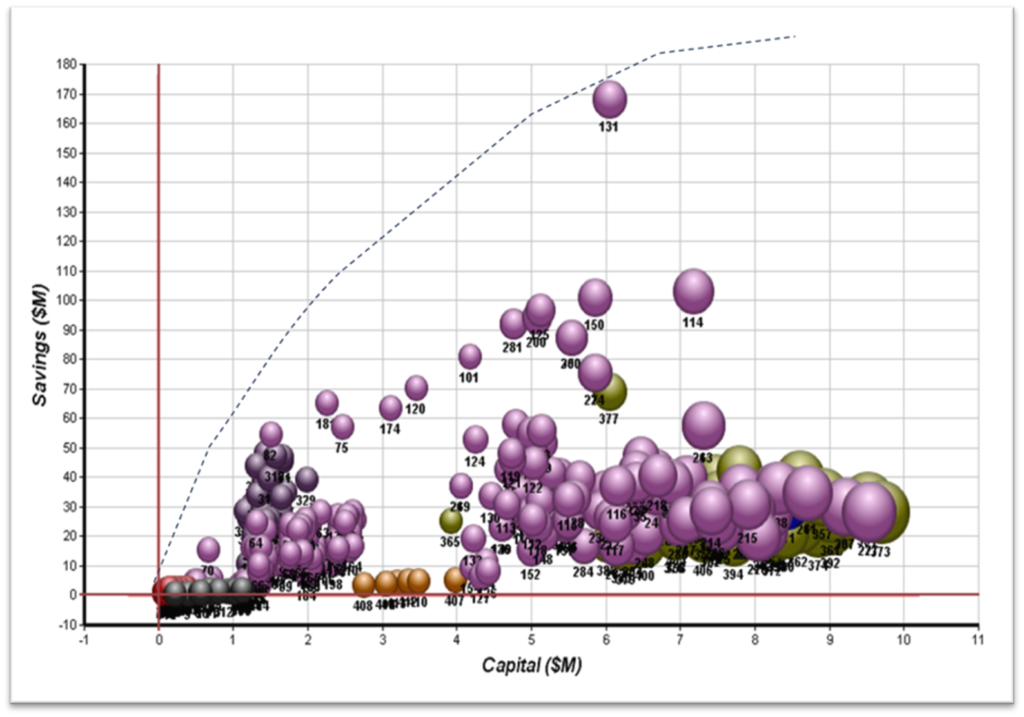
Consider bubbles 131 and 377. Each of these require an investment of $6M, but scenario 131 generates much higher savings – a better option.
Consider bubbles 114 and 150. Both generate savings of $100M, but 150 requires much less capital.
The closer you are to the dotted line, the more efficient the capital has been deployed.
These analyses make it clear to the CFO that
● We have considered all the options
● We have optimized the scenarios to maximize the ROI
● We have identified scenario 131 as the best option

Exercise 1.2: Energy and Sustainability Plans
▢ No, this is our first attempt to build an energy strategy
▢ Yes, our organization has attempted to build an energy plan in the past
▢ Energy Audits
▢ Other, please identify the strategies and explain if it succeeded or failed.

Course Manual 3: IGS Overview
This graphic demonstrates the journey for an IGS.
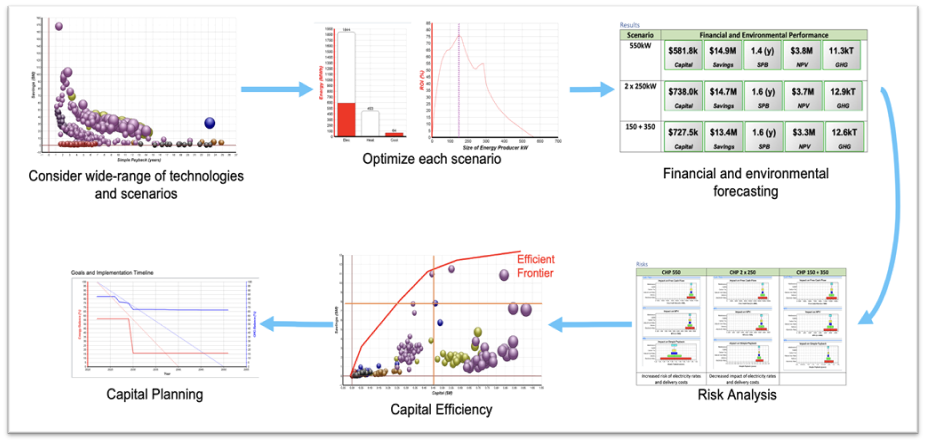
An investment grade energy strategy (IGS) is a comprehensive assessment of a facility’s energy usage and potential areas for improvement. Unlike a basic energy audit, an investment grade audit goes beyond surface-level evaluations and provides in-depth analysis and actionable recommendations. This type of audit serves as a foundation for making informed decisions regarding energy efficiency measures and on-site energy generation initiatives.
The key components of and IGS are:
• Thorough Energy Consumption Analysis: An evaluation of historical energy usage data, utility bills, and operating schedules to identify patterns and trends.
• Detailed Facility Inspection: On-site visits to assess building systems, equipment, and operations, including HVAC systems, lighting, insulation, and controls.
• Energy Simulation and Benchmarking: Utilization of advanced software tools to simulate energy performance, compare with industry standards, and identify potential energy savings and energy generation opportunities.
• Financial Analysis: Assessment of potential energy efficiency projects, including cost estimates, payback periods, return on investment (ROI), and financing options.
• Risk Analysis: Assessment of the impact of external risk factors on the financial performance of the proposed solutions
• Recommendations and Implementation Plan: A comprehensive report outlining prioritized energy-saving measures, estimated energy and cost savings, and a roadmap for implementation.
An IGS has the following benefits
• Improved Energy Efficiency: Identifying energy inefficiencies and implementing recommended measures can lead to significant energy and cost savings over the long term. It’s always best to reduce the energy you need before implementing energy generation solutions.
• Enhanced Sustainability: By reducing energy consumption and carbon footprint, organizations can contribute to environmental stewardship and meet sustainability goals.
• Operational Optimization: Investment grade audits provide insights into optimizing building systems, improving occupant comfort, and prolonging the lifespan of equipment.
• Increased Asset Value: Energy-efficient buildings are highly valued in the market, attracting tenants, investors, and potential buyers.
• Access to Incentives and Financing: An investment grade audit helps uncover eligibility for government incentives, grants, and financing options for energy efficiency projects.
Who Should Build an Investment Grade Audit?
Investment grade audits are valuable for a range of industries that aim to optimize energy consumption and reduce costs.
Commercial Facilities: Commercial buildings, such as office complexes, retail spaces, and warehouses, can greatly benefit from investment grade audits. These audits help identify energy-saving opportunities related to lighting, HVAC systems, building envelope, and energy management controls.
Institutional Facilities: Institutions like schools, universities, hospitals, and government buildings can leverage investment grade audits to uncover energy efficiency measures tailored to their unique needs. By optimizing their energy usage, institutions can redirect funds toward educational programs, patient care, or public services.
Approach
An IGS can be performed on a single facility or an entire portfolio of buildings. For example, a hotel chain may have buildings in different regions, with different weather, different energy cost structures. The decision-makers would like to determine where to invest in order to get the best return on investment.
After the energy data for a “portfolio” of buildings is provided, the IGS will simulate the financial and environmental impact for a wide-range of technologies and combinations of technologies. Each “scenario” (a set of technologies for a specific facility) will generate financial metrics such as the simple payback, NPV, IRR, as well as environmental metrics such as emissions reduction and carbon abatement rate.
These results can be provided in a series of bubble charts (see Case Study for a more detailed example) which make it very clear to the decision-makers which scenarios are more effective.
Those scenarios that demonstrate the best alignment to the objectives need to be optimized. Optimization should consider
● Minimizing operating costs
● Maximizing return on investment
● Minimizing carbon emissions
This results in the forecasted financial and environmental metrics for each of the scenarios.
The next step is to assess the financial impact on external risk factors. This will provide decision-makers with the understanding on the sensitivity of different risk factors. While one scenario may have better financial returns, the decision-maker may elect to invest in another scenario that still has good financial metrics but lower risk.
A very popular analysis is “Capital Efficiency”. In this analysis, it becomes very clear to the CFO that the proposed project is financially efficient (more on this in the Case Study).
One of the key aspects of the IGS is that all market technologies are considered in the recommendations. Market technologies break down into five categories
1. Energy Reduction
2. Electricity Production
3. Thermal Production
4. Energy Storage
5. EV Chargers
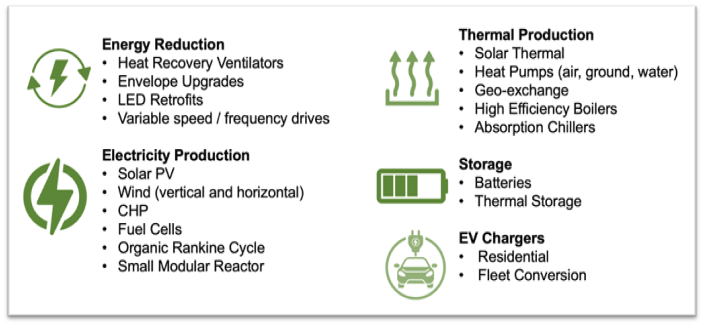
When developing the IGS, we need to identify those technology types that are not possible given conditions at the facility. For example, if natural gas is not available, we cannot consider technologies that depend on natural gas.
It is important that all other potential technologies are considered in order to provide decision-makers with the confidence that the proposed solutions are the best ones.

Exercise 1.3: Past Technology Projects
• Identify the technologies that you have implemented in the past.
– How have these worked / failed?
• How are you measuring the performance of past projects?
• Identify technologies that are not relevant / possible at your facility.
– E.g. no space for solar PV
– E.g. no natural gas for CHP
• Are there other technologies that you are already considering?
– What are the motivations for these projects?

Course Manual 4: IGS Canvas
Throughout the program, we develop the Investment Grade Energy and Carbon Strategy using the “IGS Canvas” which pulls together all the components needed to support financial investment in an energy project.
While some modules have pre-requisites, the journey through this canvas does not need to be linear. Depending on the interests of the participants, we can move through the canvas story in different ways.
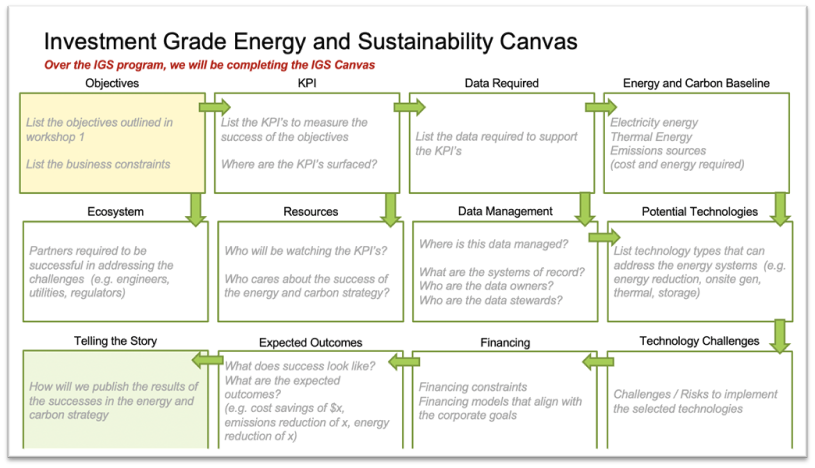
The Investment Grade Energy and Sustainability Canvas is a strategic framework designed to guide organizations in their efforts to achieve energy efficiency, sustainability, and carbon reduction goals.
The ‘Actualizing NetZero’ program and the Investment Grade Energy and Carbon Strategy is very different from a more familiar energy audit process. As such, it is important that we walk through the journey at a high level and examine a case study as an example.
The key value in an IGS is that it translates “techy-speak” to “CFO-speak”. The audience for the results of an IGS are the financial decision-makers (normally the executive and CFO). While the development of the IGS requires input and acceptance from the facility managers and engineers, the analyses and results generated in the IGS are very much focused on the needs of the decision-makers.
A frequent complaint heard from decision-makers is that they are inundated with possible solutions from vendors and management. The resulting frustration leads to inertia and no action.
Confidence is a major supporting factor when making an investment decision. Decision-makers need to be confident about their strategy, and know that it has considered all possible solutions on the market – even those that are cost prohibitive. The challenge with the traditional energy audit process is it is expensive to examine a wide-range of technologies. Further, it is common that each technology is assessed with independent tools or spreadsheets making it impossible to compare the performance of the technologies. Even worse, technology vendors provide analyses that is invariably biased.
What is required is a technology that independently and consistently assesses each of the technologies so that the results can be compared and the right solutions identified. The IGS process provides such an independent and consistent simulation technology.
Objectives
The journey starts with identifying the business objectives and KPI’s.
KPI’s
Key performance indicators to measure the success of achieving the objectives. Tracking progress towards the objectives outlined in the Investment Grade Energy and Sustainability Canvas is essential, and Key Performance Indicators (KPIs) play a crucial role in this process. Here are some key performance indicators to consider:
Energy Consumption Metrics:
• Annual kWh energy consumption.
• Energy usage per square meter.
• Energy consumption per unit of production/output.
Carbon Emissions Metrics:
• Annual greenhouse gas emissions in terms of CO2e.
• Calculating emissions based on energy consumption.
• Calculating emissions based on the amount of production/output.
Financial Metrics:
• Achieving cost savings through decreased energy consumption.
• Calculating the return on investment (ROI) for sustainability projects.
• Calculating the payback period for investments in energy efficiency.
Operational Efficiency Metrics:
• Tracking the decrease in energy consumption over time.
• Enhancement in production efficiency, specifically in terms of output per unit of energy.
• Minimizing downtime and waste.
Concern for the environment and long-term viability Metrics:
• What is the proportion of energy that comes from renewable sources?
• Efforts to reduce waste and increase recycling rates.
• Metrics for water usage and conservation.
Identifying the Audience for the KPI’s
Monitoring and evaluating KPIs is crucial for the successful implementation of the canvas. Important parties who will be closely monitoring these key performance indicators are:
• Senior management and executives will closely monitor key performance indicators (KPIs) to ensure they are in line with strategic goals and financial performance.
• As an energy analyst, you’ll find that sustainability officers play a crucial role in monitoring key performance indicators (KPIs) to effectively implement sustainability initiatives and maintain compliance with environmental regulations.
• Energy managers will prioritize energy consumption and efficiency KPIs to maximize energy use and uncover possibilities for enhancements.
• Financial Analysts: Financial teams will evaluate cost savings and return on investment metrics to determine the financial implications of sustainability projects.
• Operations Managers: Operations teams will closely monitor operational efficiency and production-related KPIs to ensure seamless and efficient processes.
• For shareholders and investors, it is important to consider sustainability and financial KPIs when assessing the organization’s long-term viability and profitability.
• Government and regulatory agencies may review certain KPIs to ensure compliance with environmental and energy regulations, just as they would for any other industry.
• Encouraging employees to monitor specific KPIs can cultivate a culture of sustainability within the organization.
Data needed to support the KPI’s
Precise and thorough data is crucial for evaluating KPIs and attaining the goals of the canvas. Important data requirements include:
• Detailed records of energy usage across different facilities, equipment, and processes are available in the energy consumption data. This data includes information from utility bills, energy meters, and sub-meters.
• Emissions Data: Information on greenhouse gas emissions from different sources, including emissions from operations and purchased electricity.
• Financial Data: Details regarding energy costs, savings achieved through efficiency projects, investment costs, and various financial performance metrics.
• Operational Data: Information regarding production levels, operational efficiency, equipment performance, and maintenance schedules.
• Provided: Data on waste generation, recycling rates, water usage, and renewable energy production.
Managing the Data
Robust data management systems are crucial for effectively managing and utilizing the necessary data. Here are some of the systems:
• Energy Management Systems (EMS) are software platforms that collect, monitor, and analyze energy consumption data in real-time. They provide valuable insights for optimization.
• Tools for tracking and reporting on sustainability metrics, including emissions, waste, and water usage.
• Building Management Systems (BMS): Systems that regulate and oversee building systems, such as HVAC, lighting, and security, with the aim of maximizing energy utilization and enhancing efficiency.
• Enterprise Resource Planning (ERP) Systems: Comprehensive systems that handle and evaluate financial, operational, and sustainability data throughout the organization.
• Carbon Accounting Software: Tools designed to track and report greenhouse gas emissions, assisting organizations in managing their carbon footprint.
• Advanced analytics tools are used to process large datasets and uncover valuable insights such as trends, patterns, and opportunities for improvement.
Baseline
Establishing a baseline for energy consumption, emissions, and other metrics requires historical data. This baseline will act as a reference point for measuring improvements.
Establishing an energy baseline is an essential step in the Investment Grade Energy and Sustainability Canvas. The baseline serves as a benchmark for measuring progress, representing the organization’s historical energy consumption and emissions data.
Steps for Establishing an Energy Baseline:
• Collect historical energy consumption data, utility bills, and emissions records for at least one year.
• Perform data analysis to uncover patterns, seasonal variations, and the main factors influencing energy consumption and emissions.
• Baseline Development: Determine the average energy consumption and emissions during the baseline period, taking into consideration any anomalies or irregularities that may have occurred.
• Adjusting the baseline to account for changes in production levels, facility expansions, or other significant factors that could impact energy use is an important step in the normalization process.
Simulation
We then move into simulating and assessing a wide-range of potential technologies and measure their ability to make significant progress against our objectives and KPI’s. Using the same tools, assumptions and forecasts, we are able to confidently compare the performance of the different technologies.
Various technologies can assist in meeting the goals of the Investment Grade Energy and Sustainability Canvas. Here are some of the technologies:
Exploring Energy Efficiency Technologies:
• LED Lighting: Efficient lighting solutions that help lower electricity usage.
• Advanced heating, ventilation, and air conditioning systems that are designed to optimize energy use.
• Enhanced insulation and building materials that effectively minimize heating and cooling requirements.
• Efficient in terms of energy consumption Appliances and Equipment: Utilizing high-efficiency appliances and industrial equipment that consume less energy.
Exploring Renewable Energy Technologies:
• Solar Photovoltaics (PV) are a type of technology that harnesses the power of sunlight to generate electricity.
• Wind Turbines: Power-generating systems that harness the energy of the wind.
• Hydropower is derived from the natural flow of water, often harnessed through the use of dams or rivers.
• Geothermal Energy: Systems that utilize the earth’s heat for power and heating.
Exploring Energy Storage Technologies:
• Systems that store excess energy for use during peak demand or when renewable sources are not producing are battery storage systems.
• Thermal Storage: Utilizing technologies to store heat or cold for future use, enhancing energy efficiency.
Smart Technologies:
• Smart Meters: Advanced metering devices that offer real-time data on energy consumption.
• Building Automation Systems: Systems that efficiently control building operations, maximizing energy efficiency.
• IoT Devices: Devices that enable the collection and transmission of data to improve energy management.
Once high-potential scenarios (combination of technologies) have been identified, they are optimized given the objectives of the organization (maximize ROI/NPV, minimize operating costs, minimize emissions, maximize energy security). Different organizations may have different objectives, so the optimization criteria will be different. The analyses needs to provide the decision-makers with an understanding of how optimizing with one criteria impacts the other criteria. For example, if we optimize for ROI/NPV, then how does this impact the emissions reduction performance.
Once we have optimized the scenario, this leads to forecasting the financial and environmental metrics of each scenario. This forecasting (normally for 15-25 years) needs to include an estimate of the future electricity rates, natural gas rates, carbon taxes, local grid emissions factors.
As this forecasting is very much a crystal ball exercise, the IGS needs to include a monti carlo risk analyses on these factors. What if we were to guess wrong about the future electricity rates? How would this impact the financial metrics of the scenario? The decision-makers need to have a quantitative analysis on the risks and an understanding of the financial impact on external risk factors over which the organization has no control.
Ecosystem of Partners
Implementing the Investment Grade Energy and Sustainability Strategy necessitates working closely with a wide range of partners in order to foster collaboration. Some of the important partners are:
• Technology Providers: Companies that offer energy-efficient and renewable energy technologies.
• Energy Service Companies (ESCOs) are experts in developing, executing, and overseeing energy efficiency initiatives.
• Consultants and Advisors: Professionals who offer strategic guidance, technical expertise, and project management support.
• Utility companies are energy providers that can offer incentives, rebates, and data to support energy efficiency initiatives.
• Financial Institutions: Banks, investors, and funding agencies that offer financing for sustainability projects.
• Government Agencies: Regulatory bodies and public agencies that provide grants, subsidies, and regulatory support.
• Non-Governmental Organizations (NGOs): Organizations that promote sustainability and offer resources and support.
• Industry Associations: Organizations that represent specific industries and promote knowledge sharing and collaboration.
Financing
Finally, the results of all the scenarios can be brought together in a series of bubble charts that demonstrate the capital efficiency, financial and sustainability effectiveness which help to assess the financing models, ranging from internally financed, bank financed, utility financed or performance contracts. These bubble charts are very effective at contrasting the financial and environmental benefits of the scenarios considered and makes it very obvious to the decision-maker that the proposed scenario is in fact the best one. This builds confidence for the decision-maker.
Securing financing is crucial for the successful implementation of energy and sustainability projects. There are various financing models that can be used:
• Utilizing internal funds and reinvesting cost savings from energy efficiency projects to support itself financially.
• Energy Performance Contracts (EPCs) involve agreements with ESCOs, where the costs of the project are covered by the energy savings that are achieved.
• Power Purchase Agreements (PPAs) are contracts that allow for the purchase of renewable energy from a provider at a set price, typically without any initial expenses.
• Issuing bonds specifically for funding environmentally sustainable projects is a common practice in the financial industry.
• Exploring grants and subsidies: Accessing financial assistance from government programs and incentives.
• Private Investments: Drawing in investments from private sector partners, such as venture capital and private equity.
• Leasing equipment or technology allows for spreading the costs over time, which helps to minimize the need for upfront capital.
Telling the Story
Communicating the success and impact of energy and sustainability initiatives is essential for keeping up momentum and support. Some important strategies to consider are:
Internal Communication:
• Consistent Communication: Ensuring that employees and stakeholders are kept informed about progress, achievements, and future plans through regular updates.
• Organizing workshops and training sessions to actively involve employees and foster a sustainable culture.
External Communication:
• Annual sustainability reports are published to provide a comprehensive overview of achievements, key performance indicators (KPIs), and future goals.
• Issuing press releases to showcase significant milestones and achievements.
• Utilizing social media platforms to effectively communicate stories, accomplishments, and interact with the public.
• Case Studies: Creating case studies that highlight successful projects and best practices.
Engaging with stakeholders:
• Conducting stakeholder meetings to engage with important individuals such as investors, customers, and community members, in order to review progress and obtain valuable feedback.
• Announcing Partnerships: Sharing exciting collaborations that contribute to our sustainability efforts.
Awards:
• Seeking Certifications: Acquiring certifications like LEED, ISO 14001, and Energy Star to validate endeavours and earn acknowledgement.
• Applying for Awards: Applying for sustainability and energy efficiency awards to seek external validation and recognition.
Ensuring transparency and accountability:
• Open Data: Offering unrestricted access to data and findings to showcase transparency and foster trust.
• Engaging third-party auditors to verify performance and ensure accuracy in reporting is a crucial step in the process.
By utilizing the Investment Grade Energy and Sustainability process, organizations can methodically address their energy and sustainability objectives, guaranteeing thorough planning, execution, and communication. By adopting a structured approach, organizations can not only achieve their environmental and financial objectives, but also demonstrate a strong commitment to sustainability. This commitment not only enhances their reputation, but also strengthens their resilience in the face of future challenges.

Case Study: High Density Residential
An apartment complex in Calgary Alberta provides affordable housing for over 300 units. To reduce energy costs for the tenants, the complex implemented a number of Combined Heat and Power (CHP) units which are able to generate power at a much reduced rate for the tenants.
The owners were also environmentally driven and targeted net zero emissions. To do this, they also constructed the buildings with a super-tight envelope, implemented three solar PV arrays and a wind turbine.
A data management system was implemented to collect energy consumption data for each suite which was used to drive a tenant energy mobile app to encourage energy conservation.
The results were surfaced in a series of KPI’s that were used by building operators to determine when to use the CHP’s for best financial performance. The KPI’s were also used to demonstrate environmental performance for the financiers.
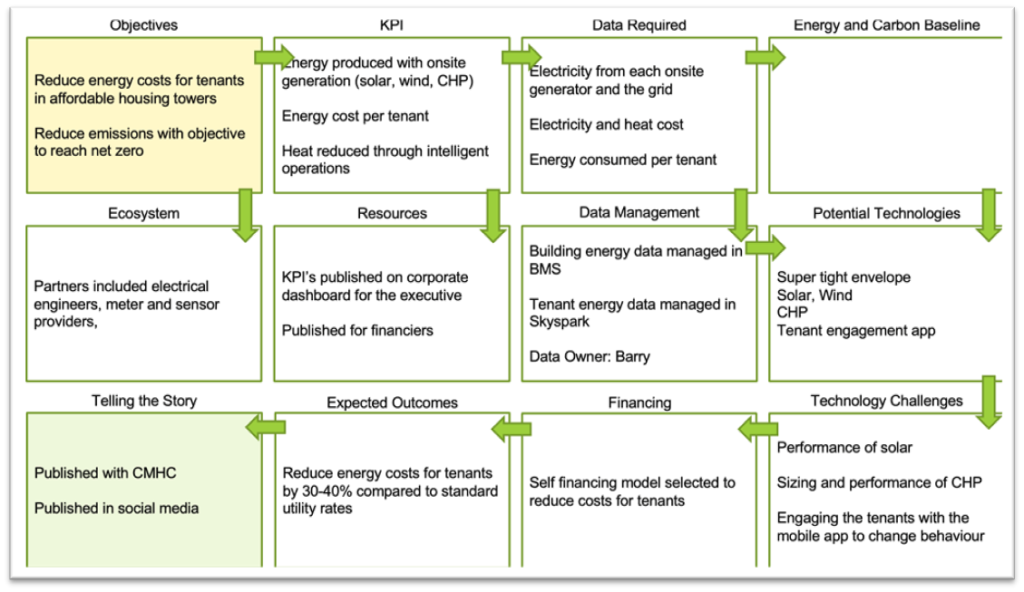

Case Study: Ski Resort
A ski resort in Canada struggled with very high electricity costs – mostly for transmission and delivery due to very high demand in the winter months related to snow making.
Does your facility have huge swings in power consumption (seasonal, time of day..)? Well, that spells opportunity both in going greener as well as savings LOTS of cost.
Your electricity bill has two main components:
• the cost for the electricity (kWh) and
• the cost for delivery of that electricity, largely based on your peak demand (kVA) over the past year. So, if you have even just 10 minutes of very high energy consumption in a whole year, you’d end up paying huge fees for the next 365 days. So for facilities that have peaky demand profiles, you’ll likely end up mostly paying for those delivery charges.
An example here: We investigated a facility implementing a single CHP. While this addressed their base load for the majority of the year, it did not address their peak demands, so the financial metrics (NPV, ROI) were poor.
But counter to intuition, where one CHP was poor it turns out that three CHPs together actually were an amazing idea, financially speaking. This is because one CHP will inevitably have downtime, pushing back up that peak. But three can support each other when one is down, massively reducing your demand charges.
The right solution is not always obvious – which is why detailed simulation of a wide range of scenarios is critical before engaging in these expensive projects.
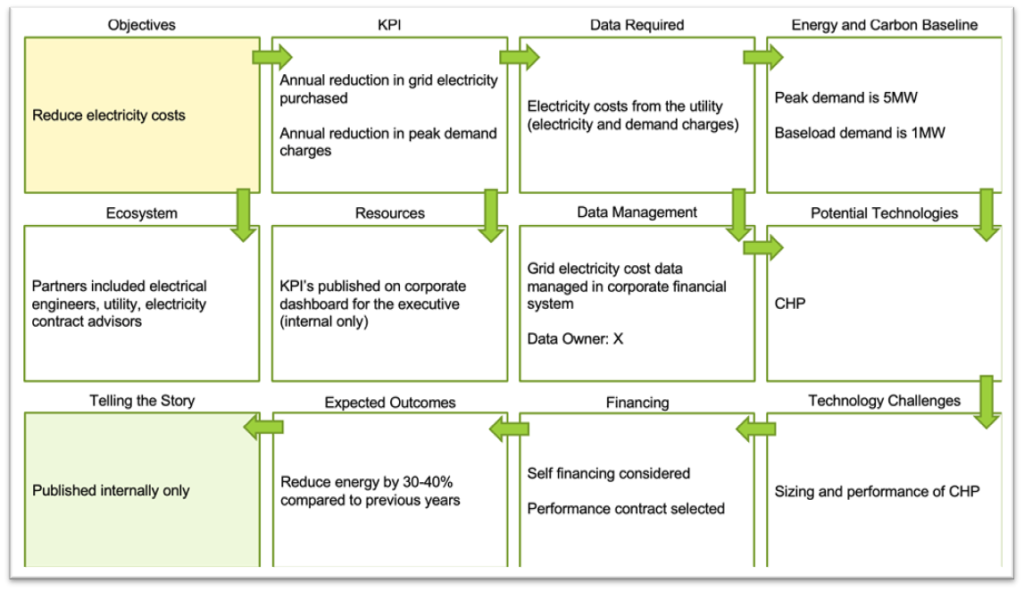

Exercise 1.4: Discussion on the IGS Canvas
• Are there sections that need more explanation
• Are there sections in the IGS Canvas that will be challenging?

Course Manual 5: Goals and Constraints
Each organization may have different goals and almost always has constraints that need to be considered in the energy strategy. In this workshop, we will identify the key goals which often break down into three categories
4. Cost reduction and/or cost certainty
5. Emissions reduction
6. Energy security
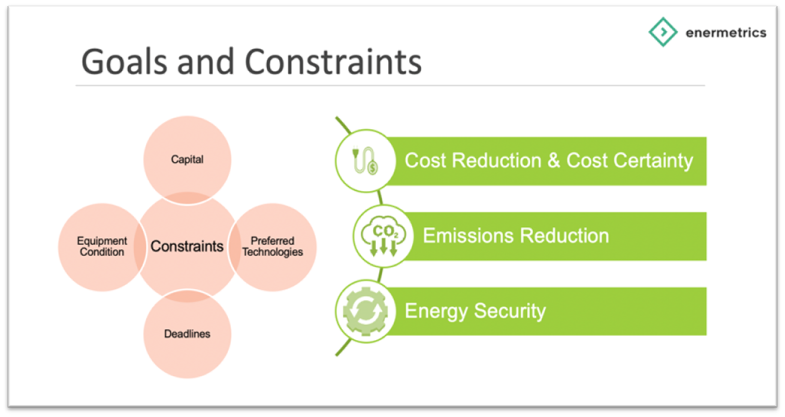
Cost Reduction Goal
Almost always, facility operators are concerned with energy cost reduction and addressing the anticipated increases in electricity costs. Energy costs are anticipated to rise in the years to come as the world moves to cleaner energy generation. Energy costs have risen at a much higher rate than inflation and in many cases, the cost of energy for an organization is second only to labour. Given that energy costs is one of the most significant line items on the budget, executives are very interested in managing the risks associated with energy – given that the energy rates are not something that they control. As such, executives are becoming more interested in onsite generation so that they can control (to some extent) the costs for their energy.
Emissions Reduction Goal
Many organizations are establishing their emissions reduction goals – primarily driven by customer demand. The question is how to reduce emissions affordably. Emissions break down into three sections
• Scope 1 (emissions generated in the manufacturing of the organizations product)
• Scope 2 (emissions associated with the energy that the organization consumes)
• Scope 3 (emissions related to the supply chain)
Organizations can only control scope 1 and 2 emissions. Just as the organization cannot control the cost of energy supplied by the utilities, the organization cannot control the emissions related to the energy they buy from utilities. As such, regions with a local grid with high emissions factors will significantly contribute to the scope 2 emissions. This is where renewable onsite generation, such as solar PV, can reduce dependence on the grid and reduce the scope 2 emissions. Some organizations have access to bio-waste (wood products, food waste) that can be used to generate bio-gas that can be used to reduce grid electricity as well as heat.
Where emissions reduction was an afterthought a decade ago, many industries are finding that their customers are demanding a strong sustainability program and low emissions products.
Greenhouse gas (GHG) accounting classifies emissions into three scopes: Scope 1, Scope 2, and Scope 3. These categorizations aid organizations in thoroughly comprehending and managing their carbon impact. This article offers a comprehensive examination of each area, encompassing illustrations from the domains of commercial real estate, institutions, and hotels.
Scope 1 Emissions
Scope 1 emissions are direct GHG emissions from sources that are owned or controlled by the organization. This includes emissions from combustion in owned or controlled boilers, furnaces, vehicles, and emissions from
chemical production in owned or controlled process equipment.
Commercial real estate
• Heating systems: Boilers and furnaces A commercial building equipped with an independent heating system will generate Scope 1 emissions from the burning of natural gas or oil in its boilers and furnaces.
• Real estate corporations sometimes maintain a fleet of vehicles for the purpose of property management and upkeep. The emissions produced by these cars are categorized as Scope 1 emissions.
Institutions
• Universities that have heating facilities on their campuses produce Scope 1 emissions by burning fossil fuels to generate heat and steam for their buildings.
• Laboratory equipment in research institutions can directly emit greenhouse gases (GHGs) during their operation.
• UCLA operates a cogeneration plant that supplies the campus with energy, heating, and cooling. The burning of natural gas by the plant leads to the release of Scope 1 gases. UCLA has adopted strategies to enhance the efficiency of the plant and decrease its carbon emissions.
Hotels:
• On-site Laundry Facilities: Hotels that offer on-site laundry services generate Scope 1 emissions through the use of natural gas-powered dryers and water heaters.
• Backup generators, specifically diesel generators, utilized for providing backup power in hotels, contribute to Scope 1 emissions.
Scope 2 Emissions
Scope 2 emissions refer to the greenhouse gas emissions that are indirectly produced through the use of purchased energy, steam, heat, or cooling. These emissions are produced at the facility where the power is generated, yet they are included in the organization’s greenhouse gas inventory.
Commercial real estate
• Office buildings contribute to Scope 2 emissions through the electricity usage of lighting, HVAC systems, and office equipment.
• Common Areas: Areas that are shared, such as lobbies and conference rooms, also contribute to Scope 2 emissions due to the energy they consume.
Institutions
• Classrooms and Laboratories: Universities utilize substantial quantities of power for illumination, computer systems, and scientific apparatus, resulting in Scope 2 emissions.
• Residence Halls: The energy consumption in student living facilities is also considered as part of Scope 2 emissions.
Hotels
• Guest Rooms: The electricity consumed by lights, air conditioning, and appliances in guest rooms contributes to Scope 2 emissions.
• Common Areas: Energy usage in hotel lobbies, restaurants, and conference facilities is also included in Scope 2 emissions.
Case Study: The Empire State Building has implemented a thorough energy retrofit to decrease its Scope 2 emissions. The building has achieved a substantial reduction in power use and, as a result, a large decrease in its indirect greenhouse gas (GHG) emissions by replacing its lighting, HVAC systems, and windows.
Scope 3 Emissions
Scope 3 emissions refer to all indirect emissions that take place in the value chain of the reporting company, encompassing both upstream and downstream emissions. These can encompass emissions arising from corporate travel, personnel transportation, waste management, and the manufacturing of acquired products and services.
Commercial Real Estate: Tenant Operations: Emissions resulting from the operations of tenants within the areas they lease are classified as Scope 3 emissions for the owner of the property. Within the supply chain, emissions resulting from the manufacturing and delivery of building materials and office supplies are categorized as Scope 3 emissions.
Institutions
• Student and Staff Commuting: Universities produce Scope 3 emissions as a result of the daily transportation of students, faculty, and staff.
• Procurement: Emissions resulting from the manufacturing and transportation of items acquired by the institution, such as laboratory supplies and office equipment, are accounted for in Scope 3.
Hotels
• Guest Travel: Emissions resulting from guests’ transportation to and from the hotel are categorized as Scope 3 emissions.
• Waste Management: Emissions resulting from the hotel’s waste disposal and treatment activities are categorized as Scope 3 emissions.
Case Study: Marriott International has made a commitment to decrease its Scope 3 emissions by collaborating with suppliers to enhance their sustainability practices. Marriott is actively engaged in procuring sustainable products, minimizing waste, and promoting the adoption of renewable energy among its suppliers.
Strategies for Controlling Scope 1, 2, and 3 Emissions
Commercial Real Estate:
• Enhancing Energy Efficiency: Installing energy-efficient lighting, HVAC systems, and insulation can effectively decrease both Scope 1 and Scope 2 emissions.
• Investing in on-site renewable energy sources, such as solar panels, has the potential to reduce Scope 2 emissions.
• Engaging renters in sustainable behaviors can effectively decrease Scope 3 emissions.
Institutions
• Sustainable transit: Encouraging the use of public transit, cycling, and carpooling can effectively decrease Scope 3 emissions generated from commuting.
• Implementing sustainable procurement strategies can help reduce Scope 3 emissions associated with the acquisition of goods and services.
• Energy management involves the implementation of energy management systems and the regular performance of energy audits, which can effectively decrease both Scope 1 and Scope 2 emissions.
Hotels
• Guest Awareness: Promoting guest engagement in sustainability programs, such as encouraging towel reuse and implementing energy-saving efforts, can effectively decrease Scope 3 emissions.
• Trash Reduction: The implementation of trash reduction and recycling initiatives can effectively lower Scope 3 emissions associated with waste management.
• Enhancing energy efficiency by replacing current appliances and lighting with energy-efficient alternatives can effectively decrease Scope 2 emissions.
Conclusion
Comprehending and controlling Scope 1, 2, and 3 emissions is essential for firms that seek to diminish their carbon footprint and make a positive impact on worldwide sustainability endeavors. Commercial real estate, institutions, and hotels can achieve substantial reductions in their greenhouse gas (GHG) emissions across all three scopes by deploying energy-efficient technologies, adopting renewable energy sources, and involving stakeholders in sustainability programs.
Energy Security Goal
In some facilities, energy security is critical. For example, a grocery store has millions of dollars of inventory in freezers and cannot tolerate long duration power failures. For example, a seniors care centre depends on quality power for life-safety equipment that cannot tolerate even the shortest power failure.
For hotel/resorts, guest expect a level of service which depends on the availability of electricity. There are “guest focused critical systems” such as lighting, air conditioning and plug loads (charging your phone). Hotel/Resorts are interested in ensuring that these “guest critical” systems are maintained for extended outages – often for several days. Other non-guest focused systems or amenities need not be included in this support.
Another example is grocery stores that have millions of dollars in inventory in coolers and freezers. Without power for more than a day, all this inventory must be destroyed.
On the other hand, there are organizations that can manage without power for short periods. For example, a greenhouse can tolerate power outages for extended periods so long as the temperature does not drop too far.
Each organization needs to decide which systems are critical (either for safety or for customer expectations) and how long these critical systems need to operate after a grid failure. This will then determine how much onsite electricity storage is required.
The importance of energy security for commercial real estate, hotels, grocery stores, seniors living facilities, and institutions is substantial and has multiple aspects. Energy security guarantees that these organizations can sustain their operations, safeguard their assets, manage expenses, and deliver vital services even in the face of power interruptions or fluctuations in the energy market. This analysis provides a comprehensive examination of the significance of energy security for every sector, accompanied with illustrative instances:
Commercial real estate
Energy security is vital in commercial real estate to uphold tenant contentment, guarantee uninterrupted business operations, and safeguard property value.
• Tenant Retention: Buildings equipped with dependable electricity infrastructure are more appealing to tenants, particularly those engaged in essential operations.
• Business Continuity: The provision of uninterrupted power supply guarantees that tenants can carry out their operations without incurring expensive periods of inactivity.
• Energy-secure buildings tend to have higher rental rates and property values.
The Salesforce Tower in San Francisco features a microgrid system that has the ability to function autonomously, separate from the primary power grid. This system incorporates the use of on-site power generation, energy storage, and sophisticated control systems to guarantee that the building can continue to operate essential functions even when there is a disruption in the power supply from the main grid. The building’s energy security feature has greatly appealed to tech companies and other enterprises that necessitate uninterrupted operation.
Hotels
• Energy security is crucial for hotels to ensure visitor comfort, safety, and overall satisfaction.
• Guest Satisfaction: Continuous power supply guarantees that guests can fully enjoy all amenities without any interruptions.
• Ensuring the protection and well-being of individuals and assets: Essential systems such as elevators, security cameras, and emergency lighting continue to function.
• Implementing revenue protection measures, such as preventing power disruptions, is crucial for avoiding customer cancellations and poor reviews.
The Hilton Santa Clara in California has installed a fuel cell system that provide continuous power for the hotel. This solution guarantees a dependable electricity provision, even in the event of grid failures, hence preserving guest satisfaction and enabling uninterrupted hotel activities. The hotel has the ability to maintain uninterrupted full services even during power outages in the region, which gives it a competitive edge.
Supermarkets
• Ensuring energy security is of utmost importance for grocery stores, primarily because they must sustain refrigeration systems to preserve perishable goods.
• Food Safety: Maintaining a reliable power supply for refrigeration reduces food spoiling and guarantees the safety of food.
• Financial Protection: Preventing inventory loss caused by power outages results in substantial cost savings.
• Resilience of the community: Grocery stores equipped with dependable electricity can function as central meeting places for communities amid extensive power failures.
Whole Foods Market has adopted fuel cell technology in multiple of its outlets. For example, the supermarket located in San Jose, California, utilizes a 400 kW fuel cell system that supplies 90% of the store’s electricity requirements. This solution guarantees that the store can sustain refrigeration and other essential operations, even in the event of power grid failures, safeguarding inventory and providing service to the community during emergencies.
Senior Living
• Energy security in senior care facilities is crucial for ensuring the safety and well-being of residents.
• Life Safety: Ensures the continued functionality of vital medical equipment and emergency systems.
• Comfort: Ensures the provision of heating, cooling, and other critical services for residents who are at risk or in need.
• Operational Continuity ensures the uninterrupted provision of care by staff
The Atria Assisted Living Facility in Foster City, California, has implemented a microgrid system including of solar panels, battery storage, and a backup generator. This technology guarantees that the facility can sustain electricity for essential systems such as medical equipment, elevators, and HVAC, even in the event of prolonged grid disruptions. This energy security solution ensures a sense of tranquility for residents, families, and staff.
Institutions
• Institutions such as universities and hospitals rely heavily on energy security to sustain essential operations, safeguard significant research, and uphold public safety.
• Research Protection: Ensures the continuous functioning of experiments and delicate equipment.
• Patient Care: In hospitals, the responsibility is to ensure the proper functioning and maintenance of life-support systems and essential medical equipment.
• Campus Safety department is responsible for maintaining the operation of security systems, emergency communications, and necessary services.
The University of California, San Diego (UCSD) has created a highly sophisticated microgrid, which is among the most advanced in the United States. The microgrid incorporates a total of 30 MW of on-site power generation, which includes a gas turbine, fuel cells, and solar panels, as well as energy storage technologies. UCSD’s microgrid enables the production of 85% of its electricity on-site, guaranteeing uninterrupted operation of important research facilities and campus activities, even in the event of power outages in the region.
Strategies for Improving Energy Security
• On-site Generation: The installation of on-site power generation systems such as solar panels, fuel cells, or combined heat and power (CHP) systems can offer a dependable source of electricity that is not reliant on the grid.
• Energy Storage: Battery storage systems offer the capability to supply backup power during power outages and effectively regulate energy expenses by storing energy during periods of low cost and utilizing it during periods of high demand.
• Microgrids are integrated systems that incorporate on-site generating, energy storage, and advanced control systems. They enable a facility to function autonomously and separate from the main grid when required.
• Demand response refers to the act of participating in programs that aim to alleviate stress on the power grid during times of high demand. By doing so, it is possible to avert power outages and lower energy expenses.
• Energy efficiency refers to the implementation of steps that decrease the total demand for energy. This reduction in energy demand facilitates the ability to meet power requirements through on-site generation or backup systems in the event of outages.
• Redundant systems: Utilizing numerous backup power sources, such as generators and battery storage, enhances energy security by adding extra levels of protection.
• Smart Building Technologies: Advanced building management systems have the capability to enhance energy efficiency and promptly address power interruptions by giving priority to essential systems.
Princeton University Microgrid
The microgrid at Princeton University serves as a prime illustration of a comprehensive energy security system for an educational institution. The microgrid comprises:
• A gas-fired cogeneration plant with a capacity of 15 MW of solar photovoltaic (PV) energy
• 4.5 megawatts of thermal energy storage
• Advanced control systems
Princeton is able to achieve the following benefits through the use of this microgrid:
• Produce 80% of its electricity on the premises
• Function autonomously from the power grid for prolonged durations
• Ensure the continued functioning of essential research facilities and campus operations in the event of regional power outages.
• Minimize energy expenses by using efficient methods of power generation and effectively managing energy consumption.
• During Hurricane Sandy in 2012, the microgrid demonstrated its efficacy by enabling Princeton to sustain electricity while the surrounding region faced extensive power failures.
Conclusion
Ensuring a reliable and uninterrupted supply of energy is of utmost importance for commercial real estate, hotels, grocery stores, seniors living facilities, and institutions. The benefits of this include ensuring uninterrupted operations, safeguarding assets, managing costs, and improving safety and comfort for people. Given the changing energy landscape and the difficulties posed by climate change and aging infrastructure, it is crucial to prioritize investments in energy security measures for these sectors.
By incorporating tactics such as on-site power production, energy storage, microgrids, and advanced energy management systems, these organizations can improve their ability to withstand disruptions, decrease operational vulnerabilities, and potentially achieve a competitive edge. Furthermore, a significant number of these energy security solutions also aid in achieving sustainability objectives by enhancing energy efficiency and facilitating the wider adoption of renewable energy sources.
The examples and case studies offered clearly illustrate that energy security encompasses more than just backup power. It allows enterprises to sustain essential operations, safeguard precious resources, promote public well-being, and even enhance community ability to recover from extensive power outages. In a society that is becoming more and more reliant on energy, the capacity to sustain a consistent power source is not merely a convenience, but rather an essential requirement for achieving optimal performance and ensuring long-term prosperity.
Constraints
There are always constraints that must be considered when designing the energy strategy. These break down into physical limitations, access to financial resources, environmental concerns, technical limitations, high risk / novel technologies and politics.
Physical Constraints
Space is often a constraint, especially in urban settings. Some onsite technologies such as solar PV require a great deal of physical space which may not make the technology practical. Hotel/Resorts are concerned with guest experience and must maintain the esthetics of the facility. As such, they may not have the ability to implement bio-digesters or noisy systems such as large generators.
Financial constraints are often an issue. Access to limited capital is a balancing act between facility maintenance and customer expectations. For example, an office tower may find better financial returns by investing in lobby upgrades and tenant amenities than for energy systems. Some organizations, such as public institutions like post-secondary schools, are unable to access debt financing. Invariably, the CFO needs to balance future cost savings with more immediate revenue potential when deciding on investments.
Environmental constraints have become more prevalent over the last decade. Not only are customers demanding more sustainable products, regulations are also demanding that organizations reduce their emissions. It is more common now that access to bank financing is restricted if the organization does not have a strong sustainability program. Without access to this capital can have a detrimental impact on the day to day operations for a business.
With all the technologies emerging on the market, there are newer solutions that require new skills and experience to maintain properly. For example, the legacy natural gas boilers have been the work horses for heating and require very low maintenance. The newer condensing boilers are much more efficient, but now require different skills and maintenance to operate. For some new technologies, the skills to maintain and operate these technologies does not exist in the region. For example, micro-turbine CHP’s require the maintenance staff be familiar with a very different type of engine than a simple reciprocating engine. These resources may not be available in your region.
Political risks are messy and can be significant as regulations change to address issues like climate change. An understanding of the political climate and the direction that regulations will take are one of the key constraints that need to be considered when designing you energy and emissions strategy.
This workshop will discuss and identify those constraints that need to be considered in the development of the energy strategy.
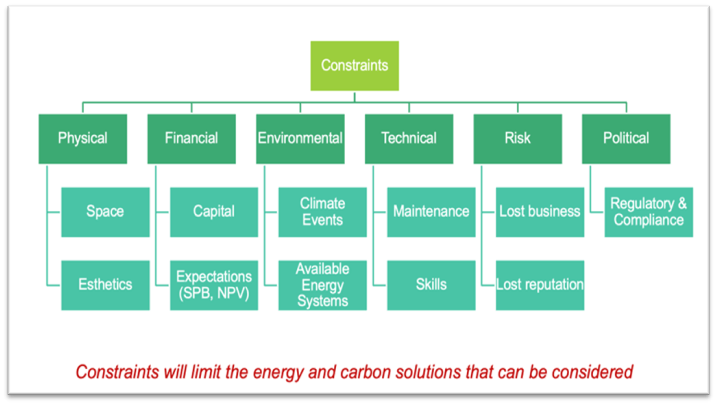

Case Study: Office Tower
An office tower in Alberta Canada was to be converted from office tenants to residential tenants with the city’s objective to rejuvenate the downtown community.
Financial Constraints: Funding for the conversion project depended on a number of constraints, including
• Commercial space must be less than 10%
• Emissions reduction
• Energy reduction
Physical Constraints: The project was also constrained by physical limitations
• No space for solar PV
• Restrictions on the esthetics of the building limited the potential technologies
Environmental Constraints: The building is heated by very old naturally aspirated boilers with very low efficiency. These can easily be upgraded to modern high efficiency boilers
• The project targeted a 30% reduction in carbon emissions with upgrades to HVAC

Exercise 1.5: Identify constraints for Energy Projects
• Using the constraints chart above as an example, identify constraints that must be considered in your energy and emissions strategy.
• These constraints will form the content of the constraint registry.
▢ Physical – Space, esthetics.
▢ Financial – Capital, expectations (simple pay back, net present value).
▢ Environmental – Climate events, available energy systems.
▢ Technical – Maintenance, skills.
▢ Risk – Lost business, lost reputation.
▢ Political – Regulatory and compliance.
▢ Project Scope – insufficient
▢ Time – inappropriate scheduling
▢ Data Quantity – lacking sufficient dataset size
▢ Data Quality – lacking proximal data
▢ Insufficient Resources /Materials /Equipment
▢ Shareholder Conflicts – differing goals and objectives
▢ Location Specific Constraints (e.g., season weather disruptions)
▢ Other
▢ Other
▢ Other
▢ Business Strategy
▢ Data Gathering
▢ Marketing
▢ Sales
▢ Resources

Course Manual 6: Cost Reduction Goal
Cost reduction is a key objective in developing an energy strategy. Energy costs are anticipated to rise no matter where you are located. In some industries, energy costs are the largest cost item behind labour and have significant impacts on the businesses profitability.
There are two ways to reduce energy costs
3. Reduce grid energy consumption
4. Change rate structure / the cost of energy
Reduce Grid Energy Consumption
Reducing the energy you purchase from the grid is always the best way to reduce costs. Energy reduction can take two forms
• Reduce the energy required for the facility
• Generate energy onsite at a lower cost than the grid
The energy your facility requires can be reduced with modern technologies such as heat recovery ventilators, envelope upgrades, LED lighting retrofits, VFD’s. Selecting the right combination of energy reduction technologies is the topic of future workshops and the design of your IGS.
Generating energy (heat and power) onsite will also reduce the energy you need to purchase. The amount of cost reduction depends on the technologies you select for onsite energy production, such as CHP, fuel cells, solar PV, wind, geothermal, etc.. The selection of the right combination of onsite generation technologies is the topic of future workshops. Some technologies have a higher up front cost, but a lower operating cost leading to a lower lifecycle cost of energy.
Exploring Energy Reduction Technologies
Energy reduction technologies are essential in the pursuit of sustainability and efficiency. These technologies strive to reduce energy usage in a wide range of sectors, such as residential, commercial, and industrial applications. These are some of the most influential technologies for reducing energy consumption:
• LED lighting is highly efficient and a top choice for energy conservation. LEDs use much less electricity than traditional incandescent and fluorescent lights. With a longer lifespan, reduced maintenance costs, and lower heat emissions, they are the perfect choice for any indoor or outdoor application. LED lighting has been widely embraced in homes, offices, and street lighting, resulting in significant energy savings on a global scale.
• Smart thermostats provide users with greater control over their heating and cooling systems, resulting in more efficient energy usage. These devices are designed to learn user preferences and make automatic adjustments to temperatures in order to optimize energy use. They can be conveniently controlled from smartphones, allowing for easy adjustments based on occupancy and weather conditions. Smart thermostats are great at reducing energy consumption in residential and commercial buildings by maintaining optimal temperatures.
• HVAC Systems with High Efficiency: HVAC systems play a significant role in consuming energy within buildings. Advanced technologies such as variable speed motors, smart sensors, and improved refrigerants are utilized in high-efficiency HVAC systems to optimize performance and minimize energy consumption. By ensuring regular maintenance and timely upgrades to these systems, you can achieve a substantial reduction in energy consumption and operational costs.
• Insulation and building envelope improvements are crucial for maintaining optimal temperatures inside buildings. By ensuring proper insulation and sealing, we can effectively prevent heat loss during the winter and minimize heat gain during the summer. Various materials, including fibreglass, foam, and cellulose, are commonly used for insulating walls, roofs, and floors. In addition, the thermal performance of buildings can be improved by using energy-efficient windows and doors that have low-emissivity (Low-E) coatings. This can result in lower heating and cooling demands.
• Variable Frequency Drives (VFDs) are commonly employed in electric motors to regulate the motor speed according to the required level, rather than operating at a constant full speed. This technology is especially valuable in industrial applications like pumps, fans, and conveyor systems, where varying loads are prevalent. Through the optimization of motor speed, VFDs effectively minimize energy consumption and reduce the strain on equipment.
• Building Automation Systems (BAS) are designed to seamlessly integrate different building systems, such as HVAC, lighting, security, and fire safety, into one centralized control platform. These systems utilize sensors and automation to constantly monitor and regulate energy usage in real-time, guaranteeing peak performance and maximizing energy efficiency. Implementing BAS can result in substantial energy savings for large commercial and industrial facilities.
• CHP Systems: CHP systems, also called cogeneration, generate both electricity and thermal energy from one fuel source. Utilizing waste heat from electricity generation for heating purposes allows CHP systems to achieve higher overall efficiency compared to traditional power generation methods. These systems are frequently utilized in industrial plants, hospitals, and large commercial buildings.
• Solar PV systems are capable of converting sunlight into electricity by utilizing semiconductor materials. Installing solar panels on rooftops or in solar farms can help decrease dependence on grid electricity and result in reduced energy expenses. Recent developments in PV technology have made solar energy more accessible and cost-effective, resulting in substantial decreases in carbon emissions.
• Energy Management Systems (EMS) are software platforms that monitor, control, and optimize energy use in buildings and industrial processes. These systems gather data from different sources, analyze energy consumption patterns, and offer insights for potential energy-saving opportunities. EMS can result in better decision-making and ongoing enhancements in energy efficiency.
Rate Structures
In some regions, the cost of energy is deregulated and varies hour by hour, which makes budgeting for energy costs very challenging. In these cases, cost certainty may be more important than lowest cost.
Fixed Rates
Historically, many regions have a flat rate for electricity measured as $/kWh. However, with the dramatic increase in demand for electricity, utilities need to significantly upgrade their infrastructure (distribution, transmission, transformers, etc.). In order to delay investments in infrastructure upgrades, some utilities are moving away from fixed rate structures to time of use structures in an attempt to encourage electricity consumers to shift their consumption patterns and balance the grid demand profile.
Time of Use
In a time of used model, the electricity rates depend on when you consumed the electricity. The idea is that when there is high demand on the electricity grid, the rates are higher. When there is lower demand on the grid, the rates are lower in an attempt to encourage consumers to shift the time of their electricity demand.
Rates are often broken down into
• On Peak rates – periods where the demand on the electricity grid is the highest
• Mid Peak rates – shoulder periods between on peak and off peak
• Off Peak rates – periods where the demand on the electricity grid is the lowest
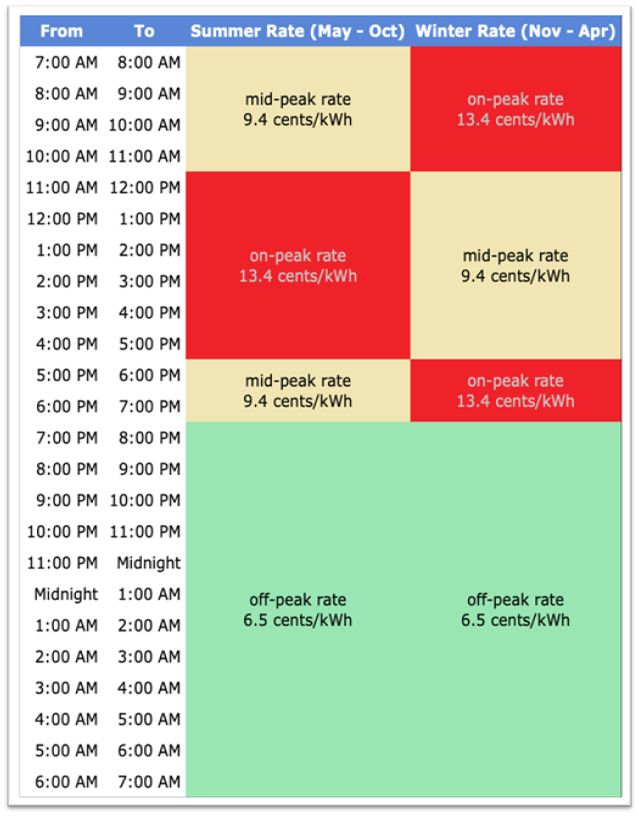
Since the objective of these schemes is to encourage consumers to shift the time of their electricity consumption, the time of use rates can also vary from month to month or season to season.
In this example from Ontario Canada, the time of use model is broken down into on peak, mid peak and off peak rates. The rates also change between summer and winter.
While a number of jurisdictions are considering the value to move to a time-of-use rate structure, it is not clear that this model achieves the goal of shifting electricity consumption patterns.
Deregulated Markets
There are a number of examples of deregulated electricity markets, such as Alberta Canada and Texas USA. In these markets, electricity producers are able to bid into a regulated market. The electricity grid operator will accept the lowest bids ($/kWh) first and continue to accept bids until the demand for the region is met. The idea is that this ensures the lowest cost electricity for the consumers.
In this example from the deregulated market in Alberta Canada, we are showing the fixed electricity rate (orange line) and the hourly pool price (blue line). Clearly the pool price fluctuates significantly making it challenging to prepare for monthly budgets. The fixed electricity rate provides a degree of cost certainty which makes it easier to budget. However, this is not the lowest cost solution.
Allowing your electricity rates to float with the pool prices means that there are many times where you are paying much less than the fixed rate, but also means that when there are issues on the grid (which you have no control over) the grid rates will significantly increase. However, this also provides the ability for facilities to implement onsite generation and sell excess electricity back to the grid when the grid rates are very high. Onsite generation with CHP, fuel cells, batteries and solar PV have the advantage to generate power at a budget-able low rate and then sell power back to the grid at a high rate.
A high density residential site in Calgary Alberta generates their own power with a CHP – which can provide electricity at $0.07/kWh to $0.12/kWh (depending on the season and how much heat is recovered). There are many hours in the year where the grid electricity rate exceeds the cost to generate power and the site can sell electricity back to the grid at significant profit.
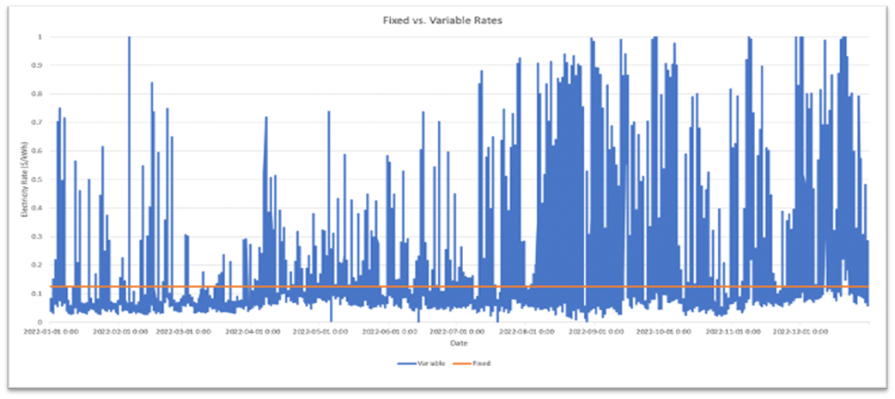
The chart above shows the hourly electricity grid rates for 2022. Forecasting the grid rates is challenging, but in general we see spikes in the electricity rates when it is very hot (June to October) or very cold (November to January).

Case Study: Onsite Electricity Generation
We understand the importance of optimizing energy usage and minimizing costs for businesses in Alberta. One effective strategy to achieve these goals is through onsite electricity generation. In this article, we will outline the numerous benefits of implementing onsite energy generation in Alberta, focusing on the advantages it brings to businesses and institutions. By adopting this approach, you can not only reduce expenses but also contribute to a greener and more resilient energy future.
Benefits:
1. Grid Rate Arbitrage: Onsite electricity generation enables businesses to take advantage of grid
rate arbitrage. By generating electricity during low-demand periods and selling it back to the grid
during high-demand periods, businesses can optimize their energy costs and maximize their
savings.
2. Reduce Peak Demand Costs: Peak demand charges can account for a significant portion of a
business’s electricity costs, ranging from 40 to 50%. Onsite generation allows businesses to
generate electricity during peak hours, reducing their reliance on the grid and lowering their peak
demand charges.
3. Selling Back to the Grid: Under the Micro Generation Act rules, businesses with onsite generation
can sell excess electricity back to the grid at pool rates. This provides an additional revenue
stream and further reduces energy costs.
4. Managing Variable Grid Rates: Grid rates can vary depending on factors such as time of day,
season, and market conditions. Onsite generation allows businesses to manage their electricity
costs more effectively by generating power when grid rates are high and relying on the grid during
periods of lower rates.
5. Participation in the Operating Reserves Market: Onsite generation enables businesses to
participate in the Operating Reserves Market. By providing power to the grid during times of
system stress or emergencies, businesses can earn additional revenue while supporting grid reliability.
6. Reduce GHG Emissions: Onsite generation using renewable energy technologies such as solar
PV or with Combined Heat and Power can significantly reduce greenhouse gas (GHG) emissions
helping businesses lower their carbon footprint and contribute to a cleaner environment.
7. Resilience in Grid Outages: Onsite generation provides businesses with a reliable source of
power during grid outages or disruptions. By ensuring a continuous supply of electricity,
businesses can minimize downtime, maintain critical operations, and avoid financial losses.
Technologies for Onsite Electricity Generation:
Solar PV: Solar photovoltaic systems harness sunlight to generate electricity. Although solar power is
intermittent, it offers low operating costs and emits no GHGs, making it a sustainable and cost-effective
option for onsite generation.
Combined Heat and Power (CHP): CHP systems produce both electricity and useful heat simultaneously.
These systems operate as base load power sources and can be triggered to generate power when grid
rates are high, providing businesses with additional cost savings.
Backup Generators: Backup generators are a reliable and affordable option for onsite electricity
generation. While they have the lowest cost per MWh to implement, they waste the heat generated and
can increase GHG emissions.
Fuel Cells: Fuel cells generate electricity through an electrochemical process. Although fuel cells are still
relatively expensive, advancements are being made. Sourcing and storing hydrogen for fuel cells can be
challenging and costly. However, companies like Bloom Energy offer fuel cells that can utilize natural gas
as a cleaner and more accessible fuel source.
Who Should Consider Implementing Onsite Generation:
Several types of facilities can benefit from implementing onsite energy generation:
• Industrial Facilities: Manufacturing plants, refineries, and other industrial facilities with high energy demands can significantly reduce costs and emissions through onsite generation.
• Institutional Facilities: Hospitals, universities, and government buildings can enhance their energy resilience and reduce expenses by adopting onsite generation solutions.
• Commercial Facilities: Shopping malls, hotels, and office buildings can take advantage of onsite generation to optimize energy costs and improve their environmental footprint.
• Facilities with High Transmission and Distribution Charges: Businesses facing high transmission and distribution charges can alleviate the financial burden by generating a portion of their electricity onsite.
• Facilities with High Electricity Rates: Businesses paying electricity rates over $0.10/kWh can achieve substantial cost savings by implementing onsite generation, especially during peak demand periods.
Conclusion
In conclusion, onsite electricity generation in Alberta offers numerous benefits for businesses and institutions. From reducing costs through grid rate arbitrage and selling back to the grid to minimizing GHG emissions and ensuring energy resilience, the advantages are significant. By considering technologies such as solar PV, CHP systems, backup generators, or fuel cells, businesses can tailor their onsite generation solutions to their specific needs. Whether you operate an industrial facility, an institutional establishment, or a commercial enterprise, onsite energy generation can pave the way towards a more sustainable and cost-effective future.

Exercise 1.6: Discussion
• What is the structure of your electricity contract (fixed rate, time of use, floating)?
• Is there opportunity to shift your electricity consumption to periods with lower rates?
• Will electricity storage provide a cost advantage?

Course Manual 7: Emissions Reduction Goal
Emissions reduction used to be a “nice to have” benefit but has now become a critical component in a business energy strategy. Businesses with a sustainability record are recognized as more valued by their customers. For example, hotels and resorts have seen the greatest success with a 50% increase in bookings when they can demonstrate their sustainability successes.
Addressing emissions, especially greenhouse gases like carbon dioxide, methane, and nitrous oxide, is crucial for combating climate change and enhancing air quality. These are some of the most influential emissions reduction technologies:
• CCUS technologies are capable of capturing CO2 emissions from various sources such as industrial facilities, power plants, and even directly from the atmosphere. CO2 can be transported and stored underground in geological formations or used in industrial processes like enhanced oil recovery or the production of carbon-based products. CCUS plays a crucial role in reducing overall emissions by preventing CO2 from reaching the atmosphere.
• Renewable energy technologies, such as solar, wind, hydro, and geothermal, have the advantage of producing electricity without emitting greenhouse gases. Solar photovoltaic (PV) panels generate electricity by capturing sunlight, while wind turbines utilize wind energy. Hydropower harnesses the power of flowing water, while geothermal systems utilize the Earth’s heat. Transitioning to renewable sources can significantly decrease emissions from the energy sector.
• Improving Energy Efficiency: Boosting energy efficiency in buildings, industrial processes, and transportation helps to decrease overall energy demand and, as a result, reduces emissions. Various technologies, including LED lighting, high-efficiency HVAC systems, and energy-efficient appliances, help reduce energy consumption. Optimizing processes and equipment through automation and advanced control systems in industrial settings can result in substantial reductions in emissions.
• Hydrogen fuel cells (and solid oxide fuel cells) generate electricity and heat by harnessing the power of a chemical reaction between hydrogen and oxygen. As a result, they produce nothing but water vapour and heat as by-products. Hydrogen is expensive to produce and store. Solid Oxide Fuel Cells (SOFC) use a methane stream such as natural gas, and reform the methane to separate the hydrogen from the carbon. With additional carbon capture technology, a SOFC can have no atmospheric emissions.
• Bioenergy and Biofuels: Energy can be generated from organic materials, like plant and animal waste. Biofuels, such as ethanol and biodiesel, are derived from biomass and have the potential to serve as alternatives to traditional fossil fuels in the transportation sector. Advanced biofuels, made from non-food feedstocks such as algae and agricultural residues, provide even more significant reductions in emissions and sustainability advantages.
• Waste-to-Energy Technologies: Waste-to-energy (WTE) technologies transform municipal solid waste and industrial waste into energy using methods such as incineration, gasification, and anaerobic digestion. These technologies help to decrease emissions by redirecting waste away from landfills, where it would generate methane, a powerful greenhouse gas. In addition, WTE offers a renewable energy source, which helps to decrease dependence on fossil fuels.
• Carbon offsetting is a method of compensating for emissions by investing in projects that reduce or remove CO2 from the atmosphere. Some examples are reforestation, afforestation, and soil carbon sequestration projects. These initiatives help absorb CO2 through natural processes, which in turn helps offset emissions from other sources.
• Smart grids improve the efficiency and reliability of electricity distribution through the integration of digital communication technologies. They facilitate improved demand response, grid management, and the incorporation of renewable energy sources. Through the optimization of energy distribution and the reduction of losses, smart grids play a crucial role in decreasing emissions from the energy sector.
Regulatory Models
With the “cap and trade” model, governments put a cap on the emissions permitted for organization in a particular industry. These caps decrease over time motivating organizations to take steps to reduce emissions. If a business is able to reduce their emissions below the cap, they are then able to sell their allowable emissions to organization that cannot meet their cap. Hence the “cap and trade” model.
Other regions have implemented a carbon pricing scheme which is more of a market driven approach. In this scheme, if a business is able to reduce their emissions with solutions such as hydro power, wind power, solar power and bio-gas heat and power, they can certify their emissions reductions into a renewable energy credit (REC) and then sell the REC to organizations that cannot meet their emission reduction targets. The market to buy and sell REC’s is relatively new and regulations are being developed to properly manage the market.
Post-Secondary Institutions
Post-secondary institutions started out well by being the first industry, all over the world, to publish their net zero goals and commitments; unfortunately, they failed to develop a plan on how to achieve their objectives.
Most universities and colleges around the world have published their commitments to reach net zero or net negative emissions by 2030. These will be very difficult to achieve, but the academic institutions have the advantage to work with emerging technologies to test and refine their performance
By 2030, the University of Toronto wants to cut emissions by 37% from 1990 levels. They introduced the Low-Carbon Action Plan (2019–24) in 2019 and have already started a number of noteworthy projects that will help them reach the 2030 target.
With the help of the UBC Climate Action Plan 2030, the institution will speed its journey toward net zero emissions for buildings and energy supplies over the next 15 years, as well as a considerable reduction in greenhouse gas emissions for areas with extended impacts. UBC has the advantage of access to a significant source of bio-waste (wood products) that can be used to generate carbon free heat and power.
Princeton’s new goal is to achieve net zero campus greenhouse gas emissions by 2046 or earlier. This entails lowering indirect emissions from purchased power as well as direct emissions from fleet fuel consumption and on-site energy production. We are also starting targeted research of construction materials procurement techniques as part of the larger requirement to affect indirect emissions sources.
In addition to infrastructure and other structural improvements, community and individual behaviours and habits are also essential to achieving carbon neutrality. Therefore, there are efforts afoot to involve members of the university community who wield influence in high-energy situations, such laboratories and expansive event venues.
Industry
Industrial clients have been slower to move toward emissions reduction, as their operations are very complex, but executives recognize the need to start the transition for their industry to survive. Many jurisdictions have implemented regulations that require industrial clients to reduce their emissions. For example, the carbon tax structures in Canada and Europe put limits on the carbon emissions permitted. Exceeding these limits requires that the organization purchase carbon credits or pay a fine.
The oil and gas sector is a major contributor to carbon emissions. In Canada, oil and gas is responsible for over 30% of the total national emissions. The governments has invested heavily in the development of emissions reduction technologies to address this issue. The government has also implemented a carbon tax to encourage large emitters to invest in emissions reduction.
Hotel/Resorts
Hotels can aim to cut their greenhouse gas emissions by 20%. The hotel can take steps to encourage sustainable habits, like encouraging visitors to use public transportation, employing renewable energy, and using carbon credits to offset emissions. The hotel can then measure its carbon footprint and track its greenhouse gas emissions to keep an eye on its development.
Hotels can aim to encourage environmentally conscious travel by teaching visitors about the local way of life, customs, and culture. The hotel can encourage guests to support local companies, provide eco-tours, and provide sustainable transportation options as ways to promote sustainable practices. By polling visitors and gauging their level of satisfaction with the hotel’s sustainable tourism initiatives, the hotel can then keep an eye on its development.
Hotels can make it a priority to provide their visitors with sustainable food and drink alternatives. The hotel may limit food waste, do away with single-use plastics, and source its food and beverage goods from fair trade, organic, and local sources in order to support sustainable practices. The hotel may then measure visitor satisfaction with sustainable food and beverage selections and keep tabs on its purchasing habits for food and beverages.
Hotels are substantial energy consumers, as their operations run continuously, 24 hours a day, 365 days a year. The persistent need for energy leads to significant emissions of greenhouse gases (GHGs), highlighting the importance for the hospitality sector to implement efficient methods to reduce these emissions. By implementing these measures, not only can the environment be protected, but operational expenses can also be reduced and the hotel’s reputation among eco-conscious tourists can be enhanced. Below are several effective measures that hotels can apply to minimize their emissions, along with instances of successful implementation.
Energy Efficiency
Lighting: Upgrading to energy-efficient lighting is a straightforward and very effective method for reducing energy use. Substituting incandescent bulbs with LED lights can decrease energy consumption by as much as 75% and have a lifespan that is up to 25 times longer.
The Best Western Plus in Thunder Bay, Canada, carried out a lighting makeover by substituting conventional bulbs with LED lights. The implementation of this renovation led to an annual cost reduction of $12,800 and a substantial decrease in the hotel’s carbon emissions.
Optimizing HVAC Systems: HVAC systems contribute to around 40% of the total energy expenses of a hotel. Installing high-efficiency HVAC systems and utilizing occupancy-based controls can result in significant reductions in energy consumption.
The Hilton Santa Clara in California implemented a fuel cell system to supply constant power for the hotel. This technology guarantees a dependable electricity provision, hence minimizing the requirement for energy-consuming HVAC operations during periods of high demand.
Renewable Energy Generation
Solar PV: By implementing solar panels, a hotel can greatly diminish its dependence on fossil fuels and decrease greenhouse gas emissions. Solar energy may be harnessed to fuel a range of hotel functions, including illuminating spaces and heating water.
The Hotel Verde in Cape Town, South Africa, has incorporated solar panels into its electricity infrastructure. The hotel harnesses a substantial amount of its electricity from solar power, so diminishing its carbon impact and cutting down on energy expenses.
Wind Turbines
Hotels can install wind turbines in areas with favorable wind conditions to produce sustainable electricity. This can additionally decrease dependence on the power grid and decrease emissions.
For instance, the Hilton Fort Lauderdale Beach Resort in Florida has just implemented a compact wind turbine on its rooftop. This turbine produces renewable energy, helping the hotel achieve its sustainability objectives and decreasing its overall emissions.
Water Conservation
Water-saving fixtures: By installing low-flow faucets, showerheads, and toilets, one can greatly decrease water usage and the amount of energy needed to heat water. The Atria Assisted Living complex in Foster City, California, implemented the use of low-flow fixtures across the whole complex. This technique not only decreased water usage but also decreased the energy required for heating water, thereby contributing to total reductions in emissions.
Greywater Recycling
Greywater recycling involves the installation of equipment that enable hotels to reuse water from sinks, showers, and laundry for non-potable activities, such as irrigation and toilet flushing. The Ritz-Carlton, located in Charlotte, North Carolina, implements a greywater recycling system to repurpose water for the purposes of irrigation and toilet flushing. This method aids in water conservation and minimizes the energy needed for water treatment and heating.
Waste Management and Recycling
Hotels have the ability to establish extensive recycling programs in order to decrease the amount of waste that is disposed of in landfills. Engaging in the recycling of materials such as paper, plastic, glass, and metal can effectively reduce the emissions that are linked to the process of garbage disposal. The Fairmont Waterfront Hotel in Vancouver, Canada, has a comprehensive recycling program that encompasses the composting of organic waste. This initiative has greatly diminished the hotel’s waste footprint and the emissions connected to it.
Reducing food waste can be achieved by implementing programs that involve giving excess food and composting, which can effectively decrease emissions. The Hyatt Regency Orlando in Florida has a food waste reduction initiative, wherein surplus food is donated to local shelters and organic trash is composted. This program has effectively decreased the hotel’s expenses related to waste disposal and its greenhouse gas emissions.
Building Management Technologies
Building Management Systems (BMS) are capable of enhancing energy efficiency by overseeing and regulating lighting, HVAC, and other systems in accordance with occupancy and real-time data. The Marriott Marquis in New York City employs an advanced Building Management System (BMS) to efficiently regulate its energy usage. The implementation of the system has resulted in a 20% decrease in the hotel’s energy use, resulting in substantial financial savings and a reduction in emissions.
Internet of Things
The integration of Internet of Things (IoT) devices and smart sensors can optimize energy efficiency through the provision of real-time data and the facilitation of automated adjustments. The InterContinental Hotel in San Francisco has used Internet of Things (IoT) gadgets and intelligent sensors to oversee and regulate energy consumption. This technology has enhanced the hotel’s energy efficiency and diminished its carbon footprint.
Employee and Guest Involvement
Staff Training: Providing training to employees on energy conservation techniques can result in substantial reductions in energy consumption. Employees might be incentivized to switch off lights, disconnect gadgets, and report instances of energy wastage. The Radisson Blu Hotel in Berlin, Germany, implements a comprehensive staff training program that specifically emphasizes energy efficiency. This program has enabled employees to proactively adopt measures to decrease energy consumption, thereby supporting the hotel’s sustainability objectives.
Guest Awareness Programs
By involving visitors in sustainability measures, such as implementing programs for reusing towels and linens, it is possible to decrease energy and water usage. The Kimpton Hotel Monaco in Portland, Oregon, implements a guest awareness program that promotes visitor participation in the reuse of towels and linens. This project has effectively decreased the hotel’s energy use and water usage for laundry, resulting in a significant reduction in overall emissions.
Conclusion
Hotels must implement a comprehensive emission reduction strategy in order to decrease their carbon footprint, decrease operational expenses, and satisfy the increasing desire for environmentally friendly lodging. Hotels can achieve substantial reductions in their greenhouse gas (GHG) emissions by implementing energy efficiency upgrades, incorporating renewable energy sources, implementing water conservation measures, improving waste management practices, utilizing smart building technology, and involving staff and guests.
These initiatives not only have a positive impact on the environment, but also boost the hotel’s reputation, attract environmentally conscious travelers, and increase financial performance. In order to achieve long-term success and resilience, it is crucial for the hospitality industry to adopt sustainability and energy efficiency practices while it undergoes continuous evolution.
Commercial Real Estate
According to a report from Cortex Sustainability Intelligence released on December in 2023, pressure from investors, tenants, and regulatory obligations will increase for owners of commercial real estate in 2024, forcing it from the periphery to the forefront of corporate strategy.
The commercial real estate sustainability trends report notes that a lack of common vocabulary and methodology makes it difficult to measure and report on decarbonization efforts.
In the commercial real estate (CRE) industry, there is a competition to be the best environmental steward. Public entities are being pressured to standardize their approach to climate change measurements by environmental, social, and governance (ESG) reporting standards; eventually, these disclosures are likely to trickle down to some private entities as well. Additionally, there is the growing financial case for climate action as investors and consumers seek for more dependable, consistent approaches.
Reducing carbon emissions benefits CRE companies’ bottom line as well as investors, tenants, other customers, and staff. It’s not just an environmental priority. Then, the issue becomes where to start.
• Despite the fact that the commercial real estate sector contributes significantly to global carbon emissions, it lacks a standardized climate action plan.
• Ignoring how climate change is affecting commercial real estate carries a number of concerns, such as increased expenses and eventually declining values.
• The expenses of green building modifications can be partially mitigated for real estate stakeholders by tax incentives related to electrification, energy efficiency, and renewable energy.
Commercial real estate plays a substantial role in the overall release of greenhouse gases (GHG) worldwide, mainly because of the energy consumption required for heating, cooling, and powering buildings. With the increasing need to address climate change, owners and managers of commercial real estate (CRE) are facing mounting pressure from investors, tenants, and regulatory agencies to decrease their carbon emissions. Implementing efficient emission reduction measures not only benefits the environment but also increases property value, decreases operating expenses, and fulfills the increasing need for sustainable buildings. Below are essential tactics for mitigating emissions in the commercial real estate sector, accompanied by instances of effective execution.
Energy Efficiency
Lighting: Transitioning to energy-efficient lighting, such as LED lights, can substantially decrease energy usage. LEDs consume up to 75% less energy and have a lifespan up to 25 times longer than conventional incandescent bulbs. The Empire State Building completed a thorough retrofit that including updating to lighting systems that are more energy-efficient. The project achieved a 38% decrease in energy usage, resulting in annual savings of $4.4 million and a reduction of 105,000 metric tons of CO2 emissions over a span of 15 years.
HVAC System Optimization
Heating, ventilation, and air conditioning (HVAC) systems contribute significantly to the energy consumption of a structure. Installing high-efficiency HVAC systems and utilizing smart controls can result in significant reductions in energy consumption. The Salesforce Tower in San Francisco is equipped with a cutting-edge HVAC system that utilizes advanced controls to maximize energy efficiency. This system plays a role in the building’s achievement of LEED Platinum certification and greatly decreases its carbon impact.
Renewable Energy
Solar Panels: The installation of solar panels can significantly decrease a building’s dependence on fossil fuels and decrease greenhouse gas emissions. Solar energy can be harnessed to provide power for a range of building functions, including lighting and HVAC systems. The Bullitt Center in Seattle, commonly known as the “most environmentally friendly commercial building globally,” features a rooftop solar array that produces an annual surplus of energy compared to the building’s consumption. The building’s carbon footprint is greatly reduced due to its net-positive energy performance.
Wind Turbines: Wind turbines can be installed in areas with favorable wind conditions to generate sustainable energy and further decrease emissions. The Hilton Fort Lauderdale Beach Resort in Florida has just implemented a compact wind turbine on its rooftop. This turbine produces renewable energy, aiding the hotel in achieving its sustainability objectives and lowering its total emissions.
Water Conservation
Low-flow fixtures, such as faucets, showerheads, and toilets, can greatly decrease water usage and the energy needed to heat water. The Atria Assisted Living complex in Foster City, California, implemented the use of low-flow fixtures across the whole complex. This solution not only decreased water usage but also decreased the energy required for water heating, thereby contributing to overall reductions in emissions.
Greywater Recycling
Greywater recycling involves the installation of systems that enable buildings to reuse water from sinks, showers, and laundry for non-potable activities, such as irrigation and toilet flushing. The Ritz-Carlton, located in Charlotte, North Carolina, implements a greywater recycling system to repurpose water for the purposes of irrigation and toilet flushing. This method aids in water conservation and minimizes the energy needed for water treatment and heating.
Waste Management and Recycling
By implementing thorough recycling systems, the amount of waste that is disposed of in landfills can be significantly reduced. Engaging in the recycling of materials such as paper, plastic, glass, and metal can effectively reduce the emissions that are linked to the disposal of garbage. The Fairmont Waterfront Hotel in Vancouver, Canada, has a comprehensive recycling program that encompasses the composting of organic waste. This program has greatly diminished the hotel’s trash footprint and the corresponding emissions.
Reducing food waste can be achieved by implementing programs that involve giving excess food and composting. These initiatives can effectively contribute to the reduction of emissions. The Hyatt Regency Orlando in Florida implements a food waste reduction initiative that involves donating excess food to nearby shelters and composting organic trash. This program has effectively decreased the hotel’s expenses related to waste disposal and its greenhouse gas emissions.
Smart Building Technologies
Building Management Systems (BMS): A BMS can enhance energy efficiency by overseeing and regulating lighting, HVAC, and other systems according to occupancy and real-time data. The Marriott Marquis in New York City utilizes an advanced Building Management System (BMS) to effectively control and monitor its energy usage. The implementation of the system has resulted in a 20% decrease in the hotel’s energy use, resulting in notable financial savings and a reduction in emissions.
Internet of Things
The integration of Internet of Things (IoT) devices and smart sensors can optimize energy efficiency by offering real-time data and facilitating automated adjustments. The InterContinental Hotel in San Francisco has employed Internet of Things (IoT) gadgets and intelligent sensors to oversee and regulate energy consumption. This technology has enhanced the hotel’s energy efficiency and diminished its carbon footprint.
Employee and Tenant Engagement
Staff Training: Providing training to employees on energy conservation techniques can result in substantial energy savings. Employees might be incentivized to switch off lights, disconnect gadgets, and report instances of energy wastage. The Radisson Blu Hotel in Berlin, Germany, implements a comprehensive staff training program that specifically emphasizes energy efficiency. This program has enabled employees to proactively adopt measures to decrease energy consumption, thereby supporting the hotel’s sustainability objectives.
Tenant Awareness Programs: Involving tenants in sustainability initiatives, such as organizing energy-saving competitions and implementing green leasing agreements, can effectively decrease energy and water usage. The Kimpton Hotel Monaco in Portland, Oregon, has a tenant awareness program aimed at promoting tenant engagement in energy-saving activities. This project has effectively decreased the hotel’s energy consumption and water usage, resulting in a significant reduction in overall emissions.
Conclusion
It is crucial for commercial real estate to adopt a comprehensive emission reduction strategy in order to decrease its carbon footprint, decrease operational expenses, and fulfill the increasing need for sustainable buildings. Commercial real estate can achieve substantial reductions in greenhouse gas (GHG) emissions by implementing energy efficiency improvements, integrating renewable energy sources, implementing water conservation measures, increasing waste management practices, utilizing smart building technology, and actively involving employees and renters.
These solutions have multiple advantages, including environmental benefits, increased property value, attraction of eco-conscious renters, and improvement of financial performance. In order to achieve long-term success and resilience, it is imperative for the commercial real estate business to adapt to the changing landscape by adopting sustainable practices and prioritizing energy efficiency.

Case Study: Hotel in Caribbean
The electricity rates for a Caribbean hotel ranged from $0.55/kWh in 2022 to $0.29/kWh in 2024. The largest energy consumer is the need for air conditioning (40-60% of electricity consumed) which is required in every month.
The hospitality sector in the Caribbean is acutely aware of the impact of climate change with storms increasing in frequency and intensity. As such, most Caribbean nations have strong emissions reduction goals.
The IGS considered a wide range of technologies to find combinations that reduced both the energy cost as well as the emissions. This resulted in identifying:
• Intelligent air conditioning for the guest suites
• Solar PV
• Bio-digester and CHP
The Intelligent air conditioning recognizes that guests are only in their rooms 40% of the time. Sensors determine when a human is not present and resets the thermostat to a higher temperature. When the human returns, the thermostat is returned to human control and the room cools down in only a few minutes.
The financial savings for this technology are very compelling. The project cost of $165k has a simple payback of less than one year, and a very strong NPV as well as reducing emissions by 14%.

Solar PV was also available on a parking lot roof. A 550kW array also provided very strong financial returns as well as further reducing emissions by 11%.

Perhaps the most significant emissions reduction is a bio-digested combined with a CHP. The food waste from the restaurants can be fed into a small bio-digested to create bio-gas. The bio-gas is burned in the CHP to provide heat and power for the hotel. This resulted in a significant emissions reduction (given that the bio-gas is considered to be emissions free fuel).

Combining these technologies, the hotel can achieve over a 70% reduction in emissions which still demonstrating a very strong NPV and simple payback.


Exercise 1.7: Emissions Reductions Targets
• Do your customers care about emissions reductions?
• How will publishing emissions reductions impact your business?
• Does your organization have executive that care about emissions reductions? What is their motivation?

Course Manual 8: Energy Security Goal
The four pillars of energy security are affordable, available, reliable and sustainable.
Due to its uneven distribution, the global energy supply is influenced by a number of factors. Among them are:
• Physical factors: More accessible fossil fuels are probably found in areas with a predominance of sedimentary geology than in other areas.
• Costs: Extraction procedures become exceedingly costly as non-renewable energy sources are depleted. Because of this, the exploitation of these resources is only feasible when demand grows, which frequently leads to an increase in energy prices that are necessary to cover the expenses of extraction and production.
• Technology: The discovery of new energy sources was made possible by advances in technology. Technology contributes to the increased productivity and economic viability of renewable energy sources, notwithstanding the considerable potential for environmental harm.
• Political factors: International conflicts and other sociopolitical problems have a strong potential to destroy energy sources and interrupt the supply of energy.
Energy insecurity, as opposed to energy security, is what businesses go through when there is a disruption in the supply of energy sources or when the cost of energy rises. Numerous issues might arise from energy insecurity, including the following aspects:
• Economic energy insecurity: High energy costs place a significant financial strain on businesses
• Physical energy insecurity: Inadequate lighting, malfunctioning heating and cooling systems, and other physical infrastructure flaws can raise energy expenses, compromise thermal comfort, and expose people to danger.
• Behavioural energy insecurity: Harmful coping mechanisms for the effects of both physical and economic energy instability put people’s health, safety, and the stability of their homes at danger.
Reducing reliance on a small number of energy suppliers or sources promotes diversification and the introduction of sustainable substitutes. By using this tactic, states, regions, and countries can further strengthen energy security and protect themselves from energy interruptions.
To reduce reliance on imports, they can also think about changing suppliers. Achieving complete self-sufficiency can be accomplished through utilizing their own resources and utilizing alternative energy sources, like cleaner solar and wind energy.
Energy security is critical to some organizations and a ‘nice-to-have’ in others. For example, hospitals cannot tolerate failures in their power grid, as lives depend on the equipment. Senior care facilities are also sensitive to failures in power and heat, which provide the requirements of life for their tenants. Grocery stores can lose millions of dollars in inventory when refrigeration systems fail.
Hotels and resorts depend on guest comfort to establish their reputation, which is critical for long-term success; therefore, outages in power or heat cost much more than the physical repair requirements.
The primary goal for energy security is to provide sufficient power to continue operating the critical systems during a power failure. Therefore, the first step is to identify those systems that are critical and have a significant impact on the business. The non-critical systems likely do not need backup power. This then tells us how much power is required.
The next question is “for how long”? There are energy storage solution that work well for short outages (less than 4 hours) and others that can provide critical power for many days or weeks.
Batteries
Electricity storage is often the first “go-to” for energy security solutions. But these are often expensive and have limited value beyond providing power in a grid failure. Alternately, onsite power generation provides value all the time – not just during an outage. These solutions include natural gas CHP, natural gas generators, solid oxide fuel cells, solar PV. Each of these onsite generation solution have their pros and cons and need to be assessed when designing a solution for energy security.
Today’s market is full of several battery types, with many more coming soon. Lead-acid, flow, and lithium batteries are the three primary battery types that are commonly utilized in microgrids. When it comes to applications that concentrate on short-term power, medium-term energy, or long-duration energy storage (LDES), each battery type has advantages.
Flow Batteries
Despite being available for a while, flow battery technology has garnered a lot of attention in recent years. Numerous businesses are striving to refine this energy-storage technique. Flow batteries use a fluid instead of a solid substance to store energy. The fluid passes through a membrane and electricity is extracted from it when the battery needs electricity. This technique shows promise and could find many stationary applications in the future.
Flow batteries have the advantage that they do not degrade with charge/discharge cycles. However, they are very large and heavy which limit their applications.
An example of a flow battery utilizes salt water for energy storage (kWh) which is very inexpensive. These salt water flow batteries can scale to very large energy storage and can last for many days.
Flow batteries, also referred to as redox flow batteries, are a cutting-edge form of energy storage technology that provides distinct benefits for large-scale energy storage applications. These batteries are ideal for integrating renewable energy sources into the grid, offering a reliable and flexible solution for energy management. Let’s take a closer look at the mechanics of flow batteries, the advantages they offer, and the various areas where they can be applied:
Operating Principle:
Flow batteries store and generate electricity by utilizing the redox reactions of two liquid electrolytes stored in separate tanks. The electrolytes flow through a cell stack, exchanging ions across a membrane to generate an electric current. Flow batteries consist of several essential components:
• Electrolyte Tanks: These hold the liquid electrolytes used for energy storage. Usually, there is a tank with a positively charged electrolyte (catholyte) and another tank with a negatively charged electrolyte (anolyte).
• Cell Stack: The cell stack is the central component where the redox reactions take place. The system is made up of several cells that contain electrodes and an ion-exchange membrane. Just as the electrolytes flow through the cells, they undergo redox reactions, which leads to the transfer of electrons and the production of electricity.
• Pumps and Pipes: These pumps and pipes are responsible for circulating the electrolytes between the tanks and the cell stack, ensuring the battery operates smoothly without any interruptions.
• Power Conversion System: This system is responsible for managing the conversion of stored chemical energy into electrical energy and vice versa. It enables the battery to charge and discharge as required.
Benefits of Flow Batteries:
• Flow batteries offer excellent scalability, allowing for easy adjustment to meet different energy storage needs. This can be achieved by increasing the size of the electrolyte tanks. These qualities make them perfect for large-scale energy storage applications, such as grid support and renewable energy integration.
• Flow batteries offer a significantly longer operational life when compared to conventional lithium-ion batteries. These devices can withstand thousands of charge and discharge cycles without significant degradation, ensuring consistent performance for an extended period of time.
• With the ability to seamlessly transition between charging and discharging modes, these batteries provide incredibly fast response times. This flexibility is essential in maintaining a balance between supply and demand in the power grid and providing support for intermittent renewable energy sources.
• Flow batteries have the advantage of being able to be discharged to a very low state of charge without causing any harm to the system. This sets them apart from traditional batteries, which often experience a reduced lifespan when subjected to deep discharges.
• Flow batteries offer enhanced safety and stability due to the separation of the electrolyte storage from the cell stack. This design minimizes the risk of thermal runaway and fire hazards, making flow batteries an ideal choice for large-scale installations.
Lithium Batteries
Lithium batteries are useful for a wide range of tasks and allow us to power portable electronics like laptops and cellphones. Lithium batteries are currently utilized in autos and huge microgrid systems, therefore they are not just confined to modest applications. But using lithium in these massive applications requires an exponential increase in battery complexity; it’s not as easy as charging and discharging like lead-acid batteries are used to. Because of its complexity, a Battery Management System (BMS) is needed to control the lithium battery’s whole life, including cell balancing, charging, and discharging.
Utilizing lithium batteries has the following advantages:
• High energy density: Lithium batteries have an average energy density of five to six times that of lead-acid batteries, depending on the particular batteries.
• Long cycle life: Before the battery capacity drops to 80%, high-quality lithium batteries can normally run for 3,000–4,000 times. A good lead-acid battery can run for 400–500 cycles before losing 50% of its capacity.
• Quick charging: Devices and automobiles can operate more quickly thanks to lithium batteries’ capacity for quick charge.
• Reduced self-discharge rate: Compared to lead-acid batteries, lithium-ion batteries have a lower self-discharge rate, which allows them to hold a charge for longer periods of time without experiencing a noticeable loss.
Drawbacks of lithium batteries include:
• Greater initial cost: Compared to lead-acid batteries, lithium-ion batteries usually have a higher beginning cost. This initial expenditure may be a turnoff in certain applications, even if the cost has been declining.
• Temperature sensitivity: If exposed to extremely high or low temperatures, lithium-ion batteries may have malfunctions and have a shorter lifespan. Most of the time, temperature-controlled conditions are necessary. Temperatures between 40 and 110 degrees Fahrenheit are ideal for lithium operation.
• Safety concerns: There are several varieties of Li-ion batteries available, and each has a different performance and safety profile. Even if the LFP li-ion is thought to be safer than the other varieties, safety precautions have to always be included.
Gravity Batteries
Another mechanism to store energy utilizes the potential energy due to gravity. These potential energy batteries include:
• Pumped hydro where water is pumped from a lower reservoir to a higher reservoir and then released later through a turbine
• Pumped air storage, where compressed air fills an air tight volume such as a mine shaft or a bladder submerged under water
• Heavy lift, where a heavy object is lifted and then later released to turn a turbine. Existing mine shafts have been used for this purpose as they benefit from a large elevation gain.
Gravity-based electricity batteries, also referred to as gravity energy storage systems or gravity batteries, are a cutting-edge and up-and-coming technology created to store and release energy by harnessing the power of gravity. These systems provide a sustainable and potentially cost-effective solution for energy storage, making them well-suited for integrating renewable energy sources into the power grid. Here’s a brief explanation of how gravity-based electricity batteries function, along with their benefits and possible uses:
Operating Principle:
Gravity-based electricity batteries work on a straightforward yet efficient principle: converting potential energy. During times when there is an excess of electricity supply, a heavy mass, like a large block of concrete or a container filled with dense material, is lifted to a specific height. During periods of increased energy demand or when renewable energy sources are not generating power, the stored energy is released by lowering the mass back down. This process propels generators or turbines, resulting in the production of electricity, effectively converting the potential energy back into electrical energy.
Important Elements:
• Various lifting mechanisms, such as cranes, winches, or other mechanical systems, can be used to raise the mass to the desired height. The lifting mechanism is powered by excess electricity, typically generated from renewable sources such as solar or wind.
• Mass for energy storage can come in different sizes and be made from various materials. Some common options to consider are concrete blocks, steel weights, or containers filled with sand or gravel. The selection of material is contingent upon the system’s design and the resources at hand.
• When the mass is lowered, it drives a generator or turbine that is connected to the electrical grid in an energy conversion system. This part of the system efficiently transforms the energy generated by the descending mass into electrical power.
• Advanced control systems efficiently manage the charging and discharging cycles, optimizing energy storage and release in response to grid demand and supply conditions.
Benefits of Gravity-Based Electricity Batteries:
• Gravity batteries are an eco-friendly option compared to chemical batteries, as they utilize environmentally friendly materials and processes. This makes them a greener alternative that avoids the use of hazardous materials and the complexities of recycling.
• These systems are known for their impressive longevity, maintaining their operational efficiency with minimal degradation over time. Gravity batteries, in contrast to chemical batteries, are able to maintain their efficiency for decades, even with repeated charge and discharge cycles.
• Gravity-based storage systems have the advantage of being easily adjustable to meet the desired energy capacity, allowing for scalability. They can be used in different sizes, ranging from small-scale systems for individual buildings to large-scale installations for grid-level storage.
• Efficient and Cost-effective: Gravity batteries offer a hassle-free solution with minimal maintenance requirements and reduced operational costs, thanks to their streamlined mechanical operations and fewer moving parts.
• Gravity-based systems have the ability to achieve impressive round-trip efficiency, making them a highly effective solution for balancing supply and demand in the power grid.
Thermal Batteries
An alternate to electricity batteries is to leverage other available sources of energy such as natural gas. In many cases, when the electricity grid fails, the natural gas grid does not. In this case, we can leverage this source of energy to create electricity onsite with generators, CHP or fuel cells.
If the site has access to waste heat or can generate heat with systems like solar thermal or concentrated solar thermal arrays, it may be possible to store the heat easier than to first convert to electricity and store the electricity. Heat storage is well established and can host a great deal of energy in a relatively small space – especially when using phase change materials (materials such as a wax that phase changes to a liquid and then to a gas). These phase changes store an enormous amount of heat energy. The drawback of thermal storage is that it takes time later to convert the heat to electricity.

Case Study: Grocery Store in Alberta, Canada
A grocery store in Alberta Canada was severely impacted by flooding in 2013. The building lost power for more than a week resulting in destroying millions of dollars of inventory that required freezing or cooling. Backup power generation was limited to only a few days (designed for emergency power only and not extended outages).
Subsequent to the disaster, the grocery store chain initiated a process to assess the risks at each of their stores and design programs to mitigate these risks. Focusing on electricity generation, they implemented combined heat and power (CHP) solutions at those stores that demonstrated greater sensitivity to power failures.
CHP solutions were selected as the availability of natural gas (fuel for the CHP) was always available – even during the 2013 flooding event. The resilience of this source of fuel played a major role in the decision for onsite generation with natural gas CHP’s.

Case Study: Micro Grids in Caribbean Islands
Energy security is particularly important for the smaller Caribbean Islands where power is very expensive (typically provided by diesel generators). Power failures are frequent with weather events and access to reliable source of diesel fuel.
Many islands have turned to solar PV to provide power for critical systems. However, space constraints limit the size of solar PV arrays. Micro grids help to manage onsite generation and electricity storage to support the critical systems. Long term onsite storage is becoming more interesting as costs decline.
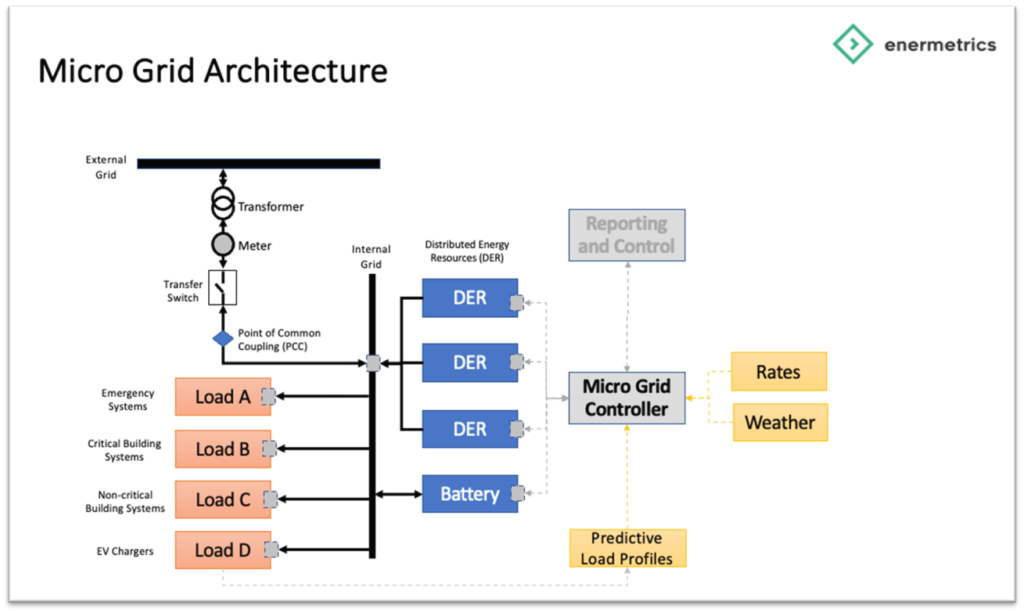
Long term electricity storage is very expensive with the popular Lithium Ion battery systems. However, recent developments with salt water batteries can provide very low cost energy (kWh) storage sufficient to power critical systems for many days.
As solar PV often provides more power than the facility needs during the day, combining these solar arrays with long term low cost electricity storage is becoming much more interesting for resorts in the Caribbean.

Exercise 1.8: Energy Security
• Identify those systems that are critical for business operations
E.g. air conditioning, freezers
How much power is required for these critical systems? (kW)
• How long can these critical systems go without power?
How much energy security do you need? (kWh)
Non Critical Systems
• Identify those systems that are not critical for business operations and can be curtailed
E.g. EV chargers
E.g. amenities
• How will an extended power outage impact your business?

Course Manual 9: Objectives Ranking
Ranking the objectives is important as some of the objectives may be conflicting. For example, an emissions reduction objective may in some cases increase the energy cost.
Given the cost, emissions and energy security objectives identified in previous Course Manuals, we need to rank these objectives to determine where the focus should be for the energy strategy.
There is a temptation to rank everything as important. Indeed, each of the three main business objectives are important (cost reduction, emissions reduction and energy security). However, trying to do everything will lead to doing nothing as the problem seems intractable.
Business decision-makers will resist investments in energy projects if the objectives appear to be unfocused. Therefore it’s important to rank the relative importance of the business objectives to drive the strategy to a solution that is focused and achievable.
Energy projects, with their various goals of enhancing efficiency, curbing emissions, and promoting renewable resources, frequently encompass multiple objectives. In order to effectively manage these projects and ensure they align with both organizational and environmental goals, it is crucial to prioritize these objectives. This process assists in determining resource priorities, maximizing results, and ensuring project efforts are in line with strategic objectives. Here’s a comprehensive guide on how to prioritize objectives for energy projects.
Step 1: Identify and define our objectives.
Prior to ranking, it is essential to clearly identify and define the objectives of your energy project. Some typical goals could be:
• Reducing Costs: Achieving lower energy expenses by implementing efficiency enhancements.
• Reducing Emissions: Working towards lowering greenhouse gas emissions to meet environmental standards.
• Reducing our dependence on external energy sources is crucial for achieving energy independence.
• Ensuring Regulatory Compliance: Fulfilling legal and regulatory obligations.
• Exploring the integration of renewable energy sources to enhance sustainability.
• Enhancing operational efficiency to optimize energy utilization in operations.
• Enhancing the company’s sustainability profile through Corporate Social Responsibility (CSR).
• Embracing the latest in energy technologies: Implementing cutting-edge innovations.
Step 2: Setting Criteria for Ranking
In order to effectively rank the objectives, it is important to establish criteria that can be used to evaluate and compare them. Here are some common criteria:
• Financial Impact: Assessing the potential cost savings or financial benefits of achieving the objective.
• Assessing the environmental impact involves evaluating how much the objective helps in minimizing our ecological footprint.
• Assessing Feasibility: Evaluating the practicality and ease of implementing the objective.
• Assessing the strategic alignment involves evaluating how effectively the objective aligns with the organization’s long-term goals and mission.
• Regulatory Urgency: The importance of meeting current or upcoming regulations.
• Considering the significance of the objective to stakeholders, which encompasses customers, employees, and investors, is crucial.
• Risk Mitigation: Enhancing the objective’s capacity to minimize risks related to energy supply and utilization.
Step 3: Collect and Evaluate Data
Gather data that is pertinent to each objective. This data will offer valuable insights into the potential impacts and feasibility of achieving each goal. Key data points to consider may include:
• Detailed records of current energy use: Energy consumption data.
• Cost Data: Details regarding energy costs, potential savings, and investment requirements.
• Emission Data: Analyzing current greenhouse gas emissions and exploring potential reductions.
• Assessing technologies: Evaluating the available technologies and their potential impact.
• Regulatory Requirements: Stay informed about the latest energy regulations and upcoming changes.
• Stakeholder Feedback: Gathering input from stakeholders regarding their priorities and concerns.
Step 4: Determine the importance of each criterion
Some criteria may carry more weight than others. Please assign weights to each criterion based on their relative importance to your organization. For example, if the financial impact is deemed the most crucial factor, it may be given greater importance compared to other criteria. Here’s an example of weighted criteria:
• Financial Impact: 30%
• Environmental Impact: 20%
• Possibility: 15%
• Strategic Alignment: 15%
• There is a sense of regulatory urgency at 10%.
• Stakeholder value: 5%.
• Risk Mitigation: 5%
Step 5: Evaluate Each Objective
Evaluate each objective based on the criteria. It is recommended to use a consistent scale, such as 1 to 10, to assess the impact or feasibility of a given factor. A score of 1 would indicate low impact or feasibility, while a score of 10 would indicate high impact or feasibility. For instance:
Objective 1: Achieving Cost Reduction
• Financial Impact: 9
• Environmental Impact: 6
• Feasibility: 8
• Strategic Alignment: 7
• Regulatory Urgency: 5
• Stakeholder Value: 7
• Risk Mitigation: 6
Step 6: Determine the Weighted Scores
Calculate the weighted score for each criterion by multiplying each score by its corresponding weight. Add up these weighted scores to calculate the overall score for each objective. Here’s a sample calculation for Objective 1 (Cost Reduction):
• Calculating the financial impact, the result is 2.7.
• Calculating the environmental impact, we get a result of 1.2. As for feasibility, the calculation yields a value of 1.2.
• Calculating the strategic alignment score, we find that it equals 1.05.
• Regulatory urgency: 5 multiplied by 0.10 equals 0.5.
• Calculating stakeholder value: 7 multiplied by 0.05 equals 0.35.
• Calculating Risk Mitigation: 6 multiplied by 0.05 equals 0.3.
• The Total Weighted Score for Objective 1 is calculated by adding up the individual scores: 2.7 + 1.2 + 1.2 + 1.05 + 0.5 + 0.35 + 0.3, resulting in a total score of 7.3.
Perform this calculation for every objective.
Step 7: Prioritize the Objectives
After calculating the total weighted scores for each objective, arrange them in descending order based on their scores. Based on your criteria, the objective with the highest score should be given top priority, as it is the most impactful and feasible goal. Here’s a sample ranking:
• Objective 2: Emission Reduction – Total Score: 8.15
• Objective 1: Cost Reduction – Total Score: 7.3
• Objective 3: Renewable Energy Integration – Overall Score: 6.8
• Objective 4: Operational Efficiency – Total Score: 6.2
Step 8: Review and Adjust
Discuss the ranked objectives with key stakeholders and decision-makers to ensure they are in line with strategic goals and priorities. It’s important to remain receptive to any feedback or new insights that may arise. Ensuring that the ranking reflects a consensus is crucial for gaining buy-in.
Step 9: Put into action and keep a close eye on
Once the objectives have been ranked, it is important to create a comprehensive implementation plan for each priority objective. Delegate tasks, establish deadlines, and distribute resources accordingly. Set up key performance indicators and monitoring systems to keep tabs on progress and make any needed changes. Continuous monitoring helps to ensure that the objectives stay in line with the changing organizational goals and external conditions.
Post-Secondary Institutions
With government funded institutions, the business drivers are less focused on energy cost reduction and more focused on thought leadership, research and market development. Therefore, they are more interested in emerging technologies and technology integration. For example, many institutions have developed an alternative energy laboratory in which they can test new technologies such as geothermal, fuel cells and concentrated solar thermal.
PSI’s are also driven to reduce their emissions to demonstrate to the market how emissions reduction technologies can work.
This is not to say that the PSI is not interested in cost reduction – just that there are other objectives that take the focus for energy projects.
The energy systems in post-secondary schools are a crucial area of concentration, with the purpose of enhancing operational efficiency and providing a valuable learning experience for students. The energy systems of these institutions are primarily focused on sustainability, cost-effectiveness, and educational value. The following are the main areas of focus, along with specific instances:
Renewable Energy Integration
Post-secondary schools are placing a growing emphasis on incorporating renewable energy sources into their operations in order to decrease their carbon emissions and showcase their commitment to sustainability. The Bullitt Center at the University of Washington demonstrates the possibility of achieving net-positive energy performance in educational environments by utilizing a rooftop solar array that produces more energy than the facility consumes on a yearly basis.
Energy Efficiency
Energy efficiency and conservation are key focuses for lowering energy consumption and expenses. Prioritizing the improvement of energy efficiency in current buildings and the implementation of conservation measures are crucial steps towards achieving this goal. The University of California, Davis executed a thorough energy efficiency initiative which encompassed the installation of LED lighting improvements, optimization of HVAC systems, and implementation of building automation systems. This program led to a significant decrease of 30% in energy consumption intensity throughout the entire campus.
Smart Building Technologies
The implementation of sophisticated building management systems and Internet of Things (IoT) devices for the purpose of real-time monitoring and control of energy use is gaining significant importance. Carnegie Mellon University employs an advanced building automation system that combines occupancy sensors, daylight harvesting, and predictive controls to maximize energy efficiency in its campus buildings.
Energy Storage and Microgrids
The increasing importance of energy storage and microgrids lies in their ability to improve energy resilience and maximize the utilization of renewable energy sources. The University of California, San Diego has implemented a microgrid consisting of a 2.8 MW fuel cell, 2.5 MW of solar photovoltaic (PV) panels, and a 2.5 MW/5 MWh energy storage system. This setup enables the institution to produce approximately 85% of its electricity on-site.
Curriculum Integration
Integrating energy systems into academic programs and research projects is essential for equipping students with the necessary skills for careers in the energy sector and promoting advancements in energy innovation. The Energy Systems Engineering Technology program at St. Lawrence College offers practical training in renewable energy systems, HVAC technologies, and energy modeling software, equipping students for sustainable energy careers. Using campus facilities as living labs for energy research and demonstration initiatives is a growing focus.
The Campus as a Living Laboratory effort at the University of British Columbia encompasses various projects, such as the Bioenergy Research and Demonstration Facility. This facility effectively transforms wood waste into environmentally friendly heat and electricity to be used on campus.
Energy Auditing
Consistently doing energy audits and implementing methods for continuous improvement is crucial for sustaining energy efficiency in the long run. The Simcoe County District School Board in Ontario successfully executed a thorough energy audit and retrofit program in 35 schools, leading to a remarkable energy cost reduction of over $3.5 million and setting a benchmark for future initiatives.
Community Engagement and Partnerships
It is becoming more and more crucial to engage with the local community and establish partnerships with industry and government agencies in order to promote and advance energy programs. Algonquin College in Ottawa collaborated with Siemens Canada to establish a Smart Energy Systems Laboratory. This initiative offers students practical training in smart grid technology and generates valuable research findings for the local utility.
Sustainable Transportation
Many organizations are increasingly prioritizing the promotion of electric vehicles, bike-sharing programs, and public transit as a means to address energy use in transportation. Stanford University successfully executed a comprehensive transportation demand management program, which included incentives to encourage the use of public transit and the establishment of an extensive bike network. As a result, there was a notable decrease in the number of trips made to campus by individuals driving alone in their vehicles.
The Water-Energy Nexus:
Many organizations are placing water conservation as a priority in their entire energy plan, acknowledging the link between water and energy consumption. The University of Connecticut has established a reclaimed water plant that decreases the usage of drinkable water by 100 million gallons per year. This results in energy savings due to lower pumping and treatment requirements.
By prioritizing these areas, post-secondary institutions can effectively diminish their energy usage, save operating expenses, minimize their ecological footprint, and offer excellent educational experiences for students studying sustainable energy systems.
Hotel/Resorts
The hotel/resort market certainly had a tough time throughout the pandemic and are now starting their recovery. As such, most hotels are focused at energy cost reduction and cost certainty. Often, resorts are located in warmer climates and coastal locations where energy costs can be very high.
Resorts depend on guest rankings and comments from social media. As such, this market is very focused on guest experience which can be adversely impacted if the power goes out. For example, a luxury hotel in Calgary suffered from a raft of negative reviews when their hot water system failed and the guests in expensive rooms were unable to take a shower.
Resorts also recognize that their guests are more likely to book if they can demonstrate a strong sustainability program.
These competing objectives result in a dilemma for management to decide where to focus their investments. The good news is that there are scenarios (set of technologies) that can address more than one core objective and reduce emissions and provide for energy security.
Hotels generally take into account multiple aspects when deciding their energy priorities:
• Return on Investment (ROI): Hotels typically give priority to initiatives that have the shortest payback times and the highest ROI.
• Guest satisfaction is typically prioritized by implementing measures that improve guest comfort and enhance their experience, while also conserving energy.
• Brand Alignment: Numerous hotel chains own corporate sustainability objectives that impact the priorities of each individual resort.
• Hotels must take into account local and national energy efficiency rules in order to comply with regulatory requirements.
• Available Incentives: The presence of government or utility incentives for energy-efficient renovations might have an impact on the decision-making process.
• Operational Impact: Hotels prioritize solutions that can be executed without causing significant interruption to their everyday activities.
• Market Demand: The growing inclination of guests towards eco-friendly accommodations is compelling hotels to give priority to sustainability measures that are easily noticeable.
• Energy audits are commonly performed by hotels to conduct a thorough assessment of their energy usage and identify the areas where improvements can have the most impact.
• Benchmarking: Hotels frequently assess their energy performance by comparing it to established industry standards in order to discover areas that require immediate attention.
• Technological advancements: With the emergence of energy-efficient technology that are increasingly affordable, hotels may modify their priorities
The Mandarin Hotel in Santiago, Chile, placed a high importance on implementing a comprehensive and diverse strategy for sustainability. A rooftop garden was implemented to enhance biodiversity and air quality, while a 21.6 kWp solar energy facility was erected to decrease their carbon footprint by 7.5 tons of CO2 annually.
Hotels can attain substantial cost savings, reductions in emissions, and enhanced energy security by implementing strategic energy management. Hotels can establish the most effective priorities for their energy projects by thoroughly assessing their specific circumstances, market demands, and the technologies that are already available. This strategy not only improves their financial performance but also strengthens their brand image and customer happiness in a growing environmentally aware market.
Industry
Energy costs for industrial facilities is often the largest cost item behind labour. Many industries recognize that their customers are becoming more interested in sustainable developed products. As such, they are now starting to investigate solutions to reduce energy and emissions.
In many cases, the industrial facility cannot tolerate failures in grid electricity. In one example with a natural gas products producer, millions of dollars of damage was done to high pressure equipment when the local grid failed. This resulted in immediate investment in onsite generation.
Of course, there are also industries that can shut down operations for a short period if the grid fails without damage to the infrastructure.
Objectives ranking in industrial facilities can be complex and should consider the cost to the business for
• Forecasted future energy rates
• Emissions reductions expectations from their customers
• Energy security – can they shut down without significant facility damage and restart costs
Industrial firms commonly establish their investment priorities for energy systems through many crucial methods:
• Financial analysis is performed by industrial companies to assess the return on investment (ROI) and payback period of possible energy projects. Their priority lies in investing in opportunities that yield the highest financial returns and have the quickest payback times.
• Energy audits and assessments are conducted to thoroughly analyze and identify areas of inefficiency and potential for enhancement. This aids firms in comprehending the areas with the most potential for energy reduction.
• Regulatory Compliance: Adhering to energy efficiency requirements and standards is frequently a primary motivator. Organizations use resources to prioritize investments necessary for fulfilling regulatory obligations.
• Corporate Sustainability Goals: Numerous industrial organizations have established corporate objectives for sustainability and the reduction of emissions. Projects that contribute to achieving these objectives are assigned greater importance.
• Operational Impact: Projects that enhance operational efficiency, productivity, and dependability while also conserving energy are frequently given more priority.
• Government incentives, rebates, or tax credits for specific energy efficiency measures might impact investment decisions.
• Technology Maturity: Organizations typically give higher importance to established technologies that have proven track records, rather than younger and more uncertain alternatives.
• Energy security and resilience are of growing significance, making investments that improve protection against disruptions increasingly crucial.
• Benchmarking involves companies comparing their energy performance with that of their industry peers in order to discover areas where they are falling behind and prioritize those areas for improvement.
• Strategic Alignment: Energy investments are assessed according to their degree of alignment with the overall corporate strategy and future objectives.
• Energy Data Analytics: Sophisticated energy monitoring and analytics assist in identifying the most influential areas for investment.
• Stakeholder Input: The input of different stakeholders, including as operations, maintenance, finance, and sustainability teams, is taken into account when deciding which investments to prioritize.
The relative importance of these characteristics may differ depending on the organization’s industry, size, location, and strategic priorities. Numerous companies employ a scoring or ranking system that takes into account various variables in order to establish their ultimate investment priorities for energy systems.
Commercial Real Estate
Commercial real-estate has historically been less interested in investing into energy projects as the energy costs are absorbed by the tenants. This “split incentive” has hindered the implementation of clean energy projects within this sector.
With the post pandemic trend to hybrid working, there has been a flight from office towers and a growing challenge with vacancy rates. Their tenants recognize that to keep talented staff, they need to offer new ways of working. Further, the company can reduce their scope 3 emissions by reducing leased office space and reduced commuting for their employees.
CRE firms encounter the task of managing operational expenses, ensuring tenant contentment, and achieving sustainability objectives. Investing in energy systems is a deliberate decision that can have a substantial influence on these domains. CRE organizations establish their objectives for energy system investments by employing a systematic approach, which is exemplified through specific instances.
Financial Performance and return on investment (ROI)
Financial savings and return on investment are key motivators for energy system investments. Commercial real estate (CRE) organizations assess the expenses and advantages of different energy efficiency methods, taking into account both immediate savings and long-term financial viability. Transwestern Commercial Services allocated more than $12 million towards enhancing energy efficiency, resulting in an average energy savings of 25%. The investment resulted in a significant return on investment, increasing the portfolio’s value by a minimum of $344 million.
Energy Audits and Benchmarking
Performing energy audits and comparing energy performance to established standards are crucial measures in finding inefficiencies and potential areas for enhancement. These audits offer data-driven insights into the locations where energy is being used and where potential savings might be made. USAA Real Estate Company conducted energy audits and retro-commissioning to pinpoint areas of inefficiency. These endeavors resulted in substantial energy conservation and a boost in the portfolio’s asset worth of over $30 million, while simultaneously averting the release of 89 million pounds of CO2 into the atmosphere.
Regulatory Compliance
Ensuring adherence to local, state, and federal rules is an essential factor for CRE enterprises. Moreover, the provision of incentives and rebates for energy efficiency enhancements can enhance the appeal of specific investments. The implementation of recommended best practices by the Department of Energy’s Better Buildings Initiative has resulted in a savings of $15.3 billion for commercial real estate properties. The savings were attained by implementing energy-efficient techniques that simultaneously assured adherence to regulatory standards.
Tenant Satisfaction and Market Demand
Ensuring tenant happiness is crucial for the prosperity of commercial real estate properties. Buildings that are designed to use energy efficiently are more appealing to tenants, resulting in increased rates of occupancy and higher rental prices. The investment in sustainable energy systems is driven by the market demand for green buildings. For instance, the Salesforce Tower in San Francisco is equipped with cutting-edge energy technology, such as sophisticated HVAC controls and energy-saving lighting. These characteristics contribute to the building’s LEED Platinum accreditation, rendering it highly appealing to tech businesses and other tenants who prioritize sustainability.
Sustainability Goals and Corporate Accountability
A significant number of commercial real estate (CRE) businesses have implemented sustainability objectives as a component of their corporate responsibility endeavors. Allocating resources towards energy systems that mitigate carbon emissions and improve environmental performance is in line with these objectives and showcases a dedication to sustainability. The Empire State Building underwent a thorough refit that encompassed the installation of energy-efficient lighting, changes to the HVAC system, and enhancements to window insulation. The implementation of these solutions led to a notable decrease of 38% in energy usage and substantial reductions in emissions, which are in line with the building’s sustainability objectives.
Technology Advancements
Progress in energy technology offers fresh possibilities for enhancing energy efficiency and lowering expenses. Commercial real estate (CRE) firms remain updated on the most recent technology and carefully evaluate their potential consequences before making investment choices. Carnegie Mellon University employs an advanced building automation system that combines occupancy sensors, daylight harvesting, and predictive controllers to efficiently manage energy use in its campus buildings. The implementation of this sophisticated technology has greatly enhanced energy efficiency and lowered operational expenses.
Operational Impact
Ensuring the practicality of implementing energy conservation measures without causing disruptions to operations is a vital factor to consider. CRE organizations give priority to investments that can be seamlessly incorporated into current systems and processes. The Best Western Plus hotel in Thunder Bay, Canada, installed a lighting retrofit and HVAC controls as components of an energy management system. The renovations were implemented with minimal impact on hotel operations, leading to yearly cost reductions of $12,800.
Data Analytics and Monitoring
By employing data analytics and monitoring tools, CRE firms may effectively monitor energy usage, detect patterns, and quantify the effects of energy conservation measures. Continuous monitoring is essential for ensuring that energy systems are operating at their highest level of efficiency and delivering the intended energy savings. Numerous commercial real estate (CRE) businesses employ energy management systems to actively monitor and regulate energy consumption in real-time. These systems offer practical insights that aid in optimizing energy usage and decreasing expenses.
Conclusion
Establishing investment priorities in energy systems necessitates a thorough assessment of financial profitability, adherence to regulations, tenant contentment, sustainability objectives, technical progress, operational influence, and data analysis. By taking into account these elements, commercial real estate firms can make well-informed decisions that optimize energy efficiency, minimize expenses, and boost environmental performance.
Investing in energy systems not only improves financial performance but also enhances the sustainability and resilience of the built environment. CRE businesses that prioritize energy efficiency will be in a favorable position to satisfy market expectations and achieve long-term profitability as the demand for green buildings continues to increase.
Metrics to Consider
Metrics can refer to any of the following evaluation tools:
▢ Employee Success – Productivity and work quality, Skill development and improvement, Achievement of goals and objectives, Team integration, personalized performance metrics.
▢ Customer Success – Customer satisfaction, net promoter score (NPS), customer effort score (CES), and customer lifetime value (CLV).
▢ Supplier Success – Supplier availability, regulatory compliance, responsiveness, risk management, investment, fill rate, innovation, customer service, lead time, defect rate, cost reduction, precision, competitiveness, order cycle time.
▢ Shareholder Success – Earnings per share (EPS), return on equity (ROE), free cash flow (FCF), market capitalization, total shareholder return (TSR).
▢ Investor Success – Price-to-earnings ratio (P/E ratio), price-to-book ratio (P/B ratio), debt-to-equity ratio (D/E ratio), free cash flow (FCF), price/earnings-to-growth ratio (PEG ratio).

Exercise 1.9: Objectives Ranking. What is most important?

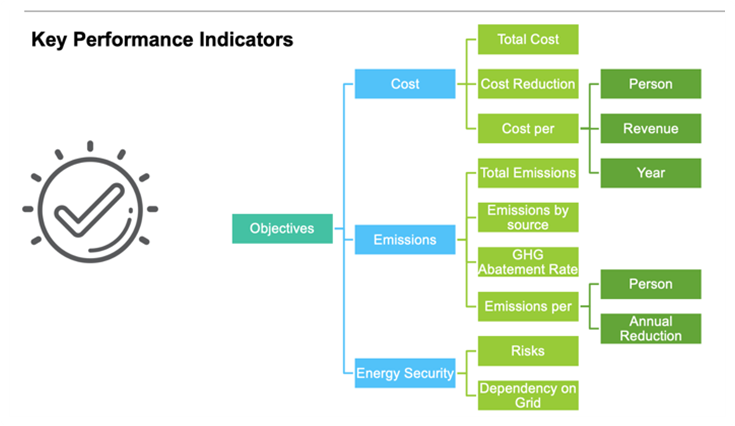

Course Manual 10: Who Cares?
When we are designing the KPI’s, we need to consider who will be monitoring them and understand their motivations. Understanding the different stakeholders in the project ecosystem will help to understand how the KPI’s will be used which will help to ensure that the KPI’s are appropriate.
Identifying the stakeholders in the project ecosystem is important to ensure that the project is a success for everyone. Examples include:
• Internal Stakeholders
Project Sponsor
Project Manager
Facility Owners
Executive
Facility operators
Energy managers
Energy systems operators
Maintenance staff
• External Stakeholders
Customers
Politicians
Technology vendors / partners
Installers
Engineers
Project financiers
Utilities
Energy projects involve various stakeholders and require collaboration and support from different parties. These stakeholders can be broadly classified into internal and external groups, each with their own unique interests, responsibilities, and expertise. Having a clear understanding of and effectively managing these stakeholders is absolutely essential for the successful implementation and operation of energy projects. Here, we delve into the roles and perspectives of both internal and external stakeholders in great detail.
Internal Stakeholders
1. Project Sponsor:
The project sponsor is usually a senior executive or high-level manager who supports the project and secures funding. They are responsible for providing strategic direction, ensuring alignment with organizational goals, and possessing the authority to make high-level decisions. The sponsor’s support is crucial for overcoming obstacles and ensuring the project remains a top priority within the organization.
Job Duties:
• Securing and allocating budget and resources is crucial for successful operations.
• Offering strategic oversight and guidance.
• Resolving high-level conflicts and issues with expertise.
• Ensuring that our actions are in line with the objectives of the organization.
2. Project Manager:
The project manager is in charge of planning, executing, and closing the project. They are responsible for overseeing all project activities, managing the project team, and ensuring that the project stays on schedule and within budget. Efficient project management is crucial for coordinating the efforts of different stakeholders and successfully achieving project objectives.
Job Duties:
• Creating and managing the project plan.
• Coordinating and guiding the project team.
• Addressing project risks and issues.
• Engaging with stakeholders and providing updates on progress.
• Ensuring the project achieves its objectives and deliverables.
3. Owners of facilities:
Facility owners are the individuals or entities responsible for owning the physical infrastructure where the energy project is being implemented. They play a crucial role as key stakeholders since the project directly affects their property. Approval and cooperation from all parties involved are crucial for the successful initiation and ongoing operations of the project.
Job Duties:
• Ensuring access to the facilities.
• Reviewing and approving project plans and modifications.
• Considering investments in or approving expenses for facility upgrades.
• Ensuring adherence to local regulations and standards.
4. Executives:
Executives, including top-level executives like the CEO, CFO, and COO, offer high-level supervision and strategic guidance. Securing organizational commitment and resources relies heavily on their buy-in. They are also curious about how the project fits into the company’s broader strategy and long-term objectives.
Job Duties:
• Strategic planning and decision-making.
• Managing the distribution of company resources.
• Ensuring project alignment with corporate goals.
• Assessing project performance and outcomes.
5. Facility Operators:
Facility operators are in charge of the daily operations of the energy project’s facility. With their deep understanding of the facility’s operations, these analysts play a vital role in implementing energy-saving measures and ensuring the smooth functioning of new systems.
Job Duties:
• Operating and maintaining facility systems.
• Implementing measures to save energy.
• Monitoring system performance and promptly reporting any issues.
• Offering insights on the operational effects of the project.
6. Professionals specializing in energy management:
Energy managers are dedicated to maximizing energy efficiency within the organization. They have a crucial role in identifying opportunities to save energy, implementing strategies for managing energy, and closely monitoring energy consumption. Their knowledge and skills are crucial for meeting the project’s objectives of improving energy efficiency and promoting sustainability.
Job Duties:
• Examining patterns of energy consumption.
• Identifying and suggesting energy efficiency measures.
• Monitoring and reporting on energy savings, just like an energy analyst.
• Ensuring adherence to energy policies and standards.
7. Operators of Energy Systems:
Energy systems operators oversee the functioning of energy systems, which encompass generation, distribution, and storage. They are responsible for ensuring the reliable and efficient operation of these systems and promptly addressing any operational issues that may arise.
Job Duties:
• Operating energy generation and distribution systems.
• Prioritizing system reliability and efficiency.
• Addressing operational issues and emergencies.
• Working closely with facility operators and maintenance staff.
8. Staff responsible for maintenance:
Maintenance staff are in charge of maintaining and repairing facility and energy systems. Their role is vital in maintaining the continuous reliability and efficiency of energy systems. Training on new systems and technologies implemented as part of the energy project is necessary.
Job Duties:
• Carrying out routine maintenance and repairs.
• Ensuring that systems are functioning efficiently and reliably.
• Implementing proactive maintenance programs.
• Offering insights on system performance and addressing any issues.
External stakeholders
1. Customers:
Customers, whether they are residential or commercial, are the ones who use the energy generated or controlled by the project. The project’s success heavily relies on their satisfaction and support, especially for customer-facing projects such as utility upgrades or renewable energy installations.
Job Duties:
• Offering insights on energy services.
• Engaging in energy efficiency programs.
• Passionate about supporting and advocating for sustainable energy initiatives.
• Understanding the costs associated with energy services and their impact on the project’s financial viability.
2. Politicians:
Politicians and government officials play a significant role in shaping regulatory frameworks, allocating funding, and endorsing energy policies. Their assistance can help expedite project approvals, secure grants, and ensure compliance with regulations.
Job Duties:
• Enforcing and implementing energy regulations and policies.
• Supporting and encouraging energy projects through funding and incentives.
• Promoting sustainable energy initiatives.
• Streamlining project approvals and permits.
3. Technology Vendors / Partners:
Technology vendors and partners provide the necessary hardware, software, and expertise for energy projects. They play a vital role in delivering state-of-the-art technology and ensuring its seamless integration.
Job Duties:
• Providing energy technology and equipment.
• Offering technical assistance and training.
• Ensuring seamless compatibility and smooth integration with existing systems.
• Providing warranties and maintenance services.
4. Installation technicians:
Installers are in charge of the physical installation of energy systems and equipment. With their deep knowledge and experience, they ensure that systems are installed correctly and safely. They also collaborate closely with technology vendors and engineers.
Job Duties:
• Installing energy systems and equipment.
• Ensuring that installations meet safety and regulatory standards.
• Working closely with project managers and facility operators.
• Offering assistance and upkeep after the installation is complete.
5. Engineers:
Engineers, such as electrical, mechanical, and civil engineers, are responsible for designing and supervising the technical aspects of energy projects. With their deep understanding of the field, they ensure that systems are meticulously designed and flawlessly implemented to meet project specifications and performance standards.
Job Duties:
• Creating energy systems and infrastructure.
• Conducting feasibility studies and technical assessments.
• Ensuring adherence to engineering standards and regulations.
• Supervising the installation and commissioning of systems.
6. Project Financiers:
Project financiers play a crucial role in providing the capital required for energy projects. These can include banks, investors, and government grant providers. Their participation is vital in order to secure funding and effectively manage financial risks.
Job Duties:
• Supporting project development and implementation by providing capital.
• Evaluating the financial feasibility and potential risks of projects.
• Monitoring financial performance and returns on investment.
• Ensuring adherence to financial agreements and conditions.
7. Utilities:
Utilities are the entities responsible for supplying electricity, gas, and water services to consumers. They play a crucial role in energy projects, especially those that focus on grid integration, energy distribution, and customer engagement.
Job Duties and Expectations:
• Offering energy distribution and management services.
• Enabling grid integration and interconnection.
• Providing incentives and programs to promote energy efficiency and the use of renewable energy sources.
• Ensuring the reliability and quality of energy supply is of utmost importance.
Overseeing Stakeholder Engagement
Stakeholder engagement plays a crucial role in ensuring the success of energy projects. Here are a few effective approaches to handle stakeholder relationships:
1. Effective Communication:
• Regular Updates: Keep stakeholders informed with consistent updates on project progress, milestones, and any adjustments to plans.
• Ensure that project performance is reported in a transparent manner, highlighting both achievements and obstacles.
2. Participation:
• Regularly convene meetings with key stakeholders to discuss project updates and address any concerns.
• Organize workshops and training sessions to provide stakeholders with the necessary information and skills for their roles.
3. Feedback:
• Collect feedback from stakeholders through surveys and interviews to gain insights into their needs and expectations.
• Establishing feedback loops is crucial for incorporating stakeholder input into project planning and execution.
4. Working together:
• Establish strong alliances with external stakeholders such as technology vendors, engineers, and utilities to tap into their expertise and resources.
• Consider exploring joint ventures or co-investment opportunities as a way to distribute risks and reap mutual benefits.
5. Ensuring Compliance and Standards:
• Ensure compliance with all relevant regulations and standards to avoid legal issues and gain the support of regulatory bodies.
• Ensure high-quality standards: Establish and enforce robust quality assurance procedures to meet the expectations of stakeholders and adhere to project specifications.
Energy projects require the involvement of various stakeholders, each with their own unique interests, responsibilities, and impact on the project’s overall success. Internal stakeholders, such as project sponsors, managers, facility owners, operators, and maintenance staff, collaborate to ensure the project is well-planned, executed, and maintained. External stakeholders, including customers, politicians, technology vendors, installers, engineers, financiers, and utilities, play a crucial role in providing the support, resources, and oversight needed to achieve project goals.
Successful stakeholder management requires clear and concise communication, active participation, consistent feedback, strategic collaboration, and a strong commitment to compliance and standards. By comprehending and addressing the needs and contributions of each stakeholder group, energy projects can successfully achieve their objectives, promote sustainability, and provide long-term benefits to all parties involved.
Internal Stakeholders
The individual or organization that contributes the project’s cash or in-kind funding is known as the sponsor. A project’s sponsor supports it from the very beginning. This involves acting as a representative to upper management in order to garner support from all areas of the company and highlight the advantages that the project will provide. The sponsor plays a major part in developing the original scope and charter and oversees the project through the engagement or selection process until it is formally sanctioned.
A project manager is the person in charge of the project. That much is clear, but that might be too simple of an explanation. The project manager leads the project through every phase. That means they’re responsible for first selling the project to stakeholders, then planning and defining the scope of the project.
This arrangement of job duties facilitates each organization’s operations and creates an atmosphere in which all of the systems—from the parking lot to the executive suite—function flawlessly together. By organizing the procedures that result in a successful constructed environment, facility managers ensure that we have the safest and finest experience possible.
Facility owners are primarily focused at cash flow, revenue and the value of their facility. Owners recognize that there needs to be continued investment in the facility to address the future energy costs and the expectations of their customers.
Facility executive are interested in the delivery of projects that were approved by the owners – ensuring they are delivered on time and on budget.
Facility operators are more interested in the safe and efficient management of energy equipment. This includes developing the operating rules that can be implemented in building management systems to automated much of the systems in the building. Dashboards can help to alert operators that conditions exist that require their attention – enabling management by exception rather than a crisis management approach.
An energy manager’s (EM) job is to promote energy conservation through the identification and application of different energy-saving strategies, the direction of awareness campaigns, and the monitoring of energy usage. As a result, EMs are essential to the industry’s ability to successfully execute demand management and energy saving initiatives.
All energy projects will involve a great deal of data flowing from meters and sensors. This data is used for tracking value, fault identification, operations reporting and dashboards.
External Stakeholders
Perhaps the most important external stakeholder is the organizations customers. Understanding the interests of the customers is one of the most important aspects of “who cares” and can be one of the more effective dashboards in the energy strategy. More and more customers care about emissions reductions and the sustainability of your organization.
For larger energy projects, there may be political capital that will then involve the political community. For example, if the project receives government funding or were involved in securing external funding, the politicians will definitely be involved.
The vendors supplying the technologies certainly need to be part of the ecosystem. The vendors must be involved in the design of the solution, sizing, and ensuring that all components required are included. After implementation, the technology vendors are interested in the performance of their solution in order to verify that the organization is getting what was promised.
Every energy project must engage a professional electrical engineer to develop and stamp the single line drawings. This needs to happen very early in the project, before any equipment is ordered. The electrical engineer needs to work with the technology vendors to ensure that the selected equipment is appropriate for the facility.
Utilities care about the stability of their grid and ability to provide sufficient quality power to their customer base. They need to know that the technologies implemented at your facility will not adversely impact their grid.
Project financier are interested in whether their investment is delivering the forecasted financial value. While this stakeholder group is likely not interested in a dashboard, they will be interested in monthly or annual performance reports and comparison to the forecasted proforma.
In the following exercise, we will discuss each stakeholder, what they care about and how they will measure success.

Exercise 1.10: Who Cares?
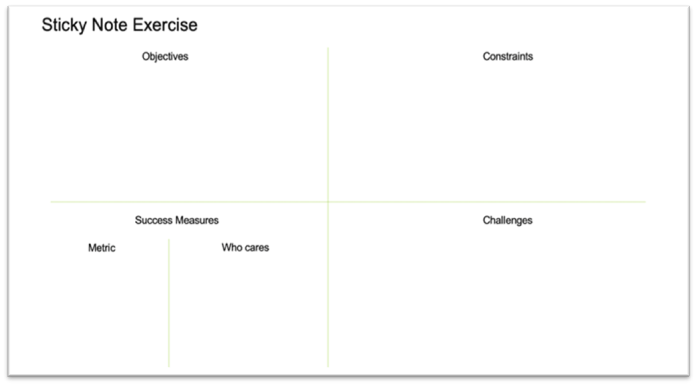
▢ Cost
▢ Total Cost
▢ Cost Reduction
▢ Cost Per
▢ Emissions
▢ Total Emissions
▢ Source Emissions
▢ Green House Gas (GHG) Abatement Rate
▢ Emissions Per
▢ Energy Security
▢ Risks
▢ Grid Dependency

Course Manual 11: KPI Design
There are many types of KPI’s. When designing your KPI’s we need to consider who is using them and for what purpose. The KPI’s need to “tell a story” – and the story depends on the audience viewing the dashboard.
Each of the stakeholder groups discussed in the previous Course Manual will be interested in a different story. The method and frequency to deliver the story will be different between the stakeholder groups.
KPI Design Considerations
• KPIs and organizational goals ought to be connected. Something is only measurable in relation to its declared objectives.
• Choose a smaller number of more significant KPIs to aid in decision-making. Because what gets measured gets done, take great care while selecting the exact measurement. Are you more concerned with the “Amount of Lost Time from Work Cover injuries” or the “Number of Work Cover claims”?
• It takes a collection of KPIs to comprehend performance. Both lag and lead indicators should be included in the mix of qualitative and quantitative inputs, outputs, processes, results, and impacts that make up the indicators.
• KPIs should be appropriate for target benchmarking in order to assist management in determining when performance deviates from the range of “business-as-usual.” Never undervalue the influence that targets have. JFK stated that he would place a man on the moon by the end of the decade, not that he desired the greatest space program in history. In a similar vein, Bill Gates aimed to equip every desk in the nation with a computer.
• KPIs ought to be centred on raising the standard of service provided to clients and consumers.
• Analysis and commentary that contextualizes the data and new patterns should be included in KPI reports. Merely ‘spotting’ trends is insufficient; they also need to be analyzed and comprehended in the context of the company.
Consider the following principles when selecting the KPI’s
1. Relevance: Your strategy goals should be reflected by KPIs. For example, two primary indicators are frequently the focus of customer support inquiries: resolution rates and response times. Making ensuring that these KPIs are precisely in line with your individual objectives in the context of the wider business is vital. When your strategic goals shift, they have to adjust as well to maintain a solid link. The KPI’s that are relevant to one story and stakeholder group are not necessarily relevant to a different story and stakeholder group.
2. Actionability: A KPI’s worth is derived by the actions it inspires. Every metric you track should ideally have a direct impact on decision-making and lead to a notable improvement or change. For instance, it’s critical to comprehend just what needs to be done to address a KPI that indicates a drop in client contentment. This notion emphasizes that KPIs should not only be used as performance indicators but also as proactive management tools.
3. Clarity: Complexity makes it more difficult to carry out an execution process. All KPIs should be straightforward, easy to understand, and accessible to all relevant parties, regardless of level of expertise. This degree of clarity ensures that everyone has an equal understanding of the topic under review and its importance. It also improves the effectiveness of coordination and communication between different organizational divisions.
4. Timeliness: In a changing business environment, information becomes less and less important with time. KPIs should therefore provide data that is as current as possible to enable decision-making in real-time or almost real-time. This means setting aside funds to gather and process data effectively, in addition to selecting pertinent indications on time.
5. Benchmarking: Key Performance Indicators (KPIs) should enable you to understand how you compare to competitors or external benchmarks. Setting realistic performance targets and pinpointing areas in need of development requires an understanding of this environment. Whether it’s industry average response times for customer service or product adoption rates in your business, having a comparative perspective is essential for effective performance management.
6. Data Quality: Ensuring the validity of insights obtained from KPIs depends heavily on data quality. Maintaining data integrity requires thorough understanding of data collecting and processing techniques in addition to the execution of validation and cleansing processes on a regular basis. Ensuring high data quality is essential for accurate performance evaluation since it helps avoid making the wrong decisions and plans.
7. Balance: One KPI is not enough to provide a whole picture of performance. Therefore, it is imperative to maintain a comprehensive scorecard that covers multiple aspects of organizational well-being, such as financial, customer, process, learning, and growth components. This balance promotes a more all-encompassing approach to performance management by helping to prevent an undue concentration on one domain at the expense of others.
8. Review Cycle: Your KPIs should be flexible because the business environment is continually changing. Regular reviews of your KPIs ensure that they remain current and in line with both your expanding business plan and the outside environment. This could entail changing your goals, updating your performance metrics, or even starting over with your key performance indicator system. This idea emphasizes how important it is to be flexible and nimble when it comes to performance management.
Designing KPIs: Various Approaches for Presenting Key Performance Indicators
Measuring and managing performance across various aspects of a business or project is essential, and Key Performance Indicators (KPIs) play a crucial role in this process. Designing effective KPIs ensures that the appropriate metrics are measured, communicated, and acted upon. This guide delves into four different types of KPI designs, including Real-Time KPIs, Infographics, Achievement-Based KPIs, and Historical Trends. It also provides insights on how to effectively present and showcase these KPIs to ensure they have the greatest impact.
Real Time KPI’s
Real-Time KPIs offer instant feedback on crucial performance metrics. They play a crucial role in operations that necessitate constant monitoring and swift adaptation to evolving circumstances. Real-time KPIs are commonly shown on dashboards that constantly update, giving a current overview of performance.
Here are some examples:
• Monitoring the number of visitors to a website in real time is crucial for understanding website traffic.
• Monitoring the operational status of IT systems.
• Measuring the production rate in a factory: Analyzing manufacturing output.
Factors to Consider:
• Ensure that data sources are reliable and constantly updated to maintain accuracy and freshness of information.
• For an effective user interface design, it is important to utilize visuals such as gauges, charts, and colour coding. These elements help convey information in a clear and intuitive manner, allowing users to grasp it quickly.
• Implementing alert systems to notify stakeholders of critical changes or thresholds being crossed can be highly beneficial.
Presenting:
• Utilize digital dashboards that can be accessed through web browsers or dedicated applications. It would be beneficial for these dashboards to have the ability to be customized, so that users can easily focus on the key performance indicators that are most relevant to them.
• Large screens in operational areas can display real-time KPIs to keep teams informed, just like an energy analyst would do.
• Mobile Apps: Enable stakeholders to access real-time data while on the move.
Infographics:
Infographics are great for presenting KPIs in a visually engaging format, allowing you to easily understand complex data with just a quick glance. They are highly effective at conveying information to a wide range of people, including stakeholders without a technical background.
Here are some examples:
• Annual Performance Reports: Providing a concise overview of accomplishments and key performance indicators for the year.
• Tracking project milestones: Visualizing progress towards project goals.
• Market Analysis: Presenting trends and comparisons in market data.
Factors to Consider:
• Create visual appeal by incorporating attractive and consistent design elements, including colours, icons, and typography.
• Make sure the infographic is clear and easy to comprehend. Simplify your message and prioritize the most important points.
• Storytelling: Utilize the infographic to present a cohesive narrative that leads the viewer through the data.
Presenting:
• Include infographics in management reports and presentations to enhance understanding and retention.
• Send out infographics via email to keep stakeholders informed with the latest updates.
• Utilize websites and social media platforms to expand your reach by publishing engaging infographics.
• Performance Metrics Based on Achievements
Design Concept:
Progress against specific goals or targets is measured using Achievement-Based KPIs. They are valuable for inspiring teams and individuals by offering precise, measurable goals and monitoring their advancement.
Here are some examples:
• Monitoring progress towards monthly or quarterly sales targets.
• Project Completion: Tracking progress in a project plan.
• Measuring the achievement of customer satisfaction targets.
Factors to Consider:
• Setting Goals: It’s important to clearly define your goals and make sure they meet the SMART criteria (Specific, Measurable, Achievable, Relevant, Time-bound).
• Tracking progress: Visual indicators, such as progress bars, checkmarks, or traffic lights, can be utilized to display progress towards goals.
• Design KPIs in a manner that fosters motivation and engagement among teams, possibly by incorporating rewards or recognition for accomplishments.
Accomplishment Based KPI’s
Utilize personalized dashboards to help teams and individuals keep track of their progress.
Include achievement-based KPIs in regular performance reports, just like an energy analyst would do.
• Consider incorporating elements of gamification, such as badges or leaderboards, to foster engagement and healthy competition.
• Examining past patterns Conceptualizing the design:
• Examining the past pattern Tracking performance over time through KPIs offers valuable insights into long-term trends and patterns. They play a crucial role in strategic planning, pinpointing areas that need improvement, and guiding decisions based on data.
Here are some examples:
• Revenue Growth: Examining revenue performance across several years.
• Tracking employee retention rates over time is important for understanding and managing employee turnover.
• Monitoring energy usage to identify trends and opportunities for efficiency improvements in energy consumption.
Factors to Consider:
• Select the most suitable time frames for trend analysis, such as monthly, quarterly, or yearly data.
• Include comparisons with previous periods to highlight changes and trends.
• Visualize data using line charts, bar graphs, and other visual tools to effectively communicate trends.
Historical Trend KPI’s:
Examining historical trends allows for a comprehensive analysis of performance over time, offering valuable insights into long-term patterns and trends. They play a crucial role in strategic planning, pinpointing areas that need improvement, and guiding decisions based on data.
Here are some examples:
• Examining revenue performance over multiple years.
• Employee Turnover: Monitoring the longevity of employees within the organization.
• Monitoring energy usage to identify trends and opportunities for efficiency improvements in energy consumption.
Factors to Consider:
• Select the most suitable time frames for trend analysis, such as monthly, quarterly, or yearly data.
• Include comparisons with previous periods to highlight changes and trends.
• Visualize data using line charts, bar graphs, and other visual tools to effectively communicate trends.
Presenting:
• Integrate historical trend analysis into dashboards to provide context for current performance.
• Reports: Conduct trend analysis in strategic reports and reviews.
• Utilize trend data in presentations to bolster strategic recommendations and decisions.
Presenting and showcasing KPIs
Designing effective KPIs is just one piece of the puzzle; it’s equally crucial to effectively present and showcase those KPIs. Here are a few effective approaches to ensure that KPIs are easily understood and can be acted upon:
Dashboards: Dashboards are an effective tool for showcasing a variety of key performance indicators (KPIs). They should be:
• Users have the flexibility to choose and prioritize the KPIs that matter most to them.
• Interactive: Empower users to delve deeper into the data for a more comprehensive analysis.
• Stay informed with the latest information to make well-timed decisions.
Regular reports are crucial for monitoring progress and effectively communicating performance. Make sure that reports:
• Emphasize Important Findings: Pay attention to the crucial data and insights.
• Utilize visuals: Utilize visual aids such as charts, graphs, and infographics to enhance the accessibility of data.
• Include narrative explanations to help interpret the data and provide context.
Email alerts and notifications:
Automated email alerts and notifications are a valuable tool for keeping stakeholders up to date on important KPI changes. These should be:
• Promptness is crucial: make sure alerts are sent as soon as thresholds are crossed.
• Customize alerts to suit the needs and preferences of various stakeholders.
Access on the go:
Having mobile access to KPIs allows stakeholders to stay informed while on the move. Mobile solutions should:
• Make it easy for users to navigate and interact with your platform. Our interface is designed to be user-friendly and easily accessible on mobile devices.
• Share important measurements: Highlight the key performance indicators that are crucial for easy reference.
Meetings and Presentations:
Regular meetings and presentations provide a valuable platform to delve into the intricacies of KPIs. To maximize the potential of these:
• Create Visuals: Utilize slides and charts to emphasize important data points.
• Promote Discussion: Foster conversations about KPI performance and its implications.
• Actions to be taken: Identify and assign actions based on insights from key performance indicators.
Wallboards and Public Displays: In operational environments, public displays are a valuable tool for keeping teams informed and motivated. These should:
• Make sure you are easily seen: Position displays in areas with a lot of foot traffic to ensure maximum visibility.
• Make sure to update regularly: Make sure to update the data regularly to keep it up-to-date.
• Emphasize Accomplishments: These displays are perfect for commemorating milestones and achievements.
Enhancing Visibility and Usability: Integrating KPI tracking with other business systems can greatly improve the overall functionality and accessibility. Take into account:
• Integrate with enterprise resource planning (ERP) and customer relationship management (CRM) systems to consolidate data efficiently.
• Tools for Collaboration: Utilize collaboration platforms such as Slack or Microsoft Teams to easily share KPI updates and foster productive discussions.
Having a well-designed and clearly displayed set of Key Performance Indicators (KPIs) is essential for effectively measuring, managing, and communicating performance within an organization. By utilizing a range of KPIs such as real-time data, infographics, achievement-based metrics, and historical trends, organizations can obtain a holistic understanding of their operations and make well-informed decisions.
Using the appropriate tools and strategies is crucial for effectively showcasing and highlighting KPIs to achieve maximum impact. Various tools and methods are utilized to ensure that KPIs are easily accessible, comprehensible, and can be acted upon. These include dashboards, reports, email alerts, mobile access, meetings, public displays, and system integrations.
Ultimately, the aim of KPI design and display is to provide stakeholders with the necessary information to enhance performance, accomplish strategic objectives, and cultivate a culture of ongoing improvement. By prioritizing clarity, relevance, and engagement, organizations can guarantee that their KPIs provide tangible value and align with their overall mission and goals.
Real Time KPI’s
Real time KPI’s are compelling for operations staff that are interested in the safe and cost efficient operations of energy equipment. In this example, the dashboard provides an understanding of the current power consumption, current costs and emissions. The facility set targets to demonstrate when we are over and under the daily averages.
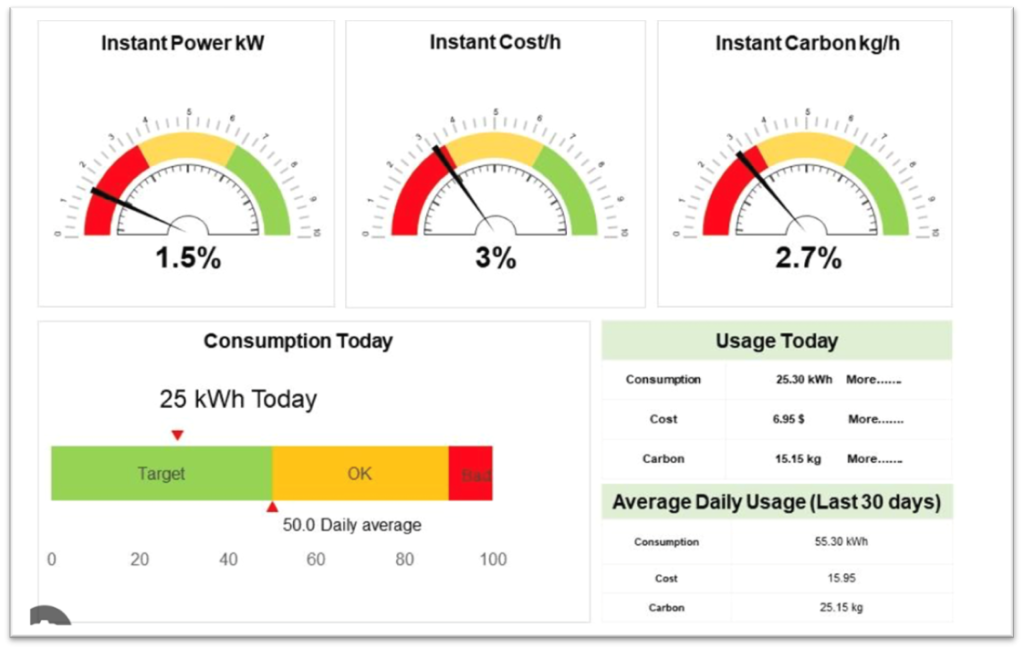
Real time KPI’s depend on rapidly updating data that comes from a trusted source. Errors in the data (sensors malfunction, meters freeze) can create misleading information on the dashboard. As such, real time dashboards need to detect potential errors in the data and reflect this to the user.
Infographics
Infographic dashboards provide more specific information over time and are more useful for annual reports and management reporting (e.g. total emissions reduced this year, total costs saved this quarter). But these are harder to read and are less interesting for the general public / customers.
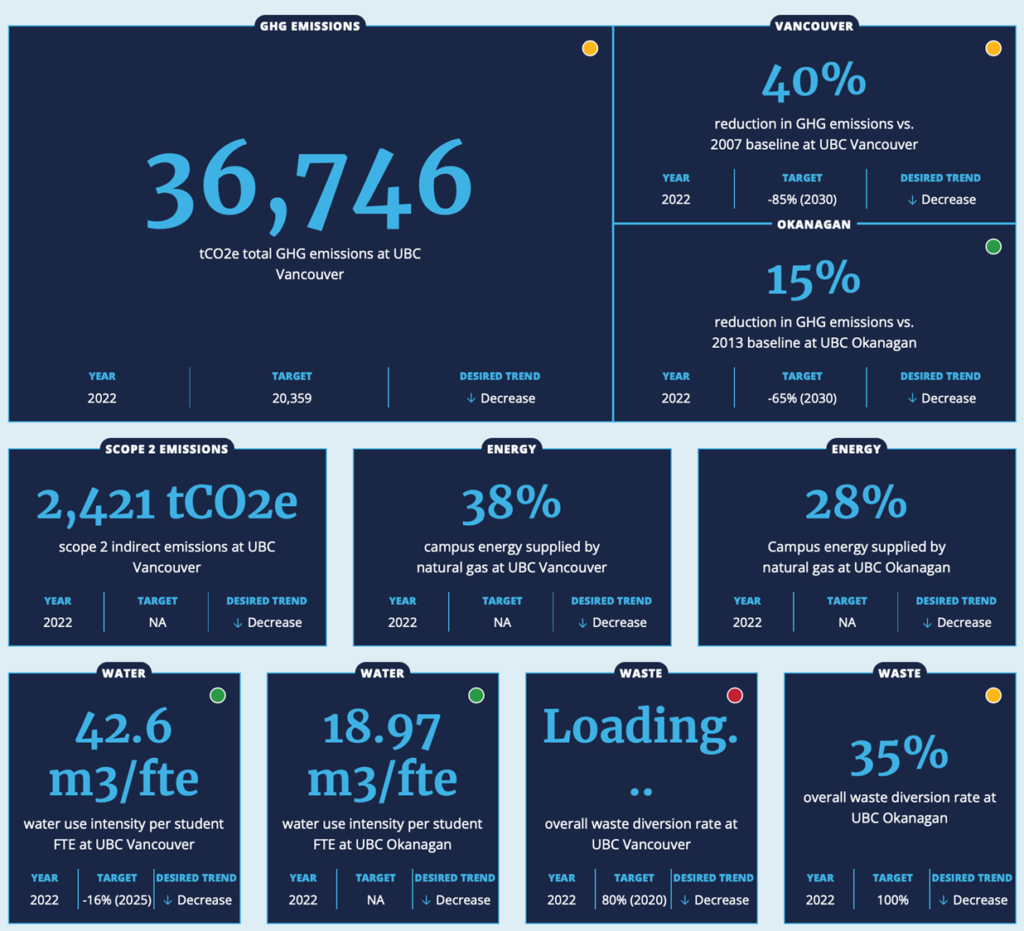
Infographics style KPI’s are less susceptible to short term errors in the data.
Achievement Based
Achievement based KPI’s are better suited for customers and the general public that are interested in the success of the energy and sustainability efforts when making a purchasing decision. For example, as the demographics for guests at hotel/resorts is shifting from the boomers (who are more interested in experience and comfort and less interested in emissions savings) to a younger demographic (who are more interested in sustainability), those resorts that demonstrate lower emissions profiles have enjoyed more than 50% increase in bookings. In fact, there are resorts in the Caribbean that have been so successful at reducing emissions, they are promoting a net zero offering that takes into account the emissions from air travel.
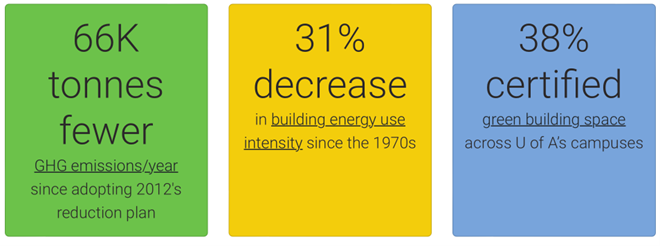
Historical Trend KPI’s
A historical trend approach to the KPI’s demonstrates progress against the corporate objectives. While this might be of interest to internal stakeholders, this approach takes more time to digest and is of less interest to the customers / public.
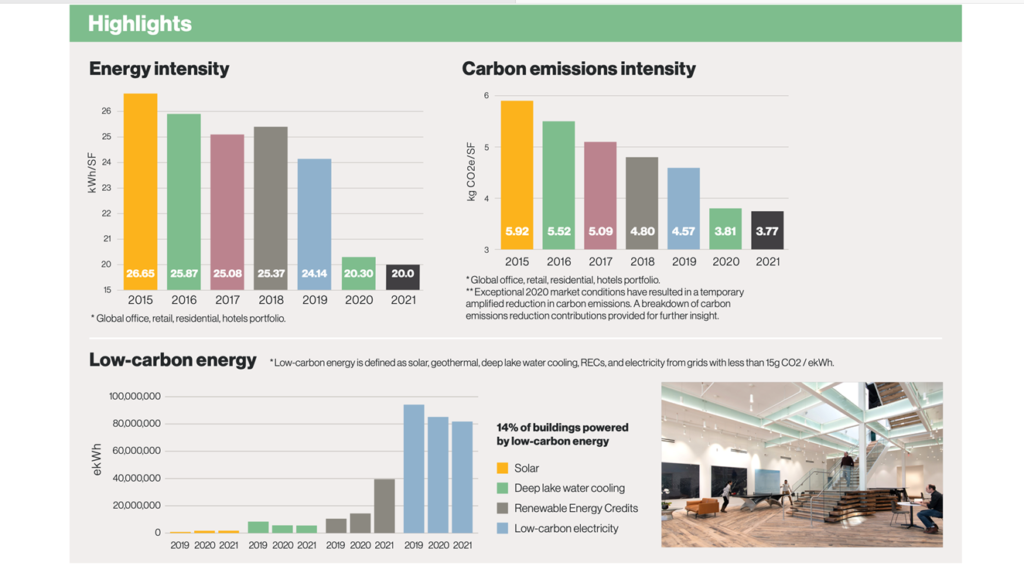
The public facing KPI’s are arguably the most important to the business as they speak directly to the customers. Particular care to identify what this stakeholder group are interested in seeing is very important to the KPI / dashboard design.
Surfacing the KPI’s
Once the KPI’s are selected, the next step is to decide how these will be surfaced to the stakeholder groups.
Public facing dashboards need to be integrated into the websites / point of purchase. When the public is making a purchasing decision, these dashboards can provide the motivation to complete the purchase / booking. Further, these dashboards can be published in social media to attract traffic to a purchasing decision.
Real time dashboards are more focused on internal stakeholders and can be surfaced on internal intranets that are not visible to the external stakeholders. Many dashboard hosting solutions can also support alerts, where the operations teams are notified to certain conditions that need attention.

Case Study: CHP Operations in High Density Residential
A high density affordable residential complex in Alberta Canada implemented a series of CHP’s to reduce the costs for heat and power.
The dashboard monitors the hourly Alberta electricity rates and makes a recommendation to turn on/off the CHP’s with the goal to minimize costs.
The dashboard shows the real time grid and CHP electricity generation as well as a historical trend. This demonstrates the effectiveness of the CHP solution to operate when the Alberta grid rates are very high and turn off when the grid rates are low.
The dashboard also shows the costs saved over the past 30 days, and the emissions reduced.
This dashboard is used both internally as well as for the tenants in the building.
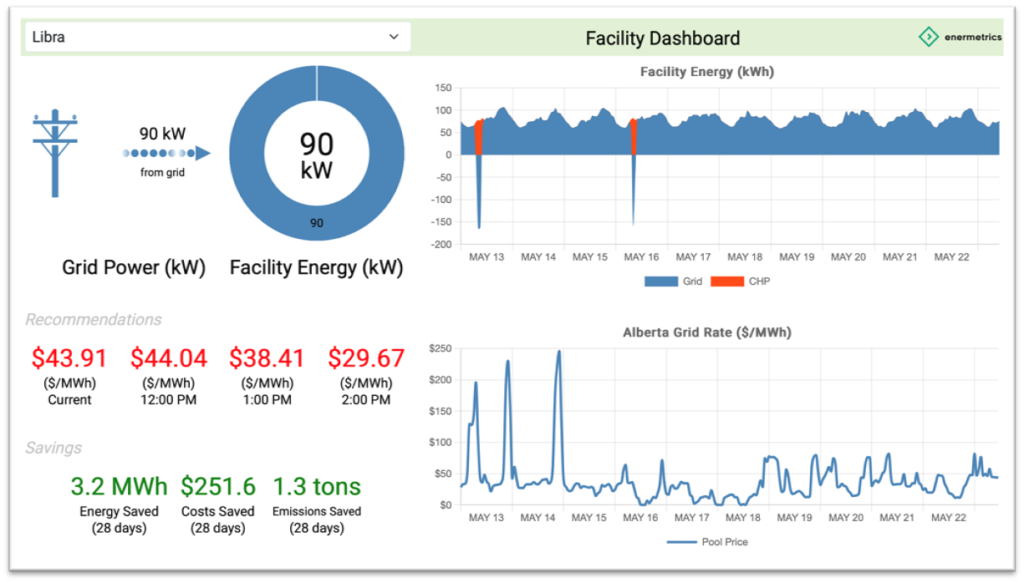
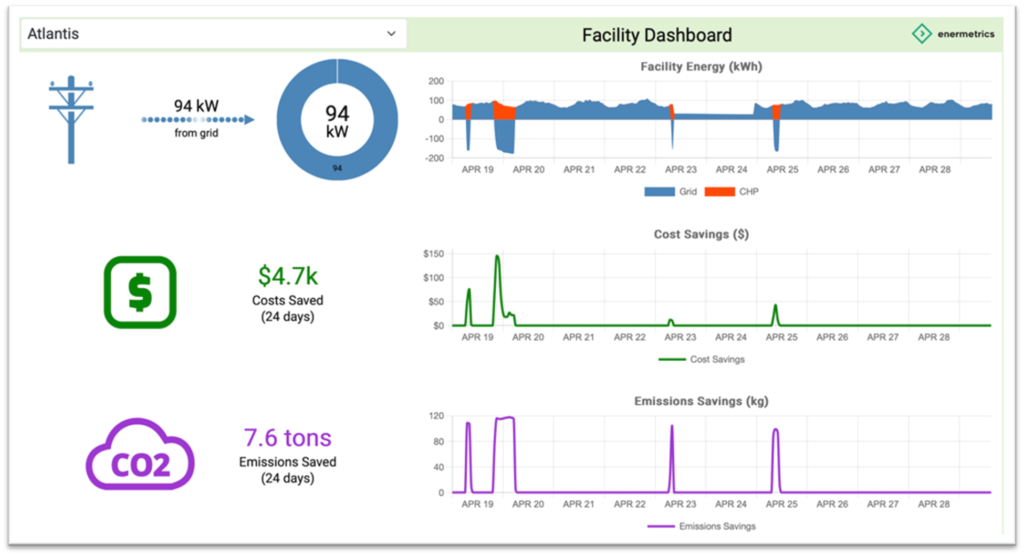

Exercise 1.11: Design the KPI’s
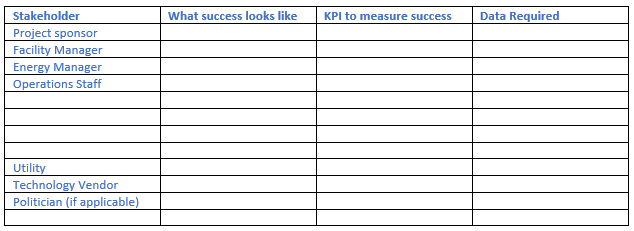

Course Manual 12: Risk KPI’s
A corporation can use a risk management plan to prepare for a variety of scenarios that could arise. Through the prevention or management of risks that may or may not materialize, risk management can assist a business in preserving its success or improving its operations. You may measure some components of risk with key performance indicators to see if your risk management plan is working.
Key performance indicators, or KPIs, are measures used in risk management that evaluate business hazards. KPIs assess the essential components of a business that it requires in order to successfully accomplish its goals. Their main job is to keep an eye on business plans and operations and assess how well they’re working so you can judge how successful and efficient they are. Key performance indicators are metrics that a corporation can create to measure success, enhance performance, and direct decision-making. KPIs include:
• Qualitative: This kind of KPI makes use of arbitrary elements like client satisfaction.
• Quantitative: A KPI of this kind makes use of objective statistics, such as percentages.
• Leading indicator: Because of particular circumstances, leading indicators fluctuate predictably.
• A lagging indicator is information about a change that becomes apparent after it has already happened.
• Input: The resources consumed are measured by this kind of KPI.
• Output: The outcome of a procedure or action is measured by this KPI.
• Process: The effectiveness of a specific task is gauged by this KPI.
The process of recognizing, analyzing, and mitigating risks to a business before or after they materialize is known as risk management. Natural disasters, weather-related incidents, legal or financial problems, and strategic management mistakes can all be threats. Companies frequently divide risk into three groups:
• Business: Anything that could jeopardize an organization’s performance or capacity to meet its financial targets, such shifting consumer preferences for particular products, falls under this category of risk.
• Non-business: Organizations frequently view this kind of risk as coming from outside their control, like politics.
• Financial risk: When an organization takes on a financial risk, such lending money or making an investment, it’s possible that it could lose money.
Business Risk Factors
Understanding the changing demographics and preferences of your customers is key to managing your business risk. For example, failing to recognize the shift in demographics in hotel/resorts from boomers to millennials, and the resulting shift in what they value, can result in negative impacts on your business.
For example, failing to recognize what damage could occur following a power failure of days duration might result in significant loss of inventory.
Non-Business Risk Factors
External risk KPI’s are the most difficult to quantify. These measure how different external risk factors will impact the normal business operations. If these risk KPI’s are increasing, an adaptation or mitigation plan may be required. If these risk factors are decreasing, does it mean we can adjust capital projects that were planned to address these factors?
Examples of external risk factors depend on location and type of business, but may include:
• Fire
• Flood
• High temperatures
• Storms
• Drought
Data to support these risk KPI’s is difficult to access, but there are consultancies that publish current state and future outlook for a variety of factors. An example of such as service is offered by CREtelligent. This service aggregates climate models from a variety of vetted sources to provide metrics on the changes in key climate risk factors. The result is a rating from 0-100 that measures how resilient a property is to climate change over the next 5-30 years. An example of such a report can be found here.
Risk KPI’s will be of interest to property management as they make decisions to invest in mitigation or adaptation plans.
Risk KPI’s will also be of interest to facility owners and insurance companies who depend on property management to provide an assessment of the external risk factors and their plans to address these factors.
Financial Risk Factors
With any energy and sustainability investment, there is an inherent financial risk. When assessing the financial value of an investment, we make assumptions on the future cost of energy which may not be correct. To address this, the IGS must provide a Monti-Carlo style analysis to demonstrate the sensitivity to external risk factors on the financial metrics of an investment.
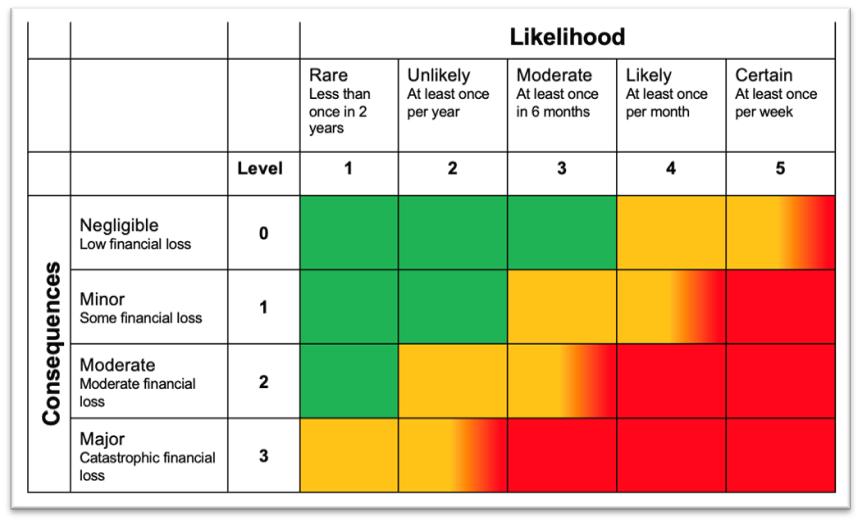
Here are some suggestions for KPI’s that can be used for risk management.
1. Hazards you are aware of in advance
The risks that you have already identified, anticipated, and have a plan in place to address are known as identified risks. These hazards don’t always materialize, and once you’ve recognized them, you can take steps to stop issues before they arise. When risk is recognized early on, it might be easier for a company to develop plans to either eliminate it altogether or lessen its effects if it does arise. Long-term risk reduction may result in fewer hazards being recognized.
2. Real risks that occur
The risks you have listed as real are those that do occur. For instance, a real risk for a coffee business could be a late delivery from the supplier of their cups. There may be a backup plan in place in your risk reduction strategy for real hazards that materialize. For example, a coffee shop that receives its cups late may already know where to get more fast or may be able to get in touch with a backup source.
3. Unknown and unforeseen risks
You can plan for and make preparations for these kinds of dangers even though you are unaware of them or don’t expect them to happen. Sometimes a danger is impossible to detect because it is contingent upon progress or time, or it arises as a result of your reaction to another risk. An undiscovered risk could be a shift in technology that has an impact on how a product is made by a manufacturer. These risks, which are often referred to as known unknowns, can be managed by creating a pre-established strategy to address any risk.
4. The likelihood of the risk occurring
This represents the frequency of a danger or risks. Even if your risk reduction plan is designed to minimize risks, they can nonetheless occur. You can reduce the likelihood of the risk by having a well-thought-out plan. To ensure it has fewer problems, a coffee shop that receives vendor deliveries late can choose to purchase its supplies directly from the manufacturer rather than via a third party.
5. The degree of risk to your company
This demonstrates how serious or detrimental the dangers are to your company. The personnel and resources you would need to manage the risk are generally part of your risk management plan. You might need to use more time or people if the risk is higher. Depending on the risk, an efficient risk reduction plan can assist you in allocating the right number of resources.
6. Expenses to your company resulting from a risk
These are expenses incurred by your company as a result of the risk. An affordable risk management process or solution is useful when a risk materializes.
7. How quickly and well you can solve problems
This demonstrates how quickly and well you can address real risks. Your preparations for risk reduction or mitigation might demonstrate your and your company’s readiness to manage a specific risk. You can determine the effectiveness of your risk management if your risk-reduction strategy works as intended.

Exercise 1.12: Identify External Risk factors
• How did these events impact your business?
• Did you have mitigation plans in place?
• What was the financial impact of these events?
• Do you see these events increasing in frequency or intensity?

Project Studies
Project Study (Part 1) – Customer Service
The Head of this Department is to provide a detailed report relating to the Objectives and KPI’s process that has been implemented within their department, together with all key stakeholders, as a result of conducting this workshop, incorporating process: planning; development; implementation; management; and review. Your process should feature the following 12 parts:
01. Objectives and KPI’s
02. Investment Grade Strategy
03. IGS Overview
04. IGS Canvas
05. Goals and Constraints
06. Cost Reduction Goal
07. Emissions Reduction Goal
08. Energy Security Goal
09. Objectives Ranking
10. Who Cares?
11. KPI Design
12. Risk KPI’s
Please include the results of the initial evaluation and assessment.
Project Study (Part 2) – E-Business
The Head of this Department is to provide a detailed report relating to the Objectives and KPI’s process that has been implemented within their department, together with all key stakeholders, as a result of conducting this workshop, incorporating process: planning; development; implementation; management; and review. Your process should feature the following 12 parts:
01. Objectives and KPI’s
02. Investment Grade Strategy
03. IGS Overview
04. IGS Canvas
05. Goals and Constraints
06. Cost Reduction Goal
07. Emissions Reduction Goal
08. Energy Security Goal
09. Objectives Ranking
10. Who Cares?
11. KPI Design
12. Risk KPI’s
Please include the results of the initial evaluation and assessment.
Project Study (Part 3) – Finance
The Head of this Department is to provide a detailed report relating to the Objectives and KPI’s process that has been implemented within their department, together with all key stakeholders, as a result of conducting this workshop, incorporating process: planning; development; implementation; management; and review. Your process should feature the following 12 parts:
01. Objectives and KPI’s
02. Investment Grade Strategy
03. IGS Overview
04. IGS Canvas
05. Goals and Constraints
06. Cost Reduction Goal
07. Emissions Reduction Goal
08. Energy Security Goal
09. Objectives Ranking
10. Who Cares?
11. KPI Design
12. Risk KPI’s
Please include the results of the initial evaluation and assessment.
Project Study (Part 4) – Globalization
The Head of this Department is to provide a detailed report relating to the Objectives and KPI’s process that has been implemented within their department, together with all key stakeholders, as a result of conducting this workshop, incorporating process: planning; development; implementation; management; and review. Your process should feature the following 12 parts:
01. Objectives and KPI’s
02. Investment Grade Strategy
03. IGS Overview
04. IGS Canvas
05. Goals and Constraints
06. Cost Reduction Goal
07. Emissions Reduction Goal
08. Energy Security Goal
09. Objectives Ranking
10. Who Cares?
11. KPI Design
12. Risk KPI’s
Please include the results of the initial evaluation and assessment.
Project Study (Part 5) – Human Resources
The Head of this Department is to provide a detailed report relating to the Objectives and KPI’s process that has been implemented within their department, together with all key stakeholders, as a result of conducting this workshop, incorporating process: planning; development; implementation; management; and review. Your process should feature the following 12 parts:
01. Objectives and KPI’s
02. Investment Grade Strategy
03. IGS Overview
04. IGS Canvas
05. Goals and Constraints
06. Cost Reduction Goal
07. Emissions Reduction Goal
08. Energy Security Goal
09. Objectives Ranking
10. Who Cares?
11. KPI Design
12. Risk KPI’s
Please include the results of the initial evaluation and assessment.
Project Study (Part 6) – Information Technology
The Head of this Department is to provide a detailed report relating to the Objectives and KPI’s process that has been implemented within their department, together with all key stakeholders, as a result of conducting this workshop, incorporating process: planning; development; implementation; management; and review. Your process should feature the following 12 parts:
01. Objectives and KPI’s
02. Investment Grade Strategy
03. IGS Overview
04. IGS Canvas
05. Goals and Constraints
06. Cost Reduction Goal
07. Emissions Reduction Goal
08. Energy Security Goal
09. Objectives Ranking
10. Who Cares?
11. KPI Design
12. Risk KPI’s
Please include the results of the initial evaluation and assessment.
Project Study (Part 7) – Legal
The Head of this Department is to provide a detailed report relating to the Objectives and KPI’s process that has been implemented within their department, together with all key stakeholders, as a result of conducting this workshop, incorporating process: planning; development; implementation; management; and review. Your process should feature the following 12 parts:
01. Objectives and KPI’s
02. Investment Grade Strategy
03. IGS Overview
04. IGS Canvas
05. Goals and Constraints
06. Cost Reduction Goal
07. Emissions Reduction Goal
08. Energy Security Goal
09. Objectives Ranking
10. Who Cares?
11. KPI Design
12. Risk KPI’s
Please include the results of the initial evaluation and assessment.
Project Study (Part 8) – Management
The Head of this Department is to provide a detailed report relating to the Objectives and KPI’s process that has been implemented within their department, together with all key stakeholders, as a result of conducting this workshop, incorporating process: planning; development; implementation; management; and review. Your process should feature the following 12 parts:
01. Objectives and KPI’s
02. Investment Grade Strategy
03. IGS Overview
04. IGS Canvas
05. Goals and Constraints
06. Cost Reduction Goal
07. Emissions Reduction Goal
08. Energy Security Goal
09. Objectives Ranking
10. Who Cares?
11. KPI Design
12. Risk KPI’s
Please include the results of the initial evaluation and assessment.

Project Study (Part 9) – Marketing
The Head of this Department is to provide a detailed report relating to the Objectives and KPI’s process that has been implemented within their department, together with all key stakeholders, as a result of conducting this workshop, incorporating process: planning; development; implementation; management; and review. Your process should feature the following 12 parts:
01. Objectives and KPI’s
02. Investment Grade Strategy
03. IGS Overview
04. IGS Canvas
05. Goals and Constraints
06. Cost Reduction Goal
07. Emissions Reduction Goal
08. Energy Security Goal
09. Objectives Ranking
10. Who Cares?
11. KPI Design
12. Risk KPI’s
Please include the results of the initial evaluation and assessment.

Project Study (Part 10) – Production
The Head of this Department is to provide a detailed report relating to the Objectives and KPI’s process that has been implemented within their department, together with all key stakeholders, as a result of conducting this workshop, incorporating process: planning; development; implementation; management; and review. Your process should feature the following 12 parts:
01. Objectives and KPI’s
02. Investment Grade Strategy
03. IGS Overview
04. IGS Canvas
05. Goals and Constraints
06. Cost Reduction Goal
07. Emissions Reduction Goal
08. Energy Security Goal
09. Objectives Ranking
10. Who Cares?
11. KPI Design
12. Risk KPI’s
Please include the results of the initial evaluation and assessment.

Project Study (Part 11) – Logistics
The Head of this Department is to provide a detailed report relating to the Objectives and KPI’s process that has been implemented within their department, together with all key stakeholders, as a result of conducting this workshop, incorporating process: planning; development; implementation; management; and review. Your process should feature the following 12 parts:
01. Objectives and KPI’s
02. Investment Grade Strategy
03. IGS Overview
04. IGS Canvas
05. Goals and Constraints
06. Cost Reduction Goal
07. Emissions Reduction Goal
08. Energy Security Goal
09. Objectives Ranking
10. Who Cares?
11. KPI Design
12. Risk KPI’s
Please include the results of the initial evaluation and assessment.

Project Study (Part 12) – Education
The Head of this Department is to provide a detailed report relating to the Objectives and KPI’s process that has been implemented within their department, together with all key stakeholders, as a result of conducting this workshop, incorporating process: planning; development; implementation; management; and review. Your process should feature the following 12 parts:
01. Objectives and KPI’s
02. Investment Grade Strategy
03. IGS Overview
04. IGS Canvas
05. Goals and Constraints
06. Cost Reduction Goal
07. Emissions Reduction Goal
08. Energy Security Goal
09. Objectives Ranking
10. Who Cares?
11. KPI Design
12. Risk KPI’s
Please include the results of the initial evaluation and assessment.
Program Benefits
Management
- Energy efficiency
- Reduce waste
- Reduce consumption
- Reduce demand
- Onsite generation
- Optimize contracts
- Operations efficiency
- Fuel switching
- Deferred maintenance
- Modernize systems
Marketing
- NetZero Goals
- Energy reduction
- Low-carbon fuels
- Renewable energy
- Micro-grids
- Social responsibility
- Improved reputation
- Market demand
- Shareholder expectations
- Competitor analysis
Production
- Climate adaptation
- Operations continuity
- Loss prevention
- Guest expectations
- Life Safety
- Emergency shelters
- Energy cost reduction
- Emissions reduction
- Energy security
- Brand reputation
Client Telephone Conference (CTC)
If you have any questions or if you would like to arrange a Client Telephone Conference (CTC) to discuss this particular Unique Consulting Service Proposition (UCSP) in more detail, please CLICK HERE.





